TheKoreanGuide is a reader-supported site. Purchases made through links may earn a commission.

19 Famous Korean Foods in South Korea (Must Try)

Korean food is revered all over the world for the lasting impression it leaves on diners. And there is so much more to Korean cuisine than the quintessential Kimchi and Ramen .
For your trip to South Korea, we’ve compiled a list of 19 delicious must-try foods to give your tastebuds a treat. This includes gimbap, bulgogi, tteokbokki , japchae and many more.
In this article, we will guide you through the best of Korean cuisine that you can easily find on streets and in restaurants. Plus, we’ll let you know exactly what to expect when it comes to their flavors.
Here are the 19 famous Korean Foods you must try:
1) bibimbap / mixed rice with vegetables.
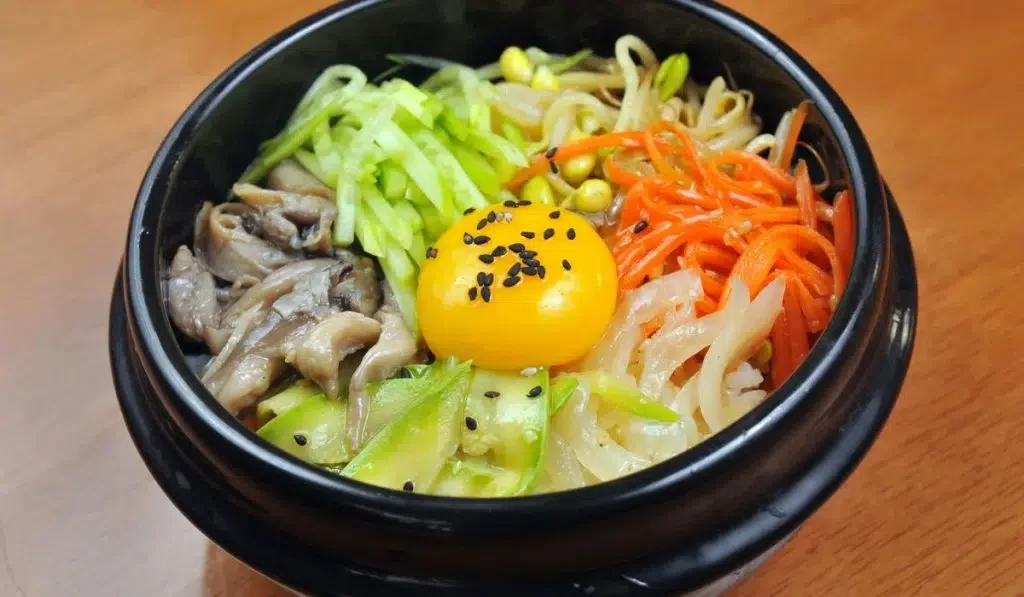
If you fancy a comforting food bowl, then Bibimbap will surely give you the ultimate satisfaction. This was originally a royal dish in the yesteryears which slowly made its way into Korean staple foods.
Bibimbap is a tasty mixture of rice, beef, vegetables tossed with gochujang (a hot red pepper paste) and soy sauce. Finally, it is topped with sesame seeds for some extra flavor.
Although chili paste is the most common seasoning used, people who prefer milder flavors usually opt for soy sauce instead.
2) Gimbap / Korean Seaweed Rice Rolls
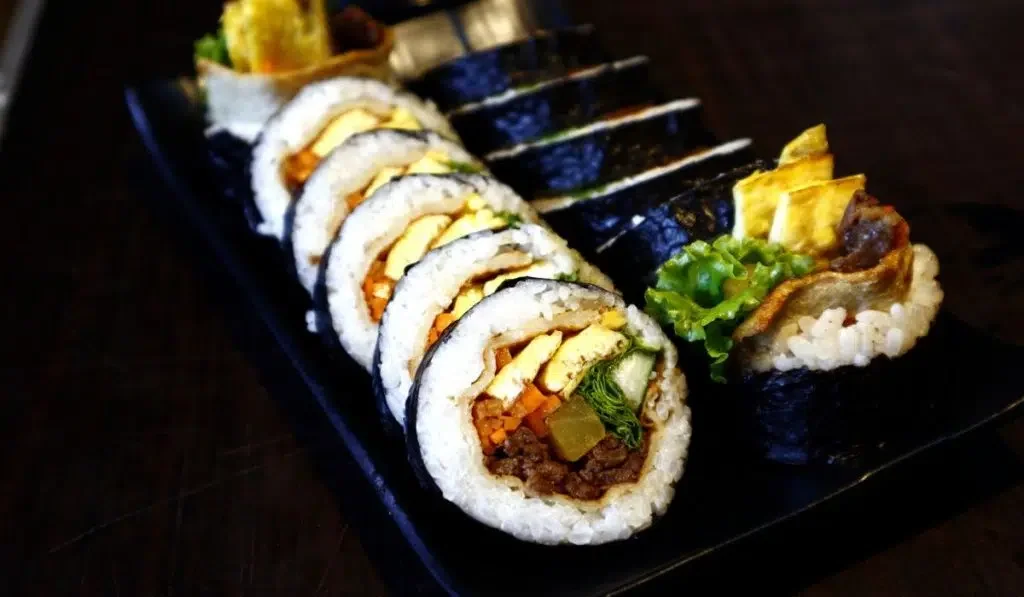
If you’re in South Korea , you really shouldn’t go back without giving gimbap a try. This nutritious and filling dish is easily available in street markets, food courts, as well as fine dining restaurants.
Essentially, gimbap is made from dried seaweed which is rolled up and filled with white rice and vegetables like carrots, spinach, radish, egg, and other seasonings. Then, it is cut into bite-sized pieces which make it a convenient meal for picnics or traveling.
The main filling of gimbap can vary. Tuna gimbap is another highly loved option, with a filling of mayonnaise, vegetables, canned tuna, and sesame leaves. You can also enjoy other variations with beef, kimchi, and cheese fillings.
3) Tteokbokki / Red Rice Cakes
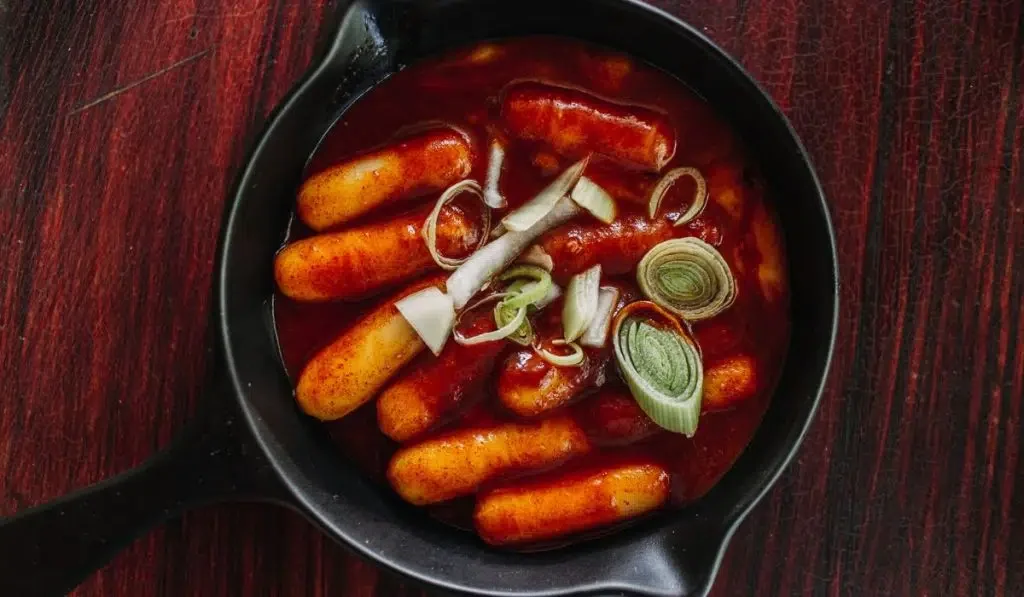
Anyone who knows about Korean culture has definitely heard about tteokbokki. This is a traditional street food that is highly treasured by Koreans for generations. It’s pretty easy to spot tteokbokki as it has a distinctly bright orange color.
Basically, tteokbokki is made from chewy, sweet rice and fish cakes . These slices of boiled rice cakes are combined with a special red chili and soybean paste. It is also tossed in onions, assorted vegetables, diced garlic, and other seasonings to elevate the flavor.
This scrumptious dish is an absolute must-try if you want to know more about Korean cuisine. You can easily find tteokbokki at street vendors and in many restaurants sprawled across South Korea.
4) Bulgogi / Marinated Beef Barbecue
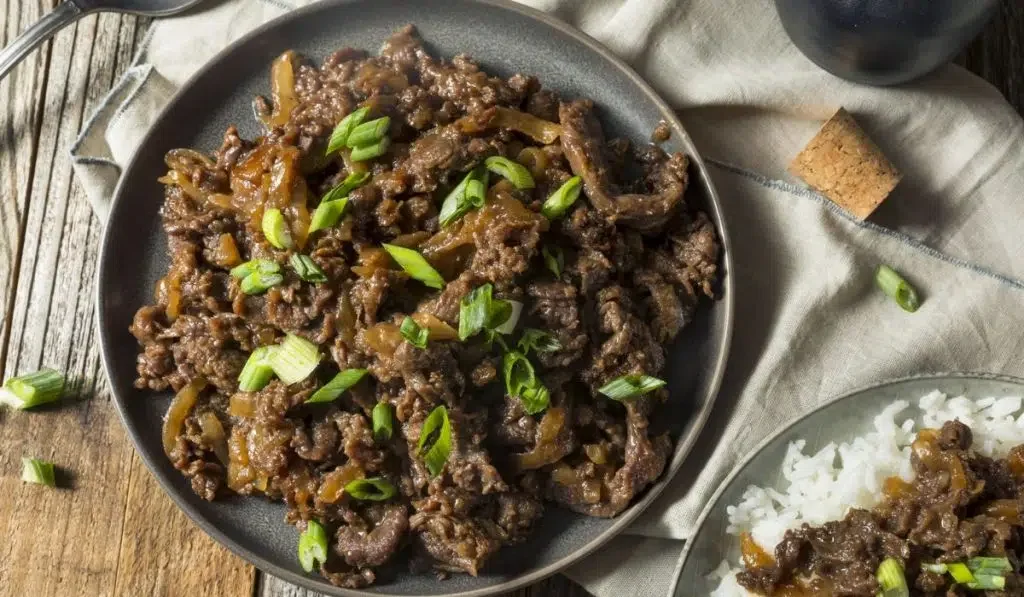
For meat lovers, bulgogi should be on top of their list of Korean foods to try. In fact, in 2011, CNN ranked bulgogi as the 23rd most delicious food in the world in its CNN Travel’s reader’s poll.
This savory and juicy dish consists of thinly sliced, grilled beef sirloin. It is cooked in soy sauce, black pepper, green peppers, onions, garlic, ginger, sugar, and sesame oil to make it tender and flavorful.
The dish is usually accompanied by a side of vegetables like spinach and lettuce. Koreans usually wrap up the sliced meat and spicy paste in the lettuce and then proceed to eat it.
5) Japchae / Stir-Fried Glass Noodles
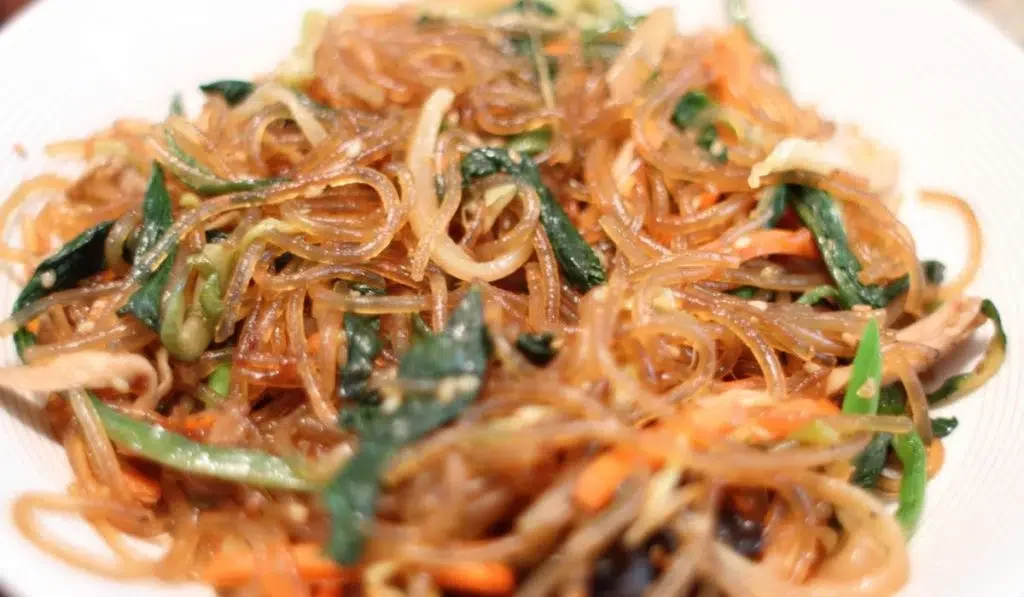
The famous glass noodles are another must-try for anyone visiting Korea . This is arguably one of the most popular noodle dishes in the country.
These glass noodles are typically made from sweet potatoes. Then, the noodles are stirred in sesame oil, mushrooms, assorted vegetables, and beef.
The best way to enjoy japchae is to use a spoon together with metal chopsticks while slurping the juicy noodles. In Korea, it’s not considered polite to keep the bowl too close to your mouth while eating.
6) Kimchi / Spicy Fermented Vegetables
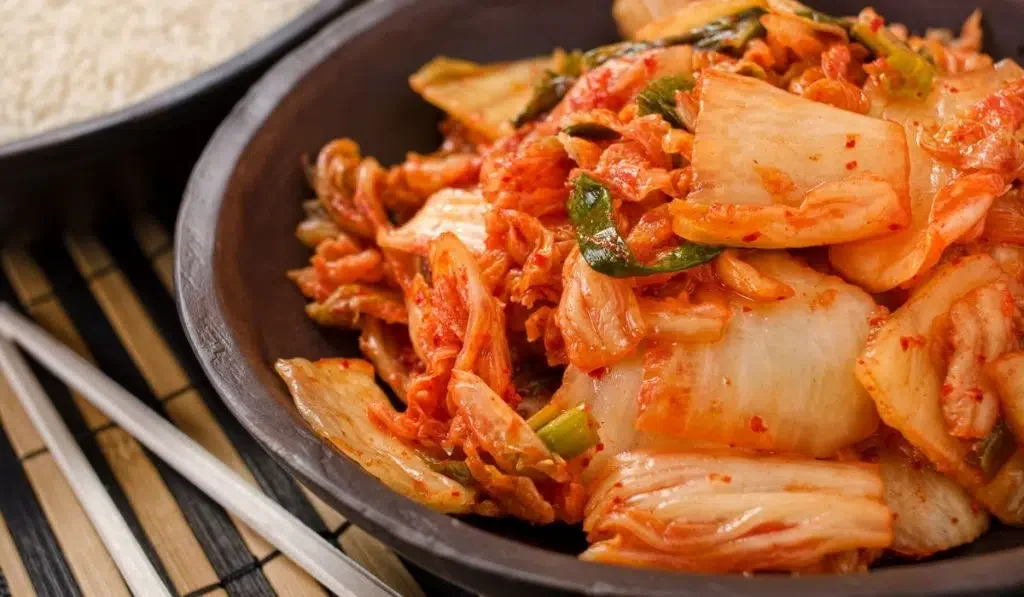
Kimchi is one term almost everyone has heard when Korean food is mentioned.
It is basically a crunchy salad made with assorted, fermented vegetables. Cabbage is the base ingredient of this salad but it is packed with flavor as a spicy paste, crushed garlic, and minced ginger are also added.
The best part is that kimchi is also quite healthy. It has a high amount of fiber and is low on calories. This side dish is an important part of most Korean dining experiences.
7) Jajangmyeon

A fusion of Korean and Chinese cuisine, jajangmyeon is made from thick, wheat noodles that are handmade. The noodles are then topped with savory black soybean paste, cucumber slices, and assorted veggies. Diced pork is also an important addition to this comforting dish.
Jajangmyeon is a hearty noodle dish and most Koreans absolutely love it. It is also very affordable with a starting price of 5,000 won. If you’re looking for a quick, budget-friendly meal, you can count on jajangmyeon anytime.
8) Ramyun / Korean Instant Noodles

Ramyun is a hugely popular instant noodle that has made waves not just in Korea, but all across the globe. With economical prices, a variety of flavors, and an amazing texture, this is one of the best dishes in Korean cuisine.
Korean instant noodles are becoming increasingly popular everywhere. They are usually enjoyed with lots of broth, a fried egg, and cheddar cheese on top.
9) Korean Fried Chicken
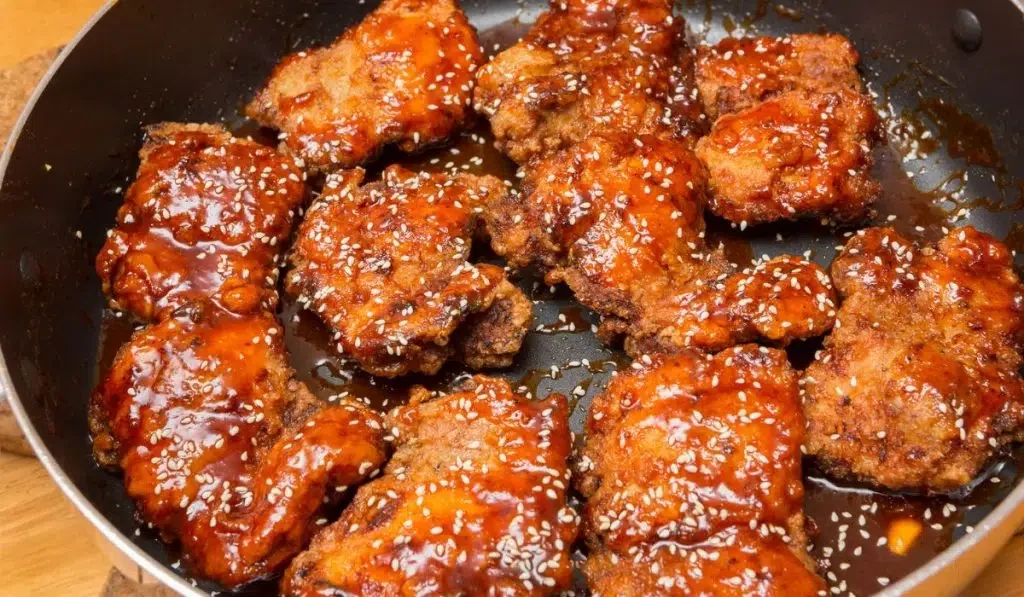
If you want to try out American fast food with its own twist, Korean fried chicken is the dish for you.
The chicken is coated all over with a sweet, spicy sauce and sometimes green pepper is added to the batter too. Then, it is double fried to give it a crunchy bite which makes it absolutely delicious. The meat of Korean fried chicken is as juicy and succulent as it gets.
This is one snack that will have you licking your fingers. It is typically enjoyed with beer and you can easily find places serving this popular combination in South Korea.
10) Nakji Bokkeum / Korean Spicy Stir-fried Octopus
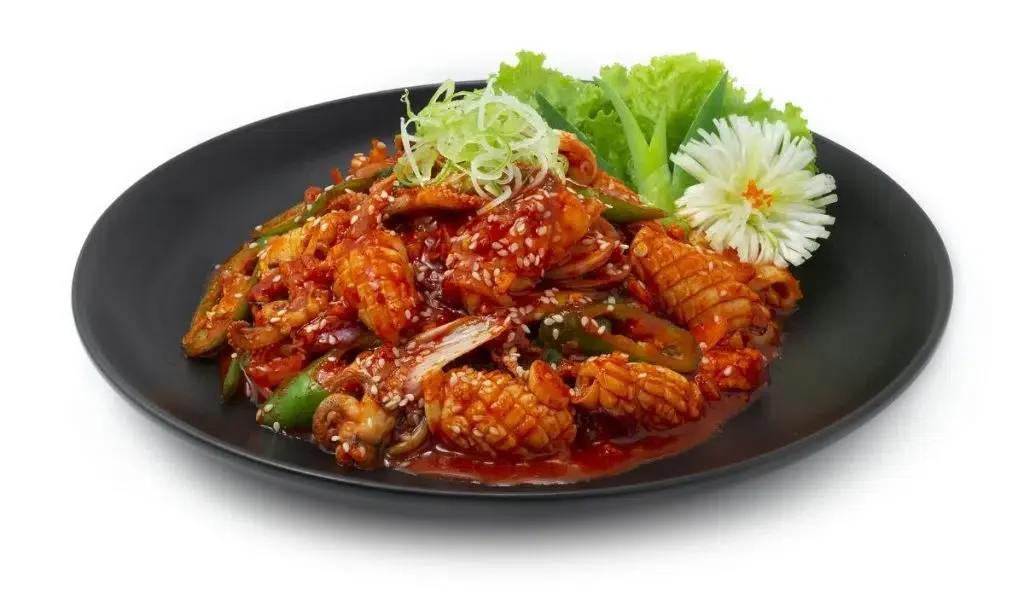
Back in the 19th century, Koreans loved eating raw or fried squid. During this era, Najki Bokkeum was also born.
Squid lovers would surely enjoy this delicious dish made with stir-fried octopus bathed in a delectable caramel sauce. Nakji Bokkeum oozes flavor and leaves you wanting more.
Ideally, the squid should be soft yet chewy and balanced with assorted vegetables. It is often served spicy as chefs season it with chili pepper, powder, and paste to create an explosion of flavors. If you don’t like very spicy foods, you can have it with boiled bean sprouts to reduce the heat.
It is most commonly eaten with rice which is served separately as a side. Some restaurants will also cook the nakji bokkeum in front of you on the table.
11) Hotteok / Korean Sweet Pancakes
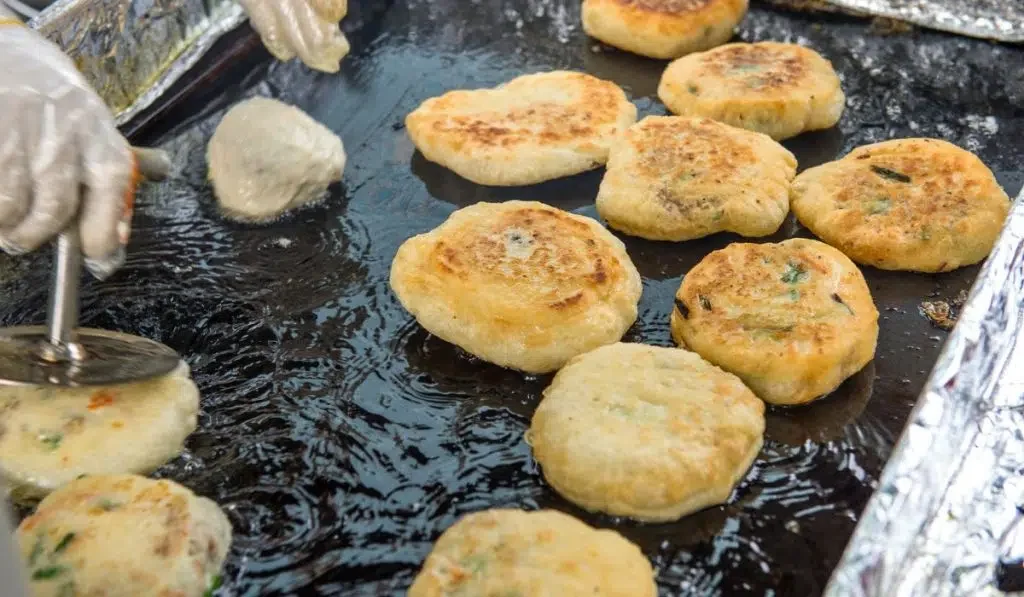
Almost everyone knows how yummy pancakes are. But what about the Korean version of sweet pancakes known as hotteok? This is a popular street snack in the country and is widely available everywhere.
The batter is made using flour, and then the pancakes are filled with mouthwatering syrup. This syrup is usually made with brown sugar, cinnamon, and peanuts.
Right off the grill, the pancake is typically folded in a cardboard or paper cup. It is served super hot and fresh, so be careful before you take a bite of this syrup-filled sugary goodness. Plus, the softness of the fluffy pancake is on another level.
We recommend you to have hotteok with a warm cup of milk, especially in the chilly Korean weather.
12) Soondae / Korean Sausage
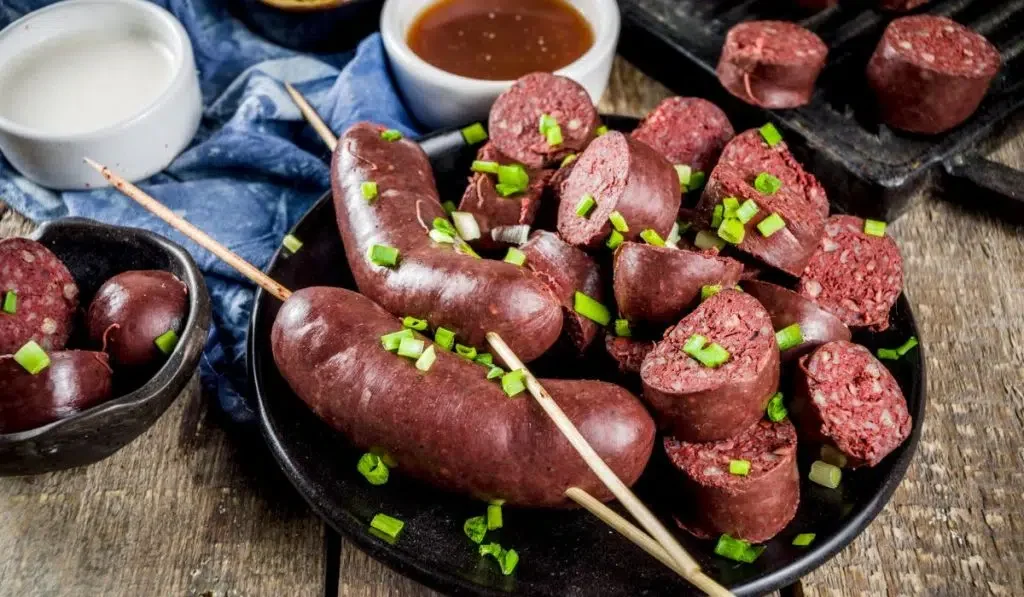
Soondae is also worth a try for tourists who are looking for meaty food options. Basically, this is made from pig intestines that are stuffed with pig’s blood, vegetables, and dangmyeon (clear noodles).
You can enjoy soondae with a variety of dipping sauces. The usual sauce mostly varies from region to region.
For instance, it is mostly served with salt in Seoul, Gyeonggi. If you’re in Busan or Ulsan, you will probably get ssamjang sauce to go with it. In Jeolla and Chungcheong, it is usually enjoyed with shrimp sauce and chojang sauce.
13) Odeng / Fish Cake
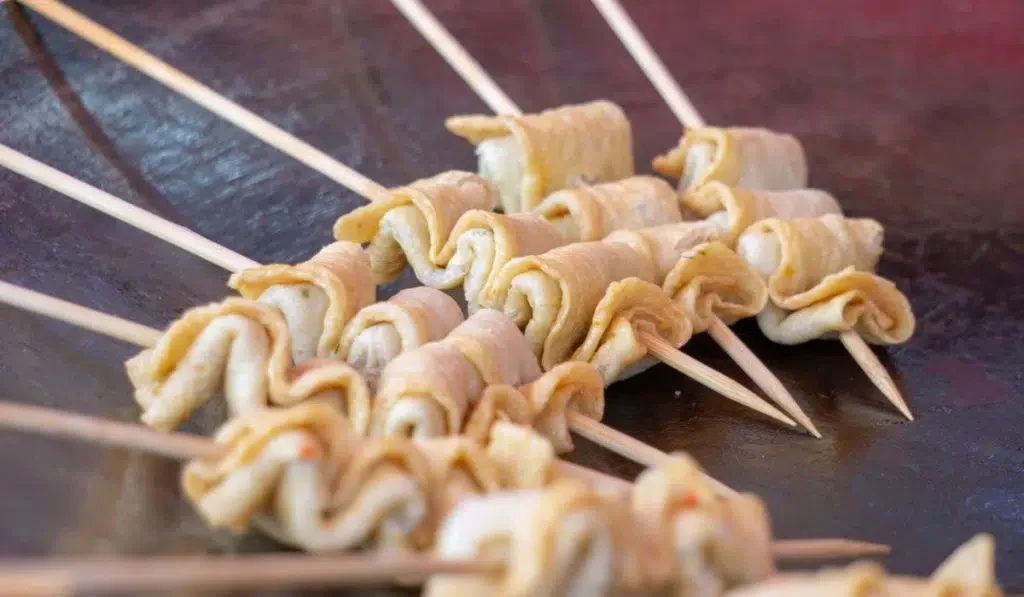
This famous fish cake, known as Odeng, was actually named after Japanese Oden stew. This dish came into being during 1910 to 1945 when Japan took over Korea. So, a number of Korean dishes were inspired by Japanese cuisine during this period.
If you’re on the hunt for delicious street food, Odeng is one of the snacks you should try without hesitating. It is a unique taste and experience for many tourists and is usually appreciated by them.
The fish cake should ideally be tender and chewy, and it becomes even better when drenched in a zingy broth. You can either dip the fish cake in the broth before taking a bite or take a sip of the broth later. Either way, it’s a combination you will never forget.
14) Seolleongtang / Ox Bone Soup
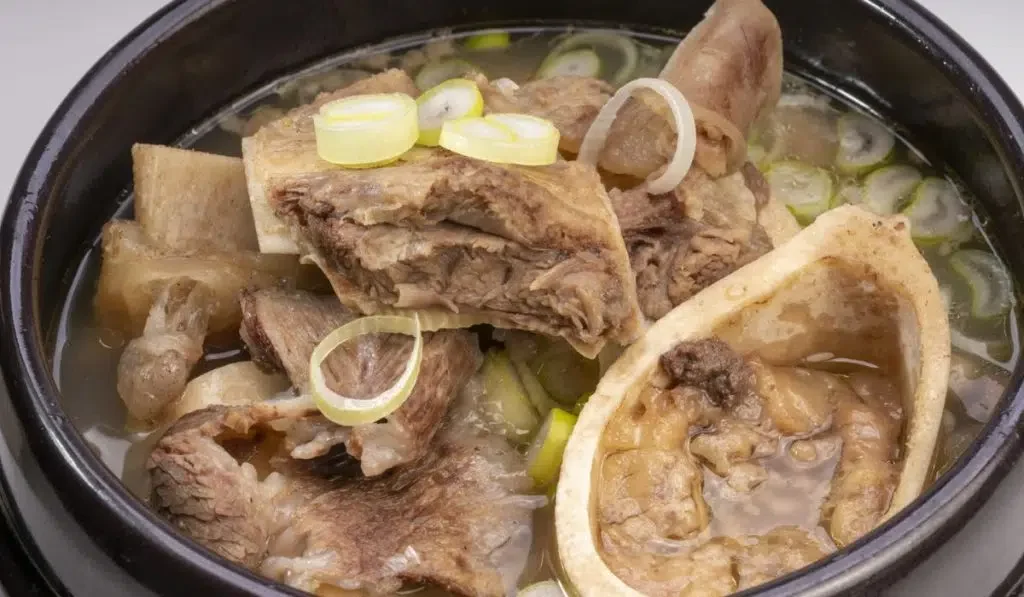
Ox bone soup or Seolleongtang is a household favorite in South Korea. It is especially popular in the winters and is highly adored as comfort food.
The beef bones and ox bones are boiled for hours to whip up this tasty soup. Then, it is seasoned with scallions, garlic, salt, and pepper. The soup is not only immensely flavorful, but it is also rich in proteins.
If you’re looking for a healthy snack during the winter season in Korea, make sure not to miss out on Seolleongtang.
15) Bibim Nengmyun / Spicy Cold Noodle
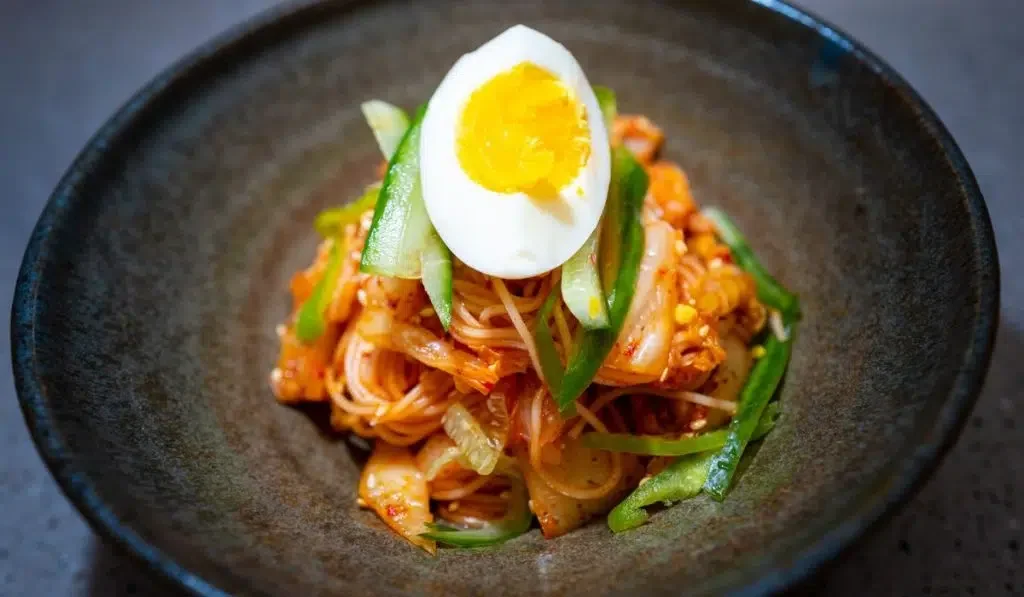
You probably know by now that Koreans really love noodles. And there are endless variations of noodles in the country.
Well, bibim nengmyun is a noodle dish served in a cold broth. It is also seasoned with cucumbers, boiled egg, pear slices, and cold slices of boiled beef. The noodles can be made from different ingredients like flour, buckwheat, sweet potatoes, seaweed or even green tea.
These spicy cold noodles are known for being super healthy. Traditionally, they are served without cutting, but you can always ask the diner to cut them for you first.
16) Ganjang Gejang / Raw Crabs Marinated in Soy Sauce
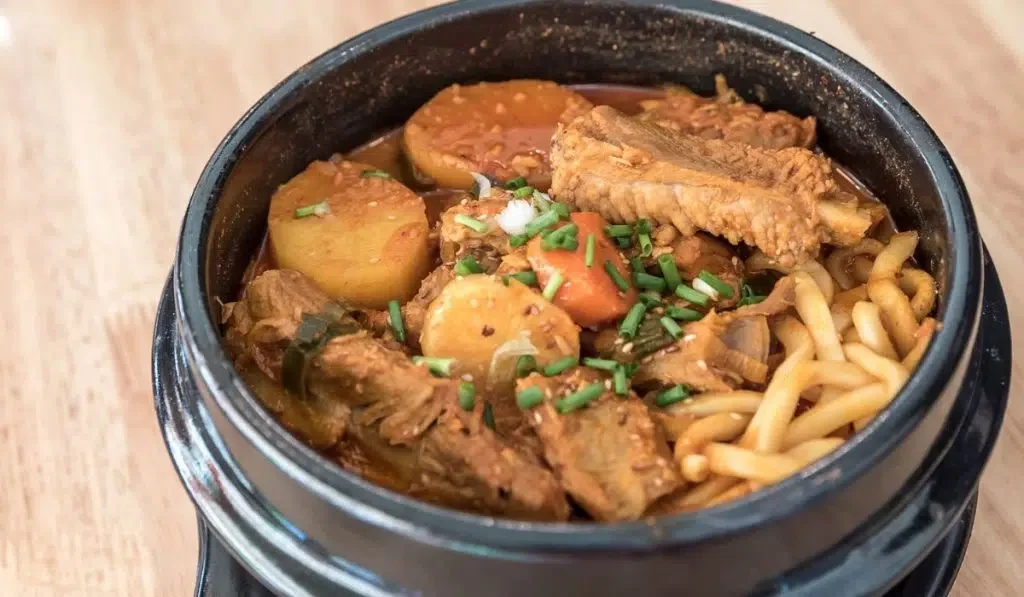
Crabs are a delight to eat for anyone who is fond of seafood. Ganjang gejang, also known as ‘bap-dodook’ is essentially raw crab covered in soy sauce.
Many people are hesitant while trying out this dish but it is a highly loved part of Korean cuisine.
17) Pajeon / Savory Pancake
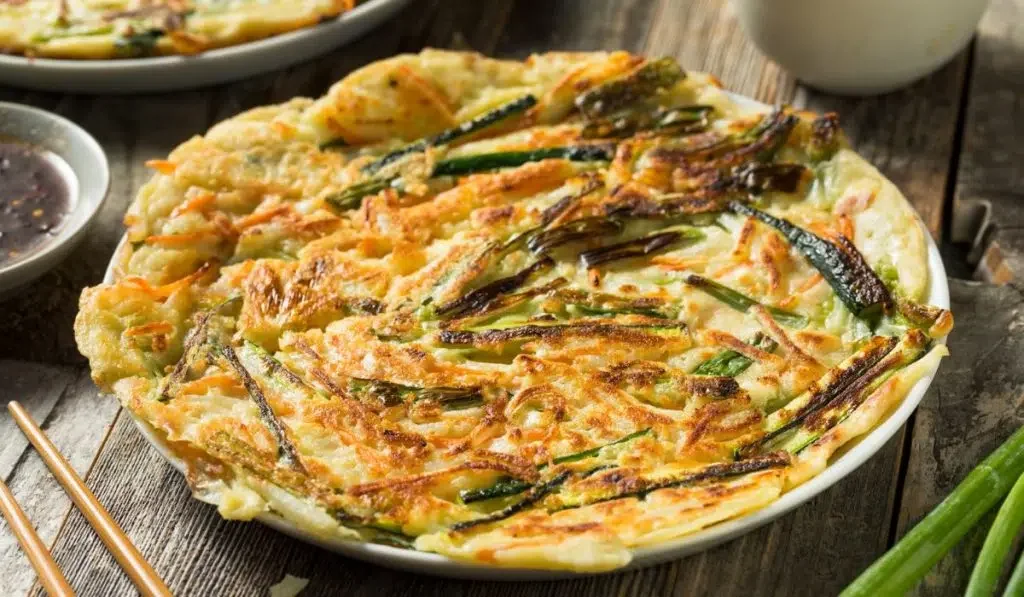
This addictive and famous pancake variation is a must-try in Korea. With a soft, delicious cake base, a combination of green onions and carrots, and a mouth-watering dipping sauce- there’s so much to love about pajeon.
The divine sauce is typically made from garlic, soy sauce, and honey. It really takes the flavor of the pancake up a notch and makes it irresistible.
Here’s a fun fact: The name Dongnae Pajeon was actually inspired by the Dongnaesung fortress from the Joseon Dynasty.
18) Sundubu Jjigae / Korean Spicy Soft Tofu Stew
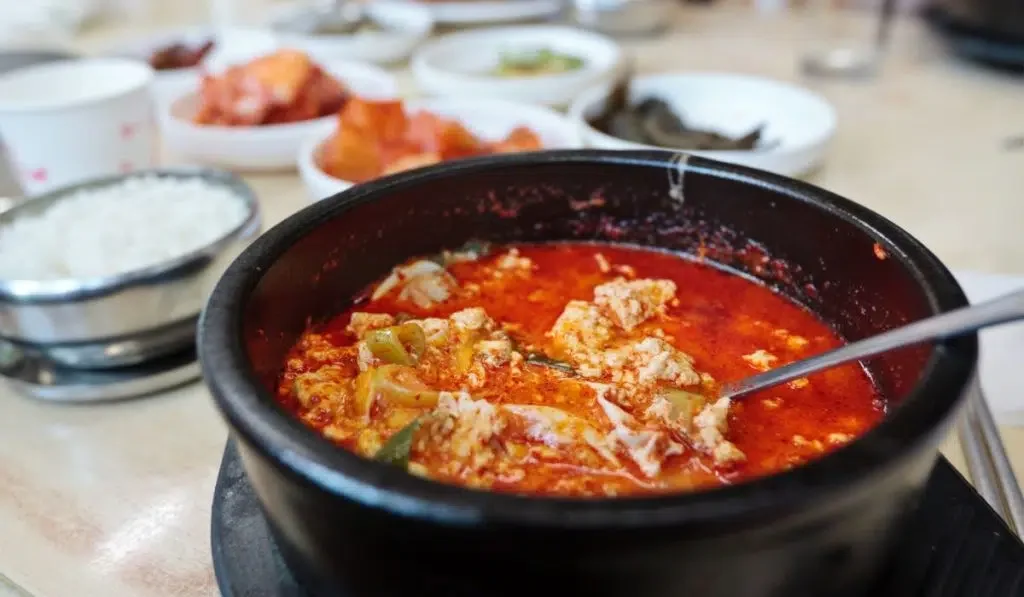
Tofu is another important part of Korean food culture. Sundubu jjigae is a form of unpressed, uncurdled tofu stew that is a huge favorite among the masses.
The classic version of this dish is made from plain tofu bathed in a broth and is called Chodang tofu. Sundubu jjigae is made in a richer, spicier broth with seasonings of red pepper powder and oil.
19) Gamjatang / Pork Back-Bone Soup
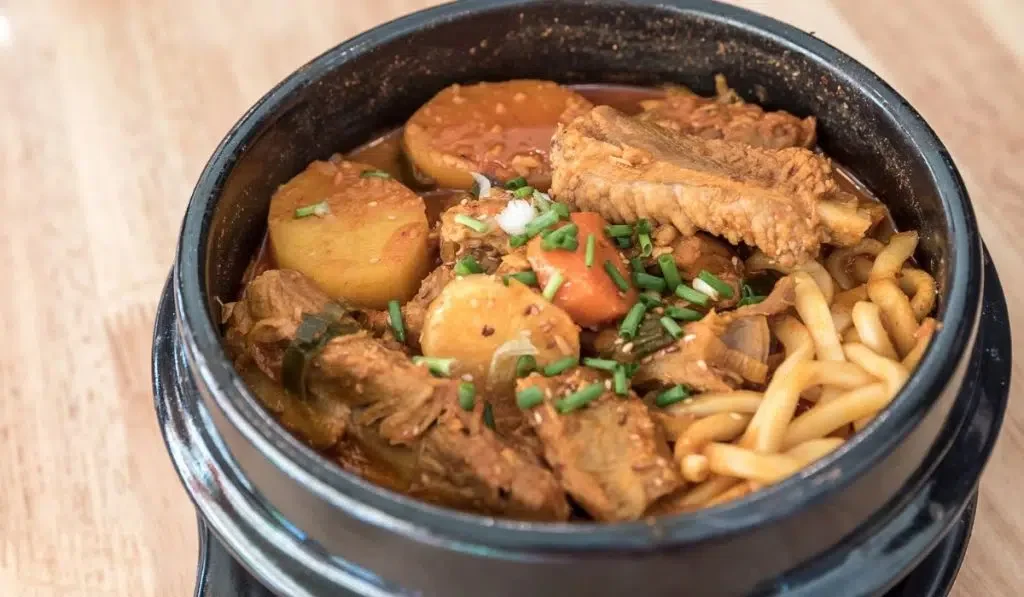
Made from pork backbone, Gamjatang is another fascinating soup dish in Korea. It is usually mixed with boiled potatoes and other vegetables, as well as perilla seeds.
So, what makes this dish so popular? It is known to cure a hangover immediately. So, places that serve gamjatang are usually open for 24 hours. You now know what you need after a night of heavy partying in South Korea.
Final Thoughts
If you’re on a food adventure, Korean food will surely take you on a ride. However, you should know it’s an acquired taste, so not everyone is able to appreciate it.
We recommend you to try all the delicious Korean dishes on this list if you can. The strong flavors and interesting textures of this cuisine offer an experience of its own kind.
Enjoy the article?
You'll love my daily email! Learn something new about South Korea every single day. It's completely free. <3
About The Author
You May Also Like

10 Best Korean Toners for Dry Skin (2024 Updated)

The 8 Best Korean Essences for Dry Skin (2024 Updated)

24 Best Korean Skincare Brands of All-Time

Is Korean Skincare Cheaper in Korea?

How Long Does It Take for Korean Skincare to Work?

Is Korean Skincare Similar to Japanese?

© 2024 TheKoreanGuide.com | As an Amazon Associate, I earn from qualifying purchases.
The Top South Korean Foods to Try

In recent years South Korea has become better known for its technology than its food. However, thanks to delicacies like kimchi, which has become a global sensation, things are beginning to change. Here are is a list of South Korean foods you have to try.
Interested in making some these dishes for yourself? Join Culture Trip’s 10-day small-group tour to South Korea and take a cooking masterclass with a local chef in Busan.
Hoeddeok (sweet syrupy pancakes)
Known as a sweeter version of the Western pancake, hoeddeok , or sometimes spelled as hotteok , is a popular Korean street food, especially during the winter season. It is essentially flat, circular dough that is filled with a mixture of cinnamon, honey, brown sugar, and small pieces of peanut and cooked on a griddle. The delicacy has crunchy exterior and soft interior as well as an irresistible flavor.
Bulgogi (marinated beef barbecue)

Become a Culture Tripper!
Sign up to our newsletter to save up to 500$ on our unique trips..
See privacy policy .

Samgyeopsal (pork strips)
One of the most popular Korean dishes in South Korea, samgyeopsal consists of grilled slices of pork belly meat that are not marinated or seasoned. They are commonly dipped in seasoning made of salt and pepper mixed in sesame seed oil, and then wrapped in lettuce along with grilled slices of garlic, grilled slices of onion, shredded green onions, and kimchi . It is one of the most common dishes found in any Korean restaurant throughout the world.
Japchae (stir-fried noodles)
Often served as a side dish during lunch or dinner, japchae is a traditional Korean noodle dish made up of stir-fried sweet potato, thinly shredded vegetables, beef, and a hint of soy sauce and sugar. Depending on the chef, additional ingredients like mushrooms are added to the mix. Japchae is known for its sweet and flavorful taste and its soft yet slightly chewy texture.
Kimchi (fermented vegetables)
One of the oldest and probably the most essential dishes in Korean cuisine, kimchi is a spicy and sour dish made up of fermented vegetables. It is prepared with various kinds of ingredients, but the most common main ingredient is cabbage. Kimchi is popular among foreigners for its unique flavor, as well as its high nutritional value, fiber content and low calorie content. However, for Koreans, it is most popular due to its significant cultural value. Without kimchi , dinner is considered incomplete.

Ddukbokki (spicy rice cake)
Ddukbokki , also spelled tteokbokki , is a common spicy Korean food made of cylindrical rice cakes, triangular fish cake, vegetables, and sweet red chili sauce. It is often sold by pojangmacha (street vendors). People enjoy ddeukbokki for the combination of spicy and sweet flavors.
Sundubu-jjigae (soft tofu stew)
Served in a large stone bowl, sundubu-jjigae is a common spicy Korean stew generally made of dubu (tofu), vegetables, mushrooms, seafood , beef or pork, and gochujang (chili paste). Depending on the chef and region, some ingredients are removed, substituted or added to the mix. Though different variations exist, traditionally, a raw egg is placed on top of the stew and mixed with the soup before serving to add additional flavor to the dish.
Bibimbap (mixed rice)
Bibimbap is essentially a bowl of mixed ingredients including, but not limited to, rice, namul (seasoned and sautéed vegetables), mushrooms, beef, soy sauce, gochujang (chili pepper paste), and a fried egg. The ingredients found in bibimbap vary by region, and the most famous versions of the dish are found in Jeonju, Tongyeong, and Jinju.

Seolleongtang (ox bone soup)
A traditional hot Korean soup made from ox bones, ox meat and briskets, seolleongtang is a local dish of Seoul, often seasoned with salt, ground black pepper, chopped green onions, or minced garlic according to the consumer’s taste. The broth is of a milky white, cloudy color and is often eaten with rice. Seolleongtang is known for its soft yet chewy texture and flavorful broth, and can be found in most Korean restaurants in Seoul .
Haemul Pajeon (seafood vegetable pancake)
A version of pajeon , which is a pancake-like Korean dish made predominantly with green onions, egg batter, wheat flour, and rice flour, haemul pajeon incorporates seafood to the common pancake. Common seafood ingredients used include, but are not limited to, oysters, shrimp, squid, and clams. Haemul pajeon is generally eaten as a main dish and is known for its soft and chewy texture as well as its mixture of seafood flavors.
Samgyetang (ginseng chicken soup)
A common dish particularly during the summer, samgyetang is a traditional soup made of chicken, garlic, rice, scallion, Korean jujube, Korean ginseng, and spices. It is known to have a high nutritional value. Not only is it known for its healthy contents but it also is popular simply for its creamy and meaty flavor.

Soondae (blood sausage)
Soondae , or sometimes spelled as sundae, is a unique Korean dish made of pig’s intestines stuffed with several ingredients such as noodles, pork blood, and barley. Versions of soondae differ in fillings and wrappings, and are often prepared differently according to the province or city in South Korea. Nevertheless, though the recipes differ, every soondae is chewy on the outside and soft and flavorful on the side, creating an interesting mix of textures as well as flavors.
Naengmyeon (cold buckwheat noodles)
Naengmyeon is a common cold Korean noodle dish that consists of long, thin noodles, cucumbers, slices of Korean pear, slices of beef and a hard-boiled egg. The noodles are often made of buckwheat, potatoes, and sweet potatoes, but can also be made of arrowroot and kudzu, depending on the type of naengmyeon. It is a popular dish especially during the summer to cool off under the scorching heat and thick humid air in South Korea.
Hobakjuk (pumpkin porridge)
A sweet and grainy dish, hobakjuk is a traditional Korean porridge made from steamed pumpkin and glutinous rice that has been soaked in water. Though its appearance is simple, it is extraordinarily sweet and flavorful due to the pumpkin. It is a popular meal during breakfast hours, and is often a perfect meal choice for people who are unwell and unable to consume heavy meals. It is served both hot and cold but is best when hot.
Discover more of our specially curated small-group trips around the world , and book your next adventure with Culture Trip.

KEEN TO EXPLORE THE WORLD?
Connect with like-minded people on our premium trips curated by local insiders and with care for the world
Since you are here, we would like to share our vision for the future of travel - and the direction Culture Trip is moving in.
Culture Trip launched in 2011 with a simple yet passionate mission: to inspire people to go beyond their boundaries and experience what makes a place, its people and its culture special and meaningful — and this is still in our DNA today. We are proud that, for more than a decade, millions like you have trusted our award-winning recommendations by people who deeply understand what makes certain places and communities so special.
Increasingly we believe the world needs more meaningful, real-life connections between curious travellers keen to explore the world in a more responsible way. That is why we have intensively curated a collection of premium small-group trips as an invitation to meet and connect with new, like-minded people for once-in-a-lifetime experiences in three categories: Culture Trips, Rail Trips and Private Trips. Our Trips are suitable for both solo travelers, couples and friends who want to explore the world together.
Culture Trips are deeply immersive 5 to 16 days itineraries, that combine authentic local experiences, exciting activities and 4-5* accommodation to look forward to at the end of each day. Our Rail Trips are our most planet-friendly itineraries that invite you to take the scenic route, relax whilst getting under the skin of a destination. Our Private Trips are fully tailored itineraries, curated by our Travel Experts specifically for you, your friends or your family.
We know that many of you worry about the environmental impact of travel and are looking for ways of expanding horizons in ways that do minimal harm - and may even bring benefits. We are committed to go as far as possible in curating our trips with care for the planet. That is why all of our trips are flightless in destination, fully carbon offset - and we have ambitious plans to be net zero in the very near future.

Food & Drink
Five dishes from around the world you should try with culture trip.

The Most Amazing Cooking Classes You Can Take With Culture Trip

Guides & Tips
The ultimate guide to travel in korea.

The Best Places to Travel in August with Culture Trip

Top Culinary Trips to Take in 2023

The Solo Traveller’s Guide to South Korea

See & Do
A guide to outdoor adventures across korea.

Places to Stay
The best hotels to book in south korea for every traveller.

Health & Wellness
7 dreamy detox destinations in south korea.

How Going on a Korean Templestay Will Help You Find Your True Self

Why Foodies Should Get to Know Korean Temple Cuisine

Understanding the Bangs of South Korea
- Post ID: 361350
- Sponsored? No
- View Payload
A local explains why South Korean food is the best in the world
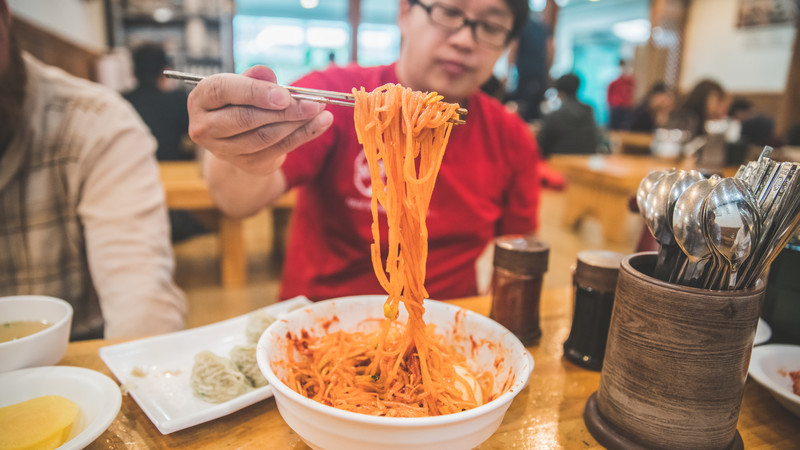
Korean cuisine has evolved far beyond kimchi, and that is one reason why it has created so much buzz around the world.
Michelin-starred chefs like Eric Ripert and Jean-George Vongerichten have been incorporating Korean techniques and ingredients into their menus. However – as a local food blogger – I feel that Korean cuisine doesn’t fare best in white-tablecloth atmospheres. Instead, it is more about sitting around a charcoal grill in the center of your table with your friends, having a drink and jovially talking about this, that, and whatever.
The core values of Korean cuisine are that food is medicine, food should be balanced and that dining should be social and shared. And the best way to experience it? On our 8-day food trip , of course!
Here are some must-try dishes and a few dining tips that will let you get a taste of real Korean cuisine (why is, in my opinion, the world’s undisputed best):
Hanjeongsik: a table full of food
A restaurant is not judged on just one dish; if they do not have good banchan (small dishes of food like kimchi) they will quickly go out of business.
The banchan are just as important as the meats, fish or other dishes. A good Korean restaurant is also judged on its quality of rice. If they use mushy, old rice – which is considered the most important part of the meal – many feel they must not care about their food.
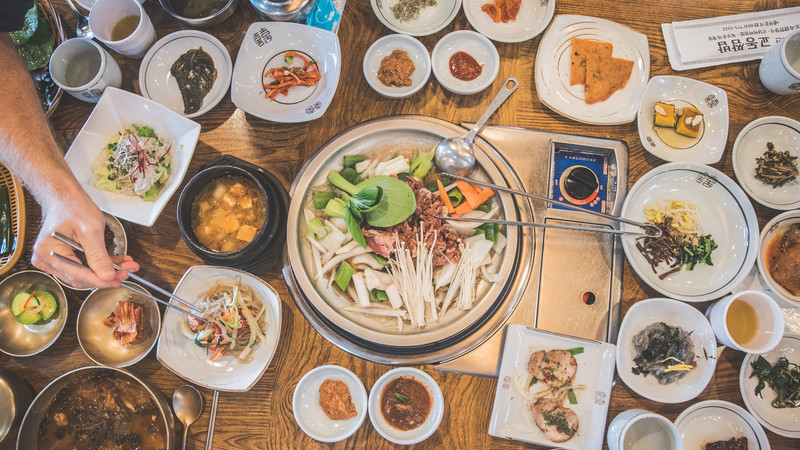
A packed table in Busan
Koreans would consider a good meal to be one with so many side dishes that it looks like the table leg will break under the weight of all those dishes.
You should have fermented kimchi, cured seafood, quick-blanched veggies mixed with sesame oil, bubbling soybean and tofu soup, savory onion or veggie pancakes, seasoned and grilled meats, sauces, fresh leaves, cured seafood, grilled fish and much more.
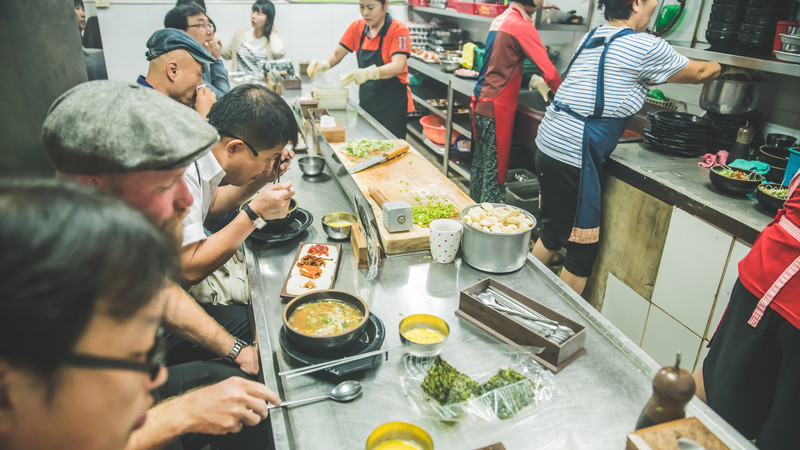
Delicious dishes in Daegu
Samgyetang: chicken and ginseng soup
Samgyetang or Korean chicken and ginseng soup will rev up your soul and appetite for its familiar yet unique taste. It’s like if a French Poule au Pot traveled to Asia and learned a new philosophy and approach to food.
It is a young chicken stuffed with glutinous sweet rice, ginseng, chestnuts, garlic, jujube, and herbs and then boiled in broth until tender. In olden times, Koreans would eat this dish on the three hottest days of summer for it would revitalize the body so they could work in the fields.
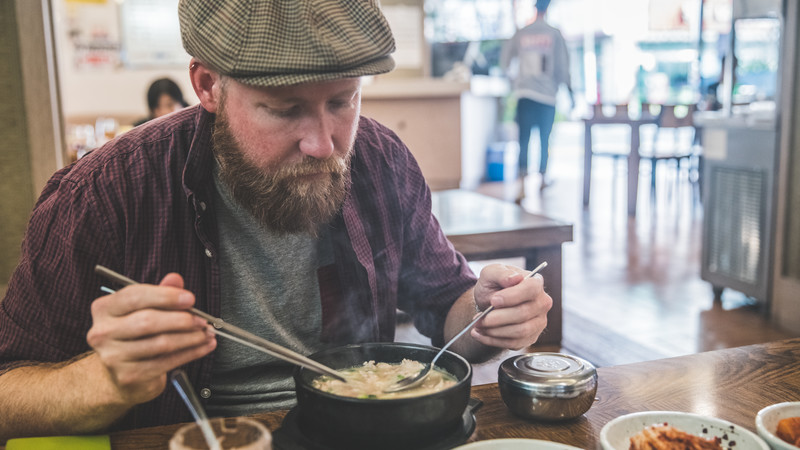
Slurping soup in Busan
There is a version made with an exotic black chicken that has black flesh and black bones (Ogolgye 오골게) which (some people claim) will rejuvenate them after sickness or a strenuous period of time.
The crowd favorite for this dish seems to be Tosokchun but I prefer Goryeo Samgyetang – both in Seoul. I also like Songchon Okdak in Jeonju.
Korean seafood: fresh raw fish wraps, live octopus and bubbling stews
No, Korean raw fish is not sashimi or sushi; it’s hwae (회). Koreans want food as fresh as possible. They want live fish killed immediately and then sliced before their very eyes.
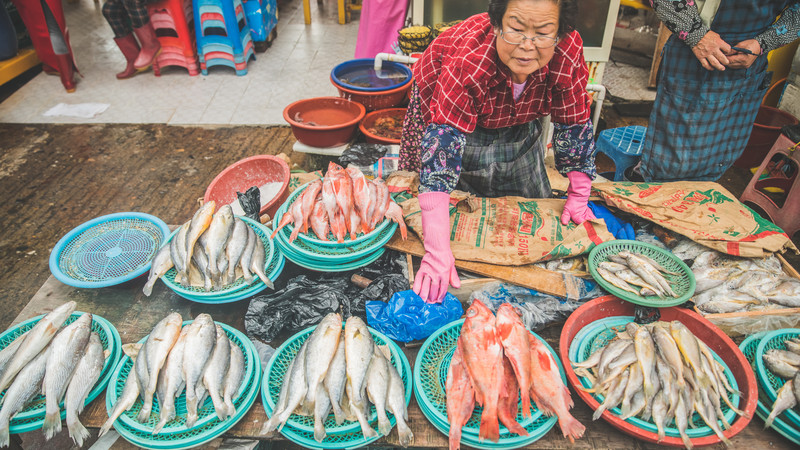
You can have seafood accompaniments such as raw sea squirt (monggae), grilled abalone, steamed king crab and squirming live octopus. There are many restaurants for this but I would recommend you pick out your own seafood from a fish market and then eat it at restaurant in the market. The best places to do this would be at the Jagalchi Market in Busan and Noryangjin Market in Seoul.
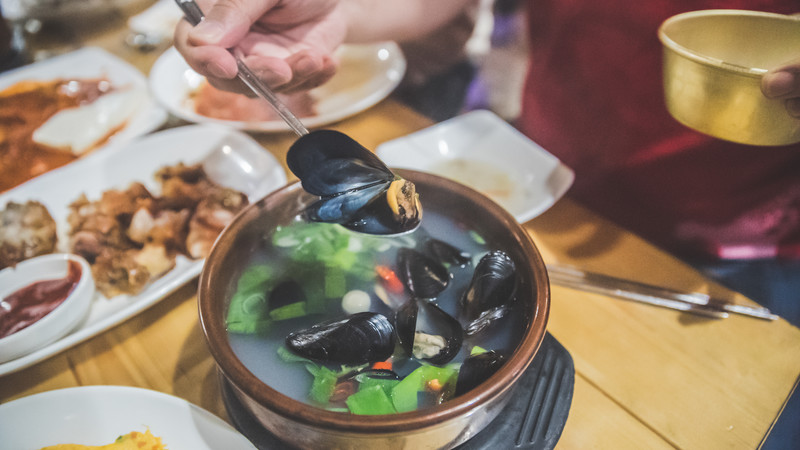
Seafood in South Korea’s Sunchang County
LOVE KOREAN FOOD? YOU’LL LOVE INTREPID’S 8-DAY FOOD TRIP IN SOUTH KOREA
Duh. Of course you have to have Korean BBQ while you are in Korea.
It is convenient, social and fun when you have a charcoal grill in the center of your table, many side dishes, leaves, salads, dips, assorted meats and scissors and tongs to cut and serve. Its mesmerizing.
For pork BBQ, I like to eat around BBQ alley by Jongno 3ga exit 4 at Jeju Abang. For beef, I like to go to Majangdong Beef Market or to Han6gam for a high-end BBQ experience.
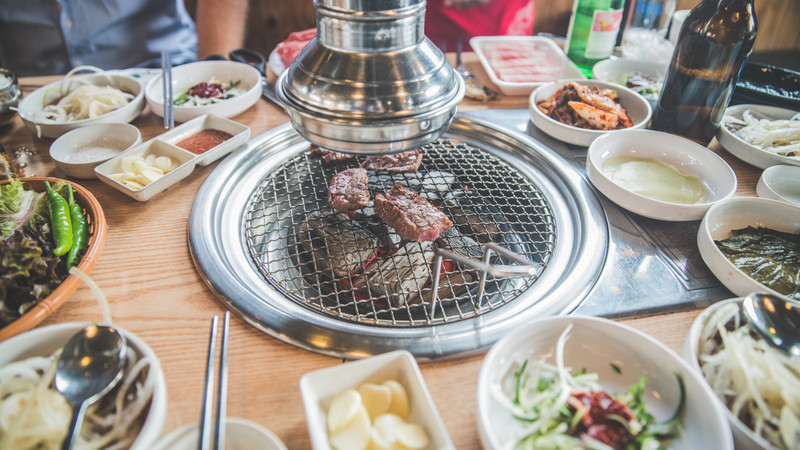
Korean BBQ in Seoul
SEE MORE: A PHOTO ESSAY OF SOUTH KOREA’S INCREDIBLE FOOD SCENE
Korean street food and delivery
If you come to Korea and are hungry, then you are doing it wrong. There are many food stalls in most busy areas in Korea. You can get 30cm ice cream in Hongdae, crisp mung bean pancakes at Gwangjang Market, giant dumplings and hotteok at Namdaemun Market and fried rice cake noodles at Tong Market.
There are a number of delivery services as well that will deliver to your hotel or to where you are at a park. Koreans are quite creative with their street food and you can even get steak in a cup (with beer) at Nuclear Steak.
There are so many things to eat and drink in Korea that you would need at least a month to try the many different dishes.
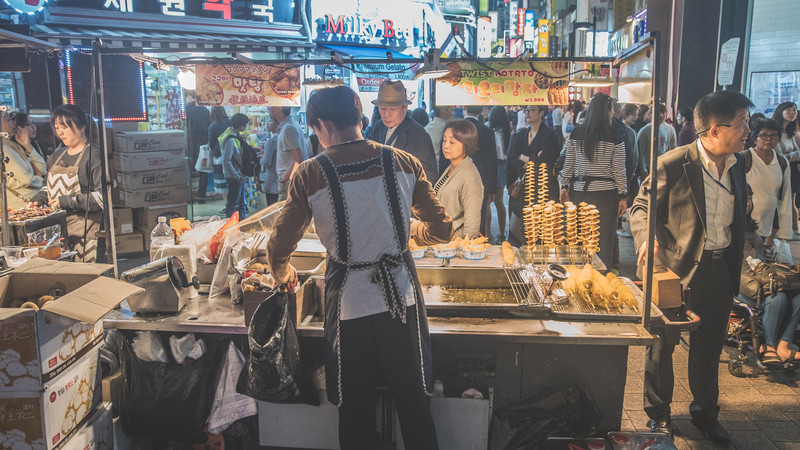
Street eats in Seoul
And after the Korean food, you might want to try Korea’s take on western food like craft beer, pizza, hamburgers, steaks and fine dining. If you love food and adventure, this is a culinary destination that’s not to be missed.
Ready to dive into one of the tastiest cuisines around? Check out Intrepid’s 8-day South Korea Real Food Adventure trip.
All images c/o Intrepid Travel. Dan’s bio image c/o Marco Arguello.
Feeling inspired?

Daniel Gray is a Korean-American Adoptee that returned to Korea in 2005 to rediscover his roots. He is a Korean food expert that has appeared on Bizarre Foods, Parts Unknown with Anthony Bourdain, the New York Times and more. He writes about Korea, consults, and owns two restaurants: Brew 3.14 and Brew 3.15 in Seoul. You can follow him on various social media at @seouleats or at seouleats.com .
You might also like
5 reasons to visit sri lanka in the..., why 2024 is the best year to see..., 6 unique experiences you can have in el..., from delhi to udaipur, here are the five..., cinque terre vs amalfi coast: which destination to..., love at first bite: 10 famous sandwiches from..., galapagos or madagascar which unique destination should be..., central vs south america: how to plan your..., why road-tripping is the best way to see..., lessons learned on intrepid’s sabah adventure, travelling to chile here’s the best time to....
- Boating Holidays
- Asia & Pacific
- Australia & New Zealand
- Central America
- Indonesia & Indian Ocean
- Middle East
- Scandinavia
- South America
- Business Travel
- Culinary Travel
- Wellness Travel
- Golf Travel
- Travel Style
- Travel Gear
- Travel Fashion
- Real Estate
- Destination Weddings
- Fishing Holidays
- Tricks & Hacks
- Travel News
- #WHERETONEXT
- Read All the Issues
- Working with DRIFT Travel
- Submit Your Photos to DRIFT Travel
- DRIFT Travel Magazine Media Kit

The Ultimate Foodie’s Guide To South Korea: Korean Cuisine And Street Food Delights
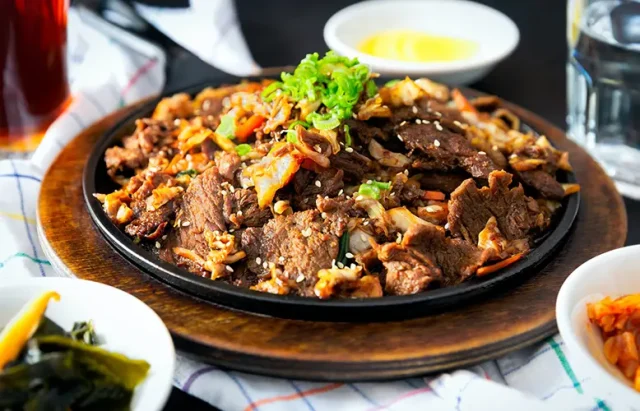
The vibrant and bustling streets of South Korea offer a feast for the senses, especially for the avid foodie. Korean cuisine is a rich tapestry of flavors and textures, deeply rooted in history yet constantly evolving. From sizzling street food to traditional dishes that have stood the test of time, South Korea is a gastronomic paradise waiting to be explored.
As we embark on this culinary journey, we’ll uncover the ultimate foodie’s guide to Korean cuisine and street food delights that are not to be missed in 2023.
1. Tteokbokki: The Spicy Staple
No foodie trips to South Korea 2023 would be complete without indulging in the spicy, chewy goodness of Tteokbokki. These rice cakes are simmered in a fiery red chili sauce and are often paired with fish cakes and boiled eggs. A staple in Korean street food culture, Tteokbokki is a beloved snack that perfectly embodies the harmony of sweetness and heat that Korean cuisine is famed for.
2. Korean BBQ: A Communal Affair
Korean BBQ is not just a meal; it’s a communal dining experience. Gather around a grill with friends, cooking thin slices of marinated meats such as bulgogi and galbi. The smoky aroma of grilling meat, complemented by a variety of banchan (side dishes), makes Korean BBQ a must-try. Each morsel dipped in ssamjang and wrapped in lettuce is a bite-sized piece of heaven.
3. Kimchi: The Fermented Phenomenon
Arguably the heart and soul of Korean cuisine, Kimchi is a fermented dish usually made from napa cabbage and radishes, seasoned with a mix of garlic, ginger, scallions, and chili pepper. A staple at every Korean table, this dish is not only packed with probiotics but also serves as a versatile side that complements nearly every dish.
4. Street Toast: Korea’s Breakfast Of Champions
Begin your day like a local with Korean street toast, a unique and satisfying breakfast option. Vendors skillfully layer cabbage, carrot, and onion omelets with slices of ham and cheese, all sandwiched between buttery toasted bread. It’s a simple, yet utterly delicious way to start your foodie adventure.
5. Bingsu: Beat The Heat With Shaved Ice
When the summer heat strikes, cool down with Bingsu, Korea’s beloved shaved ice dessert. Fluffy ice is piled high and typically topped with sweet red beans, fruit, and condensed milk. Modern twists include a variety of flavors like matcha, mango, or even cheesecake, proving that Bingsu is a refreshing treat for any palate.
6. Japchae: Stir-Fried Sweet Potato Noodles
A dish as colorful as the Korean landscape, Japchae is made from stir-fried sweet potato noodles mixed with an array of vegetables and sometimes beef. The noodles are delightfully springy, and the dish is seasoned with soy sauce and sesame oil, offering a slightly sweet and savory flavor profile.
7. Gimbap: Korea’s Answer To Sushi Rolls
Gimbap is a popular grab-and-go snack that resembles sushi rolls but is uniquely Korean. Seasoned rice and various fillings such as vegetables, egg, and meat are rolled in sheets of seaweed. Each bite-sized piece is a perfect harmony of flavors and is ideal for picnics or as a quick snack while exploring.
South Korea’s culinary scene is as dynamic as it is delicious, offering endless options for the intrepid foodie. From the sizzling streetside grills to the refreshing chill of Bingsu, Korean cuisine offers a world of flavors waiting to be savored. These Korean food staples are sure to satisfy your cravings and inspire your palate. So, grab your chopsticks, and let’s eat like the locals!
RELATED ARTICLES MORE FROM AUTHOR
Hennessy’s Guided Tours In Cognac Win ‘Best Innovation’ At The 2024 Wine Tourism Awards
New research reveals Europe’s Top 5 hidden foodie destinations
Culinary Tourism Report: The UK’s best-kept foodie spots
Privacy overview.
Savor a Contemporary Taste of La Dolce Vita at Hotel La...
- Destinations
- Travel Tips
- Community Trips
- TTIFridays (Community Events)
- SG Travel Insider (Telegram Grp)

- South Korea
Seoul Food Guide — 15 Korean Food and the Best Places to Try It
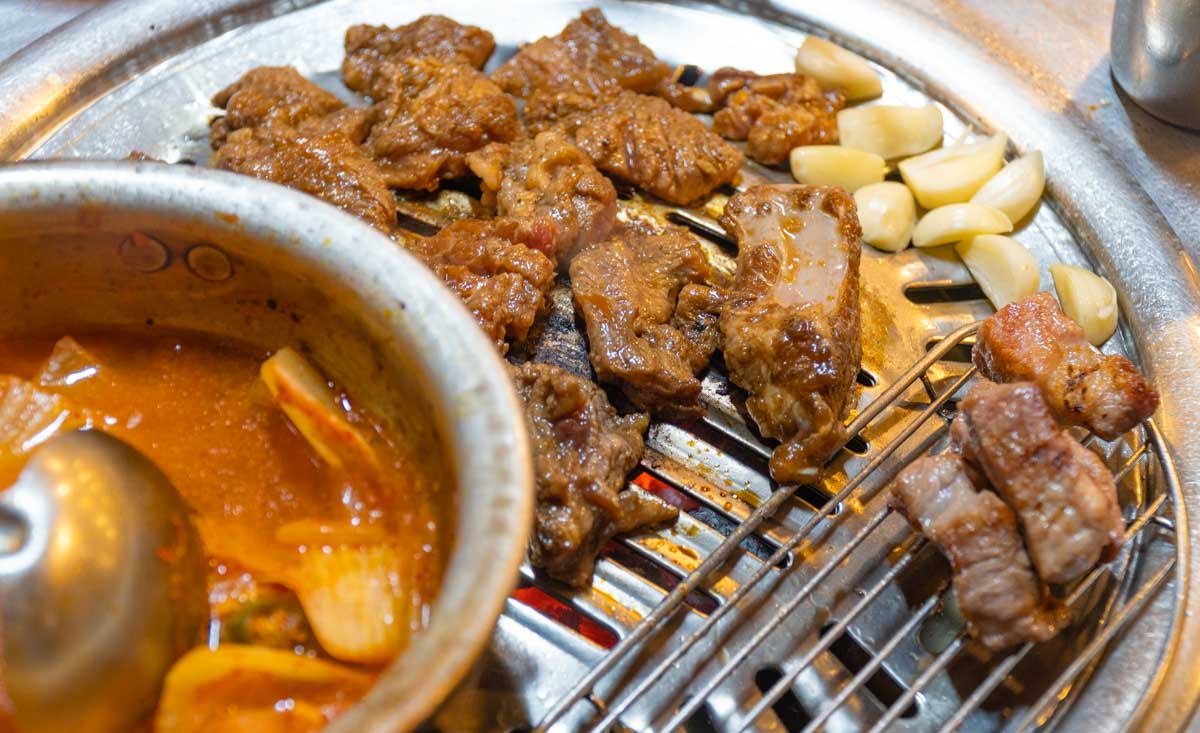
The ultimate Seoul food guide that’ll make you go mashisoyo! (delicious) 😍
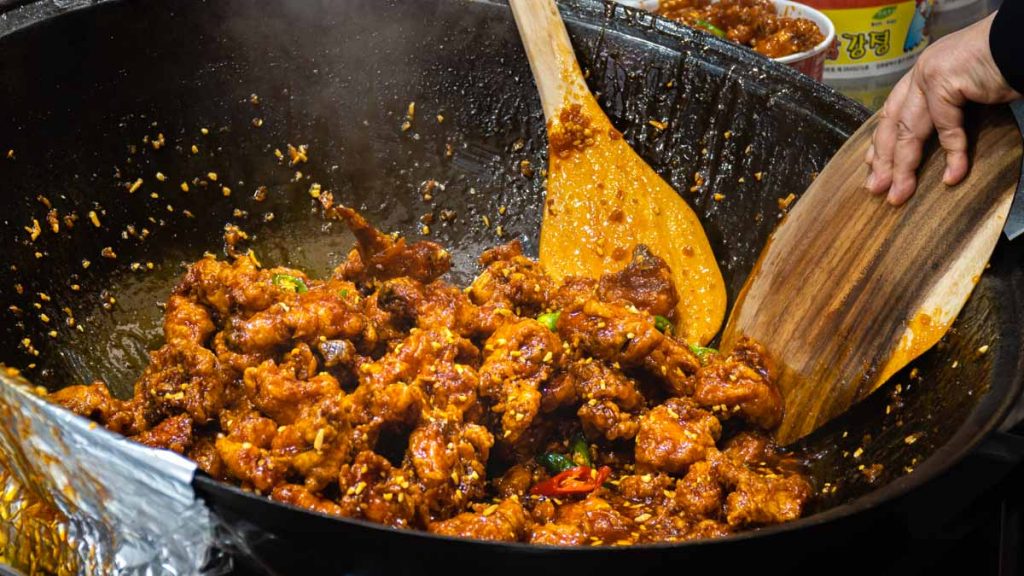
Thanks to the Singapore South-Korea VTL scheme , we not only managed to revel in the country’s gorgeous hikes, iconic attractions and epic day trips but also, indulge in delicious local food.
So we’ve put together this Seoul food guide for all our fellow foodies — things you definitely can’t miss while you’re in town!
Read also: 7D Singapore-South Korea VTL Itinerary Under S$2.9k incl. Covid Expenses
1) Korean Barbeque
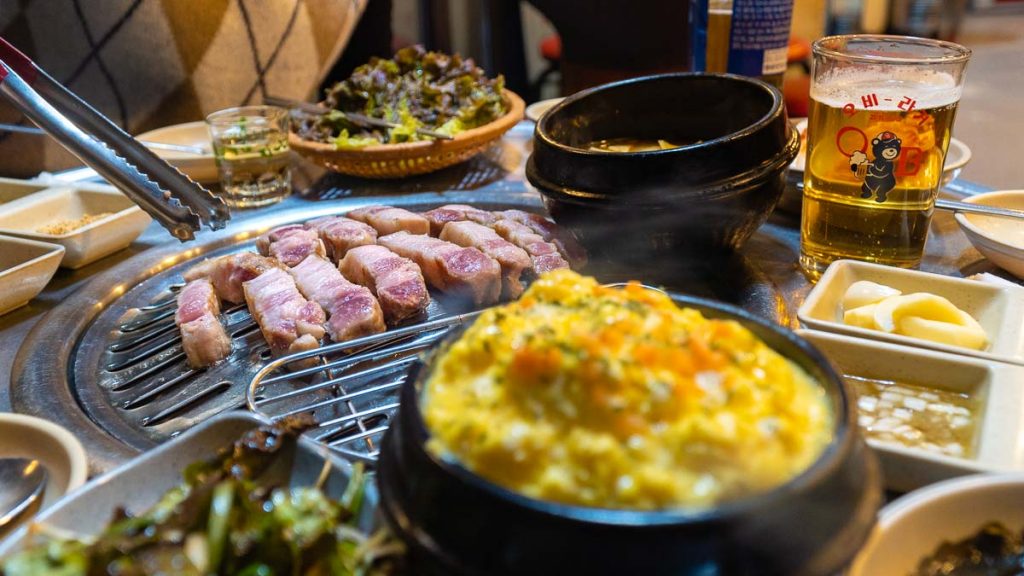
What’s a trip to Korea without some authentic KBBQ?
Best eaten traditionally by wrapping the meat in a lettuce leaf, some restaurants even offer eight flavours of samgyeopsal or grilled pork belly — such as wine, ginseng and curry.
But if you’re on a budget or prefer original flavours, Old House Charcoal Meat Restaurant in Hongdae (옛날집 참숯구이) is one of our favourite KBBQ spots.
We loved the thick and juicy pork belly, pork ribs, beef ribs, as well as other side dishes like the fluffy Korean Steamed Egg ( Gyeran Jjim 계란찜). Best part is, it’s open till the wee hours of the morning — perfect for a late dinner or supper!
*Pro-tip: Book on Klook (min two pax) to skip the queue.
Cost: From ~S$14 Opening hours: 4PM – 5AM Address: 169-6, Donggyo-dong, Mapo-gu (Hongik Univ. Station, Exit 8)
2) Dakgalbi 닭갈비 — Spicy Stir-fried Chicken
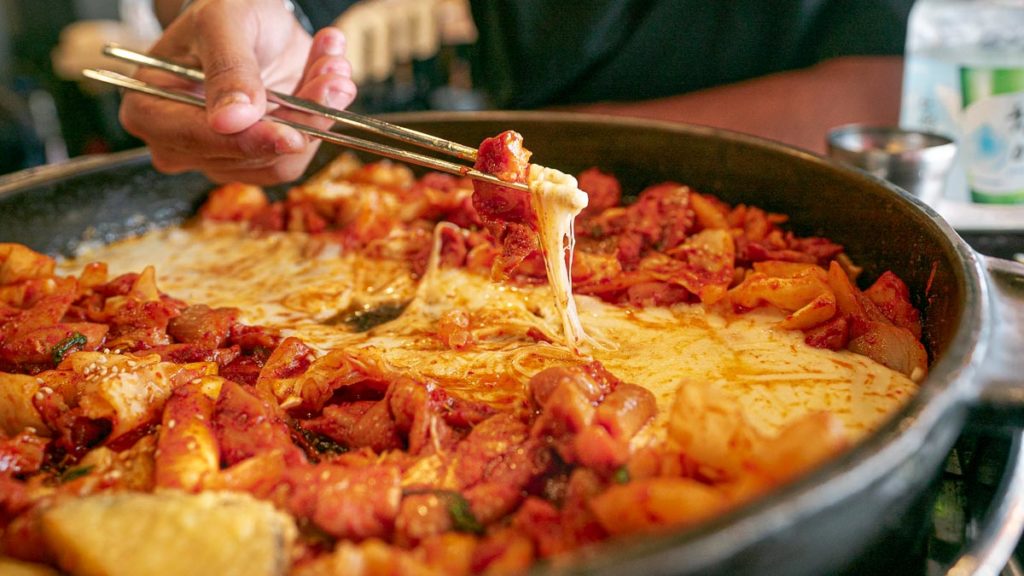
Dakgalbi is a spicy stir-fried chicken dish mixed with rice cakes, onions, cabbage and cheese. Or as I like to call it, heaven in a pot.
Hong Chun Cheon Dakgalbi is a restaurant famous for this dish, with many outlets across Korea. Leaving hungry isn’t a possibility — the servings here are huge! But if you’re still feeling peckish, add on cheese fried rice. It comes with seaweed, sesame and of course, loads of cheese.
Cost: From ₩10,000 (~S$12) Opening hours: 10:30AM – 11PM Address: Hongik-ro 6-gil, Seogyo-dong, Mapo-gu (Hongik Univ. Station, Exit 9)
3) Fresh Seafood
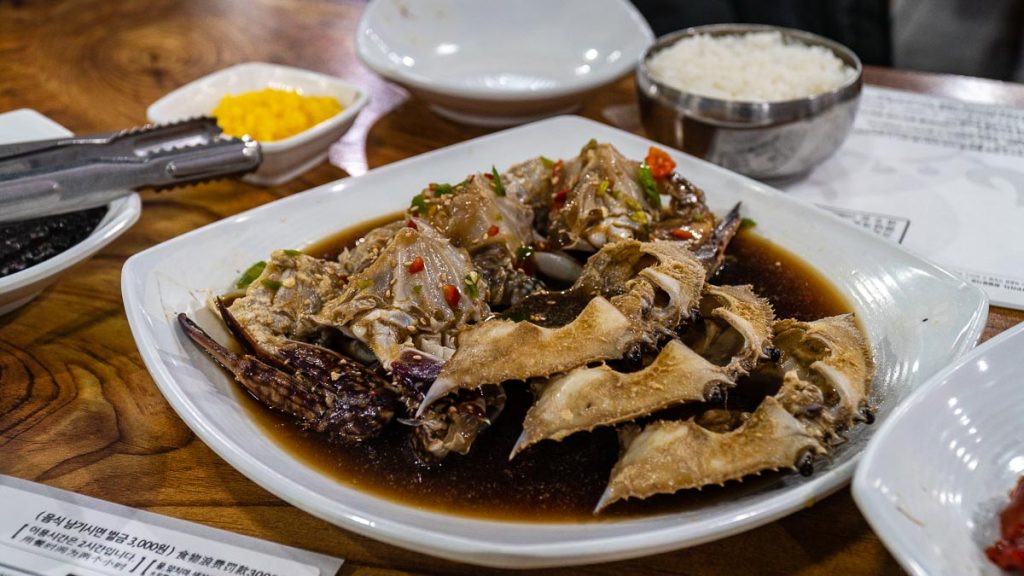
Honestly, raw crab meat didn’t sound too appetising at first. But after trying, I couldn’t get enough of it. 🤤
The crabs served at Sunmine Hengbok Gejang in Dongdaemun (순미네행복게장) are marinated in soy sauce and spicy sauce — no strong fish smell at all! The restaurant also provides aprons so you won’t dirty your clothes while eating.
*Pro-tip: Use the crab shell to scoop some sauce with the meat and eat it directly from the shell. It gives the meat a lot more flavour!
Cost: From ~S$23 Opening hours: 10:30AM – 11PM (Weekdays), 10:30AM – 10:30PM (Weekends) Address: 38 Eulji-ro 43-gil, Euljiro 6 (yuk)-ga, Jung-gu (Dongdaemun History and Culture Park Station, Exit 14)
4) Grilled Intestines ( Gopchang 곱창)
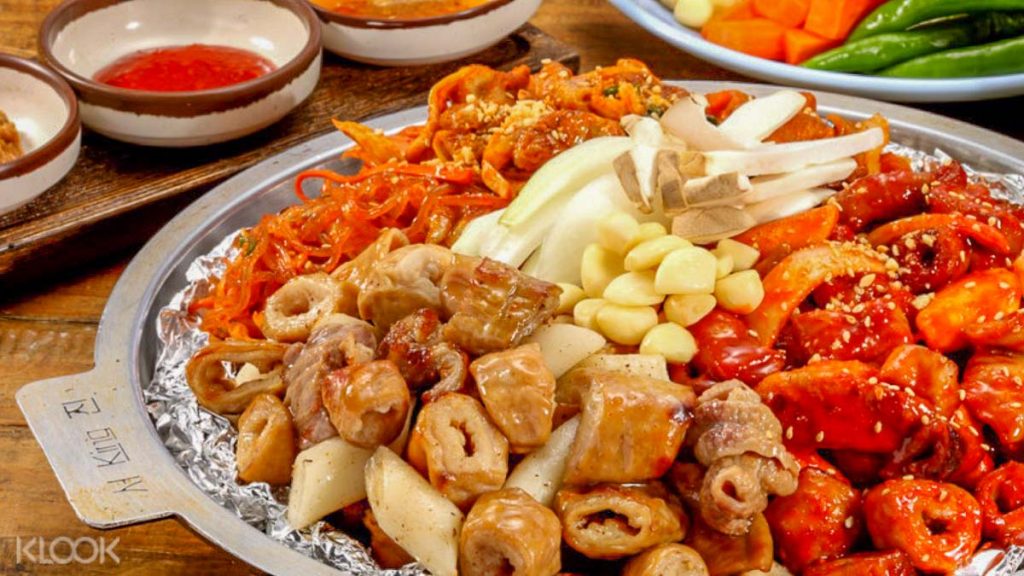
Photo credit: Klook
In Korea, gopchang refers to a cattle’s small intestines. Despite how it sounds, it’s actually really delicious.
The chewy salted and seasoned pork intestines come in a generous portion at Aunt’s Grilled Intestines (Gopchang Restaurant) (이모네 곱창) — also available on Klook at a discounted rate!
Cost: From ~S$15 Opening hours: 5PM – 10PM (Closed on Sun) Address: 131-1, Chungmuro 4-ga, Jung-gu (Chungmuro Station, Exit 8)
Read also: 23 Best Things To Eat In Seoul’s Most Popular Districts — Hongdae, Myeongdong, Dongdaemun
5) Dalgona Candy (달고나 캔디)
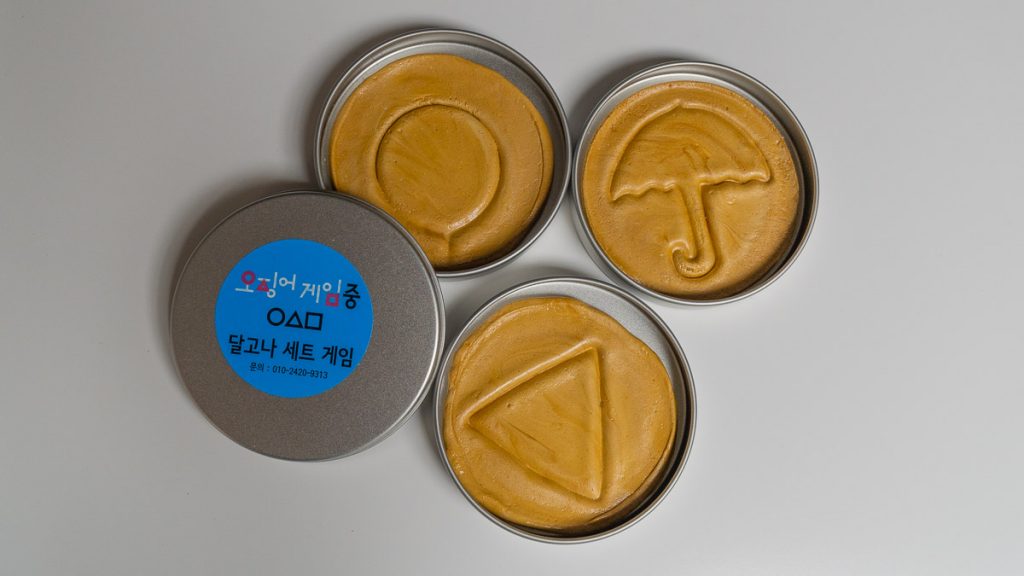
Popularised by K-drama ‘ Squid Game ‘, dalgona candy is a common snack in Korea made with melted sugar and baking soda.
You can easily find it anywhere on Seoul’s streets. We got ours at a street stall along the famous Myeong-dong shopping street , which comes in a ‘Squid Game’ casing!
Needless to say, we had to buy safety pins (we couldn’t find needles) from a nearby convenience store to try out the game. True to the show, the triangle design took little effort to cut out while the umbrella design cracked under a minute. 😭
Cost: ₩4,000 (~S$4.60) How to get there: Myeong-dong Station, Exit 6
6) Sundubu Jjigae 순두부찌개 — Spicy Soft Tofu Stew
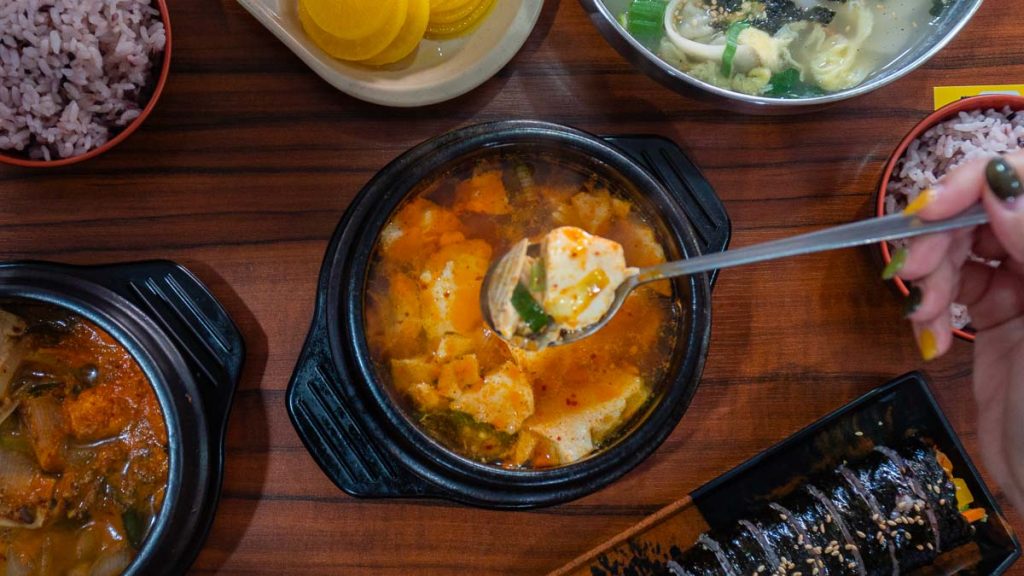
Here’s the best dish to warm up your body during winter — spicy soft tofu stew.
Most restaurants serve this Korean staple, but we really loved the stew at this small eatery we chanced upon after hiking Naksan Park .
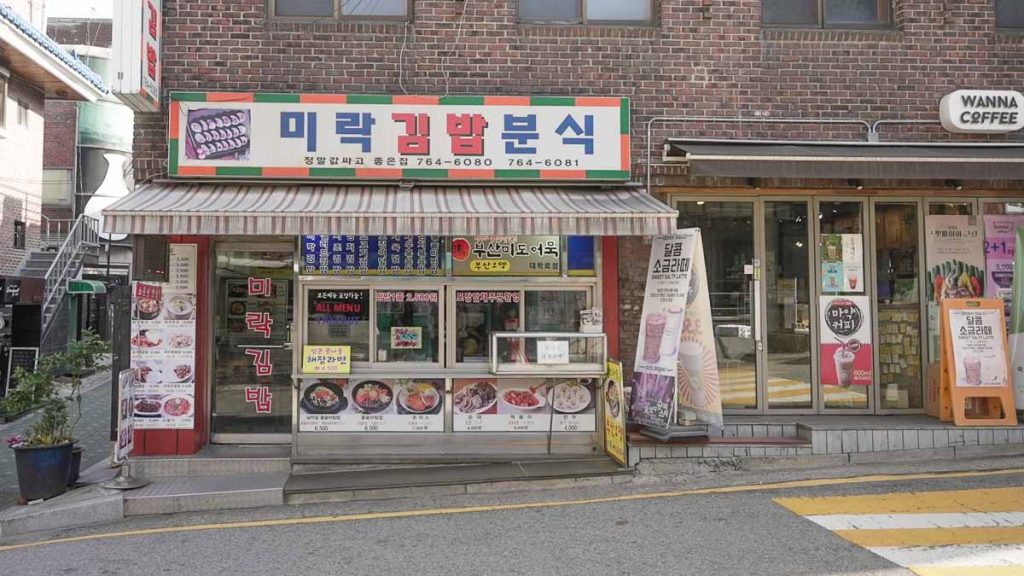
This cosy shop located near Hyehwa Station serves both affordable and delicious noodles and soups, as well as gimbap (seaweed rice roll). We’re not exactly sure of the shop’s name, but you’ll spot it right beside WANNA COFFEE cafe.
Cost: From ₩5,000 (~S$6) Opening hours: 10AM – 10PM Address: 2 Dongsung 2-gil, Donsung-dong, Jongno-gu (Hyehwa Station, Exit 2)
7) Tteokbokki 떡볶이 — Spicy Rice Cakes
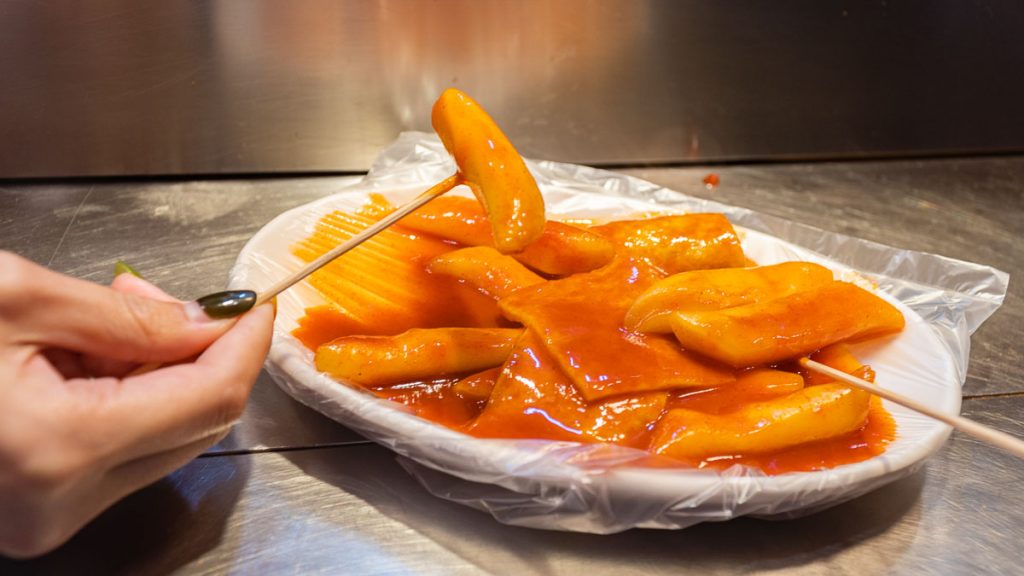
You can find tteokbokki (rice cakes) everywhere in Korea, both in restaurants and street stalls. It’s a popular local snack, perfect for a quick bite as you brave the cold winters!
Most days, we couldn’t resist buying a plate of tteokbokki on our way back home for supper 😆
Cost: ₩3,000 (~S$3) How to get there: Dongdaemun History and Culture Park Station, Exit 1/2 (We got ours at a street stall opposite Dongdaemun Design Plaza)
8) Samgyetang 삼계탕 — Ginseng Chicken Soup
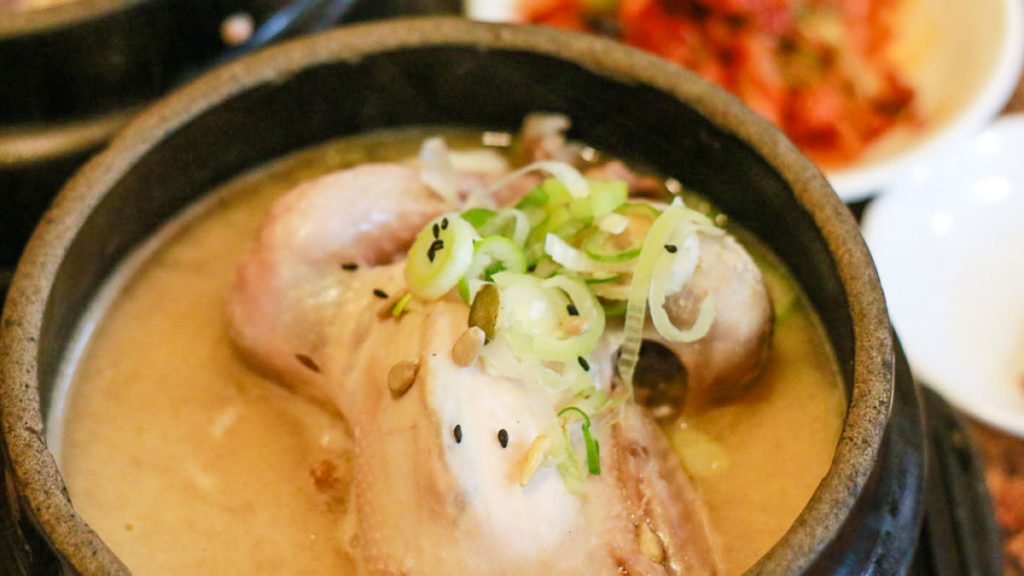
Truly a chicken soup for the Seoul, samgyetang is a Korean traditional ginseng chicken soup meant to help cool down the body during hot and humid weather.
It’s made up of a whole chicken stuffed with garlic, rice and of course, ginseng. Tosokchon Samgyetang is a popular spot for this dish among tourists. It’s near Gyeongbokgung Palace , one of Seoul’s most iconic landmarks.
Cost: From ₩15,000 (~S$17) Opening hours: 10AM – 10PM Address: 5, Jahamun-ro 5-gil, Jongno-gu, (Gyeongbokgong Station, Exit 2)
9) Chicken and Beer ( Chimaek 치맥)
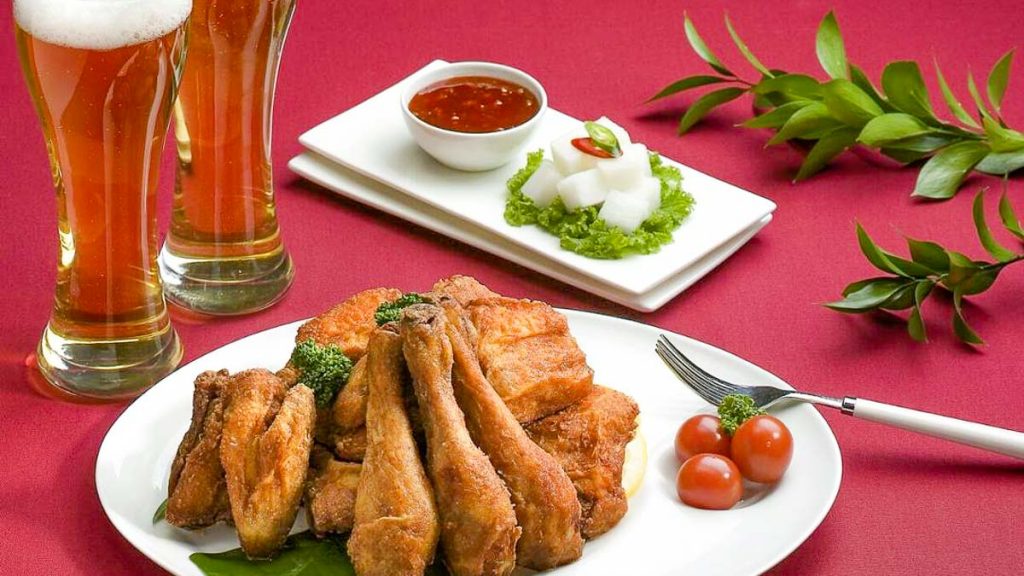
Photo credit: @chickentwotwo via Instagram
No Seoul food guide is complete without the ultimate OTP (one true pairing) — chicken and beer 😍
Two Two Chicken is a popular chain with multiple outlets across Korea. Expect a large portion of crispy fried chicken with a variety of flavours such as soybean, teriyaki, garlic and green onion.
We stuck to the original, which was still finger-lickin’ good and juicy on the inside!
Cost: From ₩17,000 (~S$20) Opening hours: 10AM – 1:30AM Address: 6-4 Namsandong 2(i)-ga, Jung-gu (Myeung-dong Station, Exit 3)
10) Budae Jjigae 부대찌개 — Army Stew
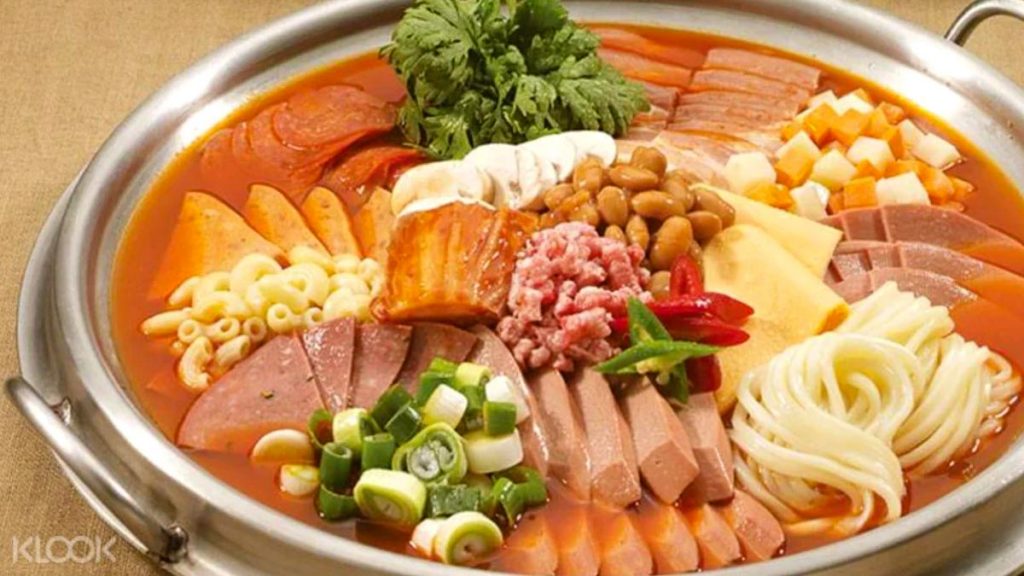
Also known as budae jjigae , army stew is a Korean hotpot filled with ramen, noodles, sausages, spam and rice cakes.
Indulge in a free-flow buffet of kimchi , ramen , fries and drinks at Nolboo Budae Jjigae and Cheolpangui restaurant — you’re sure to leave fully satisfied.
Cost: From ~S$13 Opening hours: 11AM – 11PM Address: 33-43, Changcheon-dong, Seodaemun-gu (Sinchon Station, Exit 2)
Read also: 7 Korean Dishes You Must Try Outside Seoul – Jeonju, Geoje and Yeosu Edition
11) Bingsu 빙수 — Shaved Ice Dessert
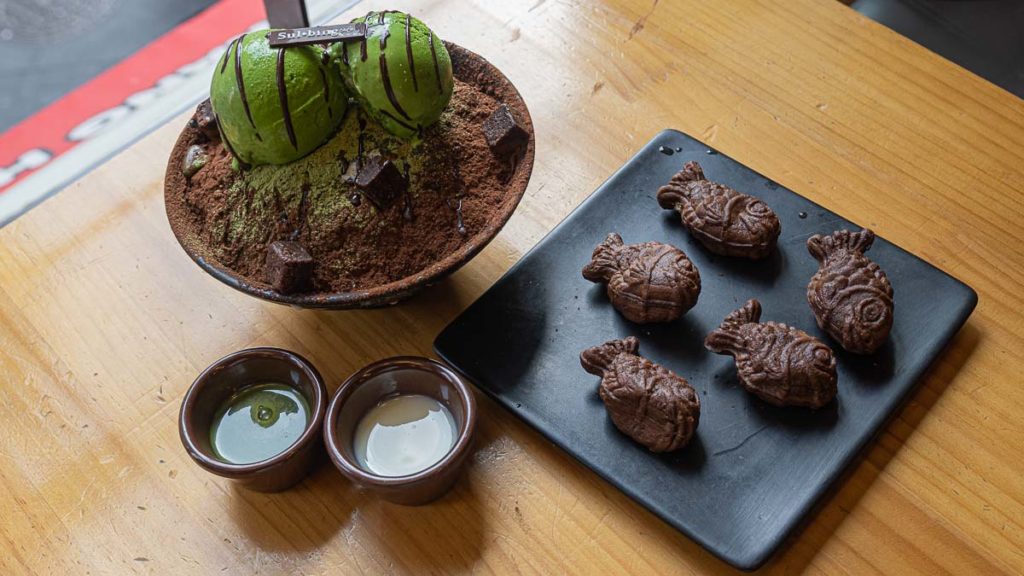
The number one dessert cafe in Korea has got to be Sulbing , which serves one of the best bingsu s (shaved ice dessert)!
You won’t have trouble locating an outlet — there’s more than 400 in Korea. Some bestsellers include the signature Injeolmi Sulbing consisting of shaved milk, red bean and rice cake, as well as Matcha Cocoa for green tea lovers. One serving is plenty for two people to share.
Cost: From ₩7,000 (~S$8) Opening hours: 10AM – 11PM Address: 20 Myeongdong 10-gil, Myeongdong 2(i)-ga, Jung-gu (Myeung-dong Station, Exit 8)
12) Bibimbap 비빔밥 — Korean Rice Bowl
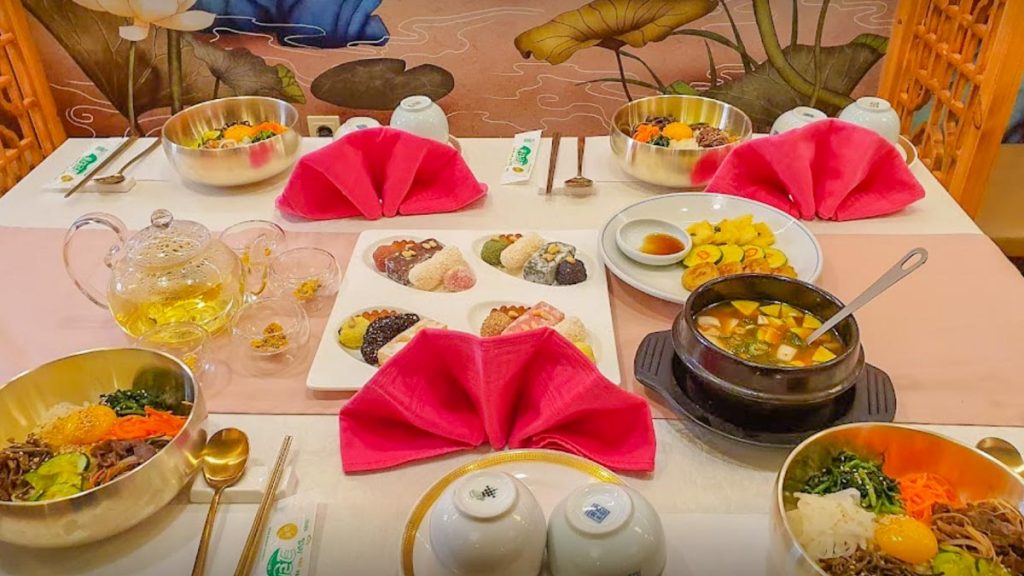
Photo credit: Myeongdongjeong
You can’t leave Korea without having bibimbap — a rice bowl mixed with seasoned vegetables and meat.
At Myeongdongjeong , feast on bibimbap like royalty in your very own private dining area. Feeling a little extra? Purchase the set meal on Klook — you’ll get to wear a hanbok while dining.
Cost: From ~S$29 (2pax set) Opening hours: 11AM – 4PM (Lunch), 5PM – 11PM (Dinner) Address: Seong Chang Building 1F (Parking lot beside Sejong Hotel), 299, Samil-daero, Jung-gu (Myeong-dong Station, Exit 10)
13) Pancakes ( Jeon 전)
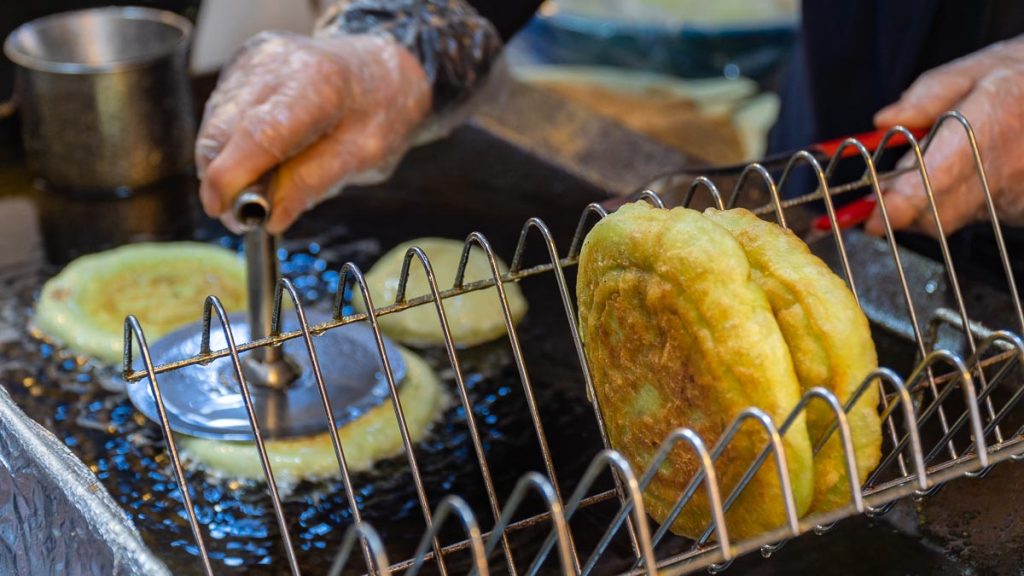
Nothing beats freshly made Korean pancakes at the street stalls found along Sinpo International Market . We were surprised at how fluffy yet crispy the pancakes were, compared to the ones we usually eat in cafes!
The market has a history of over 100 years. Besides mung bean pancakes, it’s also known for dakgangjeong — a fried chicken dish glazed with sweet and spicy sauce.
Cost: ₩1,000 per piece (~S$1) Opening hours: 10:30AM – 11PM (Weekdays), 10:30AM – 10:30PM (Weekends) Address: 11-5, Uhyeon-ro 49beon-gil, Jung-gu, Incheon (Dongincheon Station, Exit 2)
14) Traditional Korean Tea and Dessert
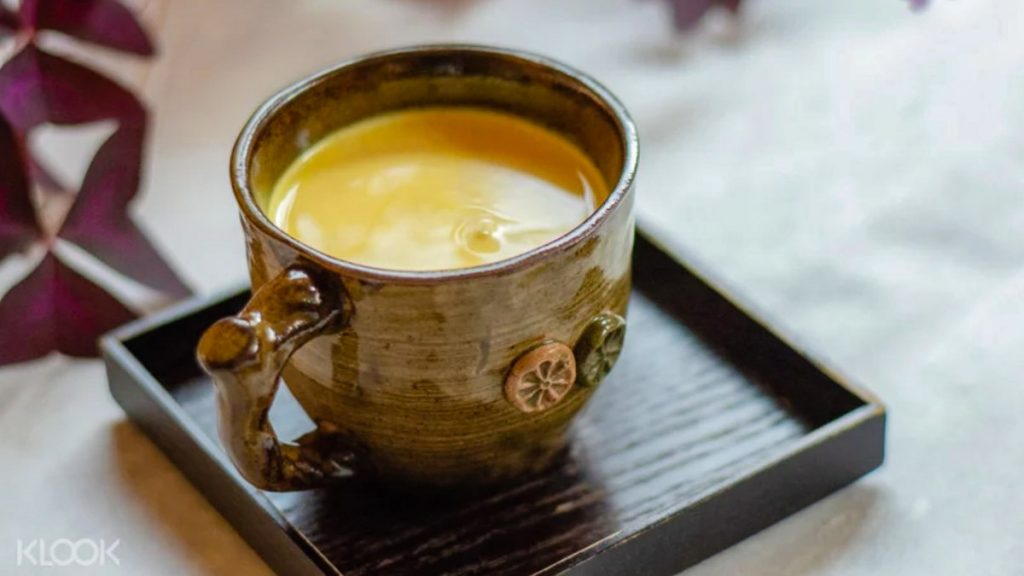
After working up an appetite from shopping at Insadong , treat yourself to tea and desserts in a cosy cafe!
What sets Banjak Banjak Bitnaneu apart from other cafes in the area is that it’s a traditional Korean tea house famous for handmade tea. Besides tea, there’s also fruit smoothies and desserts like rice cakes and bingsu .
Cost: From ~S$8 Opening hours: 11AM – 10:30PM Address: 28-1 Insadong-gil, Gwanhun-dong, Jongno-gu (Jongno 3-ga Station, Exit 5)
15) Jeju Green Tea and Giant Pastries at Starbucks
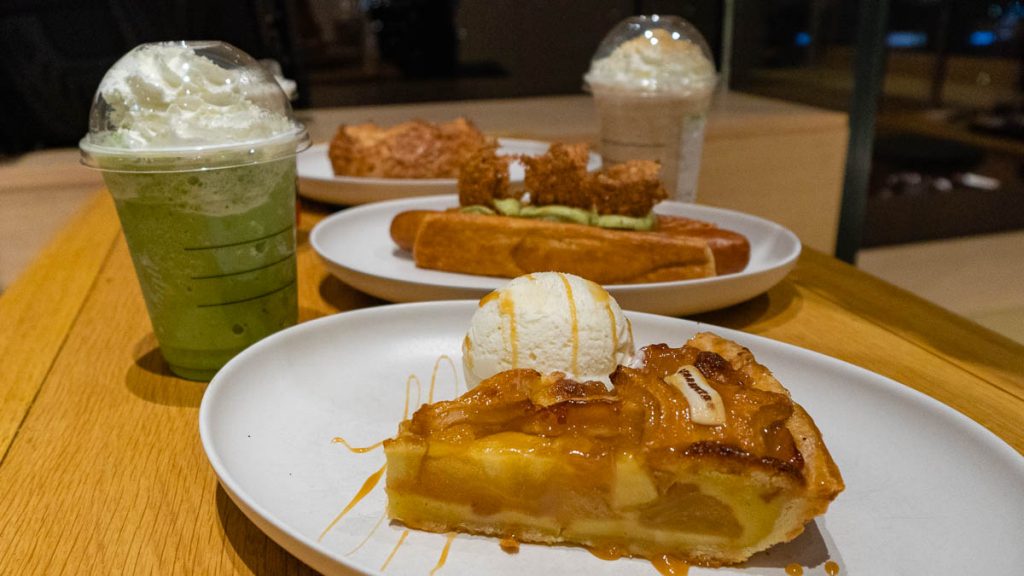
Here’s something you probably can’t find in a Singapore Starbucks: Malcha (green tea, yes it’s spelt that way) latte from an organic farm in Jeju.
For someone who doesn’t really like green tea, the malcha or green tea latte was surprisingly my favourite drink on the menu. I loved how it doesn’t give off a very strong tea taste but rather, blends nicely with milk to create a really creamy taste.
The pastries were also considerably larger than in Singapore, with a thick and crispy crust!
Cost: From ₩6,100 (~S$7) Opening hours: 9AM – 8PM How to get there: There’s a Starbucks outlet everywhere in Seoul
Bonus: Convenience Store Snacks
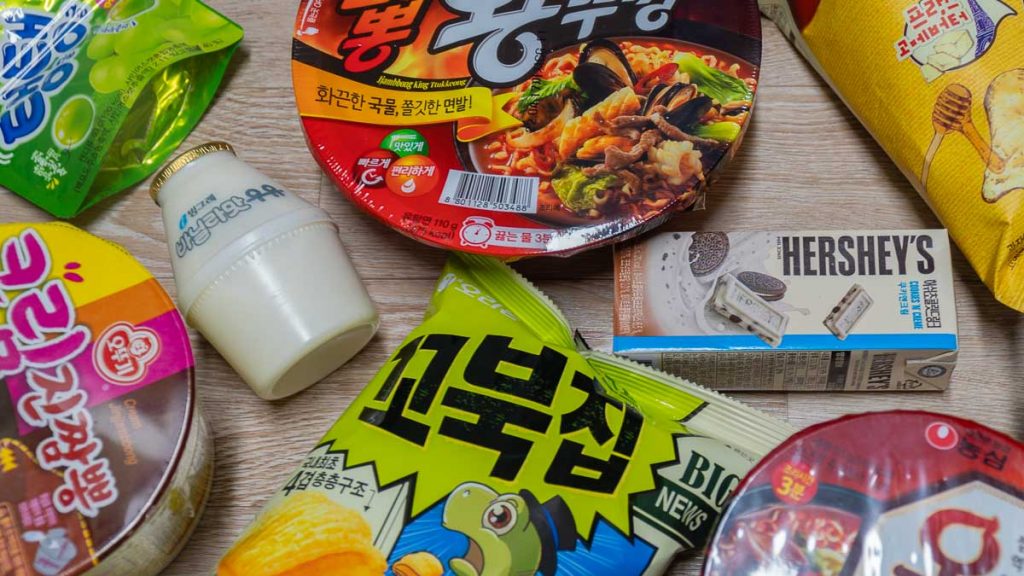
Convenience stores can be found at almost every corner in Korea. It’s here you’ll find some pretty interesting snacks!
Like the famous banana milk drink which comes in different flavours — vanilla, honey and strawberry. Or the super addictive corn chip snacks. And of course, spicy ramyeon is a must-have for late-night supper!
Cost: From ₩1,500 (~S$2) Convenience stores to look out for: GS25, emart24, CU
Read also: 15 Korean Food You Must Eat in Seoul
Korean Phrases to Know Before You Go
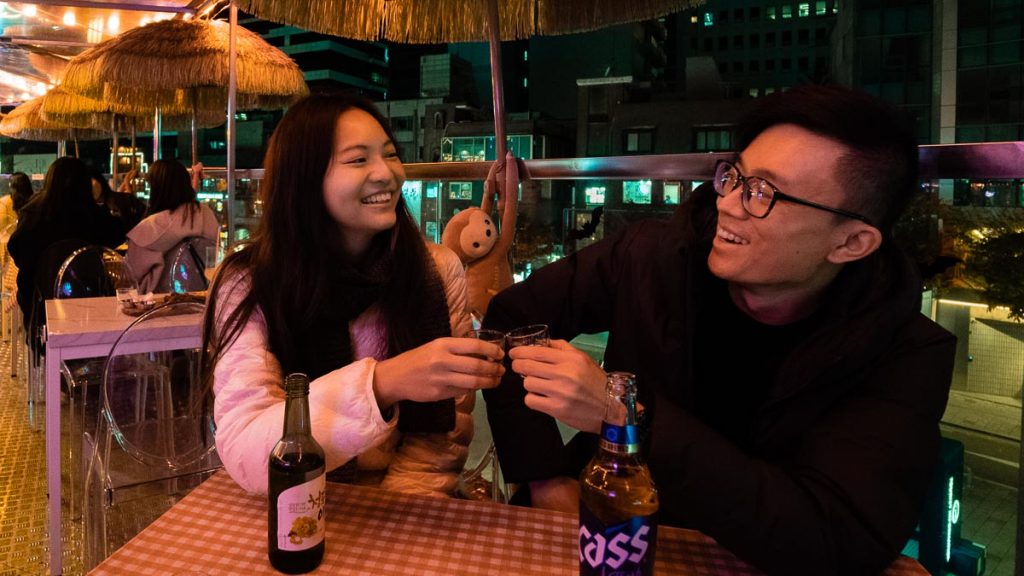
It’s always helpful to learn the local language as some restaurants don’t have English menus. Here are some commonly used phrases:
While there’s no doubt Singapore is a food paradise , feasting in South Korea is always something we enjoy. There’s both familiar favourites and unique dishes you can’t find anywhere else — and we can’t wait to return to try them all 🤩
Foodies — check out these food guides for inspiration on your next trip: – Shanghai Food Guide — 15 Mouth-Watering Dishes You Won’t Regret – Ultimate Hong Kong Food Guide: 50 Best Eats Incl. Halal Food – Okinawa Food Guide — From the Unusual to the Unapologetically Delicious
What’s your favourite dish in this Seoul food guide? Share with us in the comments below!
Like what you see? Follow us on Facebook , Instagram , YouTube and Telegram for more travel updates!
View this post on Instagram A post shared by thetravelintern.com 🇸🇬 (@thetravelintern)
RELATED ARTICLES MORE FROM AUTHOR
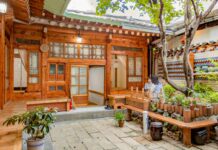
9 Hanok Stays in Seoul for the Authentic Korean Experience
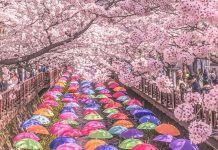
South Korea Cherry Blossom Guide 2024 — The Only Guide You’ll Need
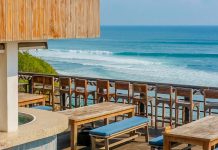
Where Are the Best Vegetarian Restaurants in Bali With a View? — Uluwatu, Canggu, and Seminyak (South Bali Edition)

Where to Stay in Seoul — 13 Aesthetic Yet Affordable Accommodations In Rising Hipster Districts
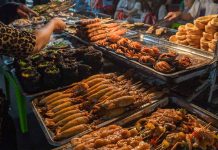
Southern Vietnam Food Guide — 17 Best Places to Eat at Ho Chi Minh, Da Lat, Mui Ne, and Phu Quoc

17 Exciting Things to Do in Jeju — From Bucket List Experiences to Lesser-Known Sights
This site makes me hungry; What’s your number one tip for barbecue? Thank you
LEAVE A REPLY Cancel reply
Save my name, email, and website in this browser for the next time I comment.

11 Things to do in Clark, Philippines — A Quiet Adventure...

20 Things to Eat-See-Do in Sabah’s Capital Besides Climbing Mount Kinabalu

Experience Macao Singapore Roadshow: Get Exclusive Deals, Experience the Macau Grand...

Ultimate 6-Day Adelaide Itinerary — The Best of South Australia’s Underrated...

31 New Deals and Attractions in Singapore this April 2024

- Terms Of Use
- Privacy Policy
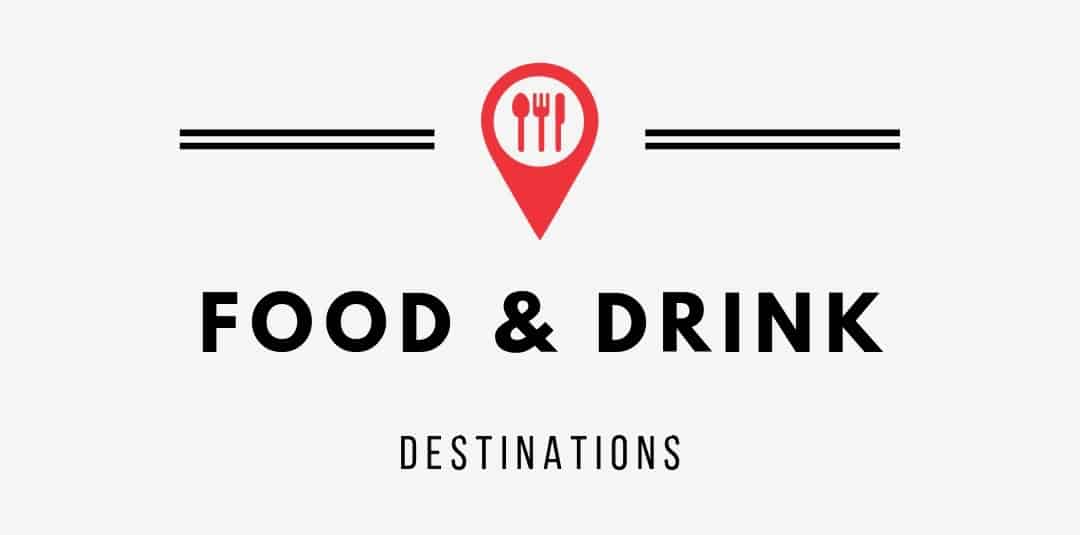
- Destinations
- Travel Guides
- For The Home
- Privacy Policy
Food , South Korea
Seoul food tours: the best tours for food travelers to korea.
Seoul is one of the most often overlooked cities in Asia for food travelers. There’s so much great food in the city, but Seoul, South Korea, is a massive and sprawling city. This can make it difficult to track down the best food to eat.
Booking a Seoul day tour or half day tour can help travelers learn more about Korean food culture. In this post, we share our tips on how to book the best Seoul food tours, cooking classes, and drink experiences.
*This post contains compensated links. Find more info in my DISCLAIMER . As an Amazon Associate, I earn from qualifying purchases.
Why Book A Seoul Culinary Tour
There are lots of great reasons why booking a Korean food tour could make your visit to Seoul that much more special. First, there is a language barrier in Seoul. We found a good number of people who spoke English.
There are picture menus to help at restaurants. But, to make the most of your experience and to learn about Korean food culture, a food tour can help.
Second, many food travelers don’t know a lot about Korean food. Perhaps not as much as Japanese food or Thai food, which is easier to find in cities around the world.
Booking a food tour can help introduce travelers to the dishes and ingredients. A local Seoul tour guide can explain everything and answer all your questions about Korean food.
Last, we love taking food tours at the start of our stay in a new city. It really makes the rest of our trip better. Your guide will give you inside tips on where and what to eat in Seoul too. Over the years, we’ve received great restaurant recommendations from some of our food tour guides.
See our Seoul Food Guide – What To Eat In Seoul South Korea or learn about Traditional Korean Fruits

Click Here For The Top Rated Food Tours In Seoul On Viator

How About An 8 Day South Korea Food Tour?
This post focuses on recommendations for Seoul city tours and experiences that focus on food and drink. These tours are great for a traveler doing a city break in Seoul or just stopping through. If you have more time, and really want to learn more about Korean food, consider booking a South Korea food tour.
Intrepid Travel offers an 8 Day So uth Korea Real Food Adventure. This tour is a Korean food trip that explores Seoul as well as Busan and Jeonju. It also includes an overnight temple stay, which is a unique experience.
Other food and drink experiences include a visit to a craft beer brewery, visits to seafood markets, and a more in-depth look at street food markets in Korea.
We definitely recommend taking one of the Intrepid food tours. We took their tour in Morocco and learned so much more than we would have if we traveled independently.
Book A South Korea Food Tour With Intrepid Here

Kimchi Making in Seoul
How To See The Best Of Seoul On A Food Tour
A great food tour means that you can start to understand Korean food culture while exploring a new city. It is more than just the food that is served.
It means you have the chance to meet locals, ask loads of questions, and learn about the history and culture of a new city. It’s one of our favorite ways to see a city! In this post, we share our recommended food tours and cooking classes in Seoul.
All pricing is provided in US Dollars. With some tours, pricing will adjust based on how many people have already booked, how many people are in your party, the time of year, and any currency fluctuations.
We recommend using Viator for booking food tours and experiences. We like Viator for a few reasons. One, we’ve used them for tours around the world without any problems.
Second, you will receive immediate confirmation of your booking. Last, Viator is a reputable company that is actually owned by TripAdvisor, so if there are any issues with your booking, there is a big company standing behind the booking.
SEOUL FOOD TOURS AND EXPERIENCES

Kimchi Making Class In Seoul
Cultural Experience With Kimchi Making
Kimchi is a staple of the Korean diet, served at almost every meal. In this four hour Korean cultural experience, guests will roll up their sleeves to learn how to make this quintessential Korean dish.
Hosted in a Korean cultural center in Seoul, the experience begins with a Korean tea ceremony called a ‘ darye .’ Guests will learn about the ceremony and about its re-emergence in Korean culture.
After tea, the cultural experience moves to trying on a traditional Korean ‘ hanbok .’ Dating back centuries, the hanbok is the traditional Korean attire worn today during important celebrations like weddings and festivals.
How To Make Kimchi
Now it’s kimchi making time. Led by your Korean host, guests will dive into a 30-minute kimchi-making class. This hands-on culinary experience will demonstrate the process of preparing kimchi for its fermentation period.
Your host will share insight into kimchi’s popularity in Korean cuisine from traditional to contemporary uses. We loved learning about the popular Korean side dish and would highly recommend this.
Book this tour here .
Why We Like This Tour
We took this Seoul cooking class and culinary experience during our first trip to Seoul. Although not a typical food tour, it was a great way to learn about Korean culture while learning how to make kimchi. Tour prices begin at $80 and include round-trip hotel transport.
Book This Kimchi Making Class Here

Seafood and Seoul local markets
Full Day Private Culinary Tour Of Seoul
Get ready to eat your way around Seoul in the eight hour, private food tour. From freshly caught seafood to locally raised Korean beef, feast on many of Seoul’s traditional dishes. Along the way, visit a local market and taste Seoul street food.
This Seoul private tour includes a visit to a local market and a Korean BBQ lunch. This Seoul one day tour starts at the Noryangjin fish market , you’ll explore where many of Seoul’s restaurants get their daily catch.
As you explore the market, keep an eye out for your lunch. As part of the tour, you’ll select some of the freshly caught seafood to enjoy for your lunch.
The rest of the day is spent exploring various neighborhoods and sites within Seoul, all with a focus on food. Visit the Corner Cafe in Mount Bukak, a popular cafe with many locals which has been featured in many Korean movies. From here, enjoy breathtaking views of Seoul.
The tour heads over to the Insadong area to explore and sample some local Korean street food. In between tasty bites, pop into some of the market’s many antique shops.
Afterward, guests will head over to a wholesale beef market in Majangdong to explore the locally raised beef and yes, you guessed it, pick out meat for your Korean barbecue dinner.
Private Food Tour In Seoul
The pricing for this private tour begins at $200. All meals, tastings, and round-trip transportation from hotels are provided. Guests with any specific dietary requirements should make a note at the time of booking. A minimum of 3 people per booking is required for this private tour. The tour begins at 10 am, and ends at 7 pm.
By hiring a Seoul private tour guide, you can customize your experience. You can also go at your own pace, ask questions, and really get to know your tour guide.
Because this is an all day tour, it’s a great way to see some areas of the city you might not otherwise visit. Seoul is a massive city, and this Seoul private tour gets you around.
Throughout the tour, your local guide will explain in detail Korean food, dishes, and culinary traditions. You might not find anything else to eat after this incredible and filling eight hour feeding bonanza across Seoul.
Aside from the delicious sampling of food, this tour does a wonderful job of explaining Korean cuisine thanks to your knowledgeable private guide.
Book This Private Full Day Tour Of Seoul Here

Korean street food
Walking Seoul Korean Street Food Tour
This Seoul street food tour begins near Gwanghwamun Gate where guests will receive a brief history of Seoul and its cuisine. From here, head over to Pimatgol Alley and the Zen Buddhist Jogyesa Temple.
Building up an appetite, it’s time to explore the Insadong neighborhood where countless rows of carts selling traditional Korean street food await.
The Seoul local tour guide will point out the most popular food carts and stands, explaining what the locals love to eat. The tour will head over to Chenggyecheon, where the main dish of Korean-style barbecue ribs is waiting to be eaten.
After, explore the Bukchang-dong neighborhood and Korean drinking culture with a sample of Korean rice wine. The tour has one last-stop sweet stop in store as you enjoy a taste of Korean dessert.
This three-hour tour starts at $89. The price includes all tastings and Korean rice wine. Make sure to wear comfortable walking shoes because there is a good amount of walking.
This is a small group tour, limited to no more than 12 guests. This allows you to explore the city on an intimate tour. It’s a great way to explore a wide range of authentic Korean street food while taking in several of the city’s sights.
This tour is loaded with traditional food and drink. If you are still hungry or thirsty, your guide will provide recommendations on where to enjoy more of Seoul’s incredible food scene.
Book This Korean Street Food Tour In Seoul

Korean BBQ Lunch
Walking Food Tour With Korean BBQ Lunch And Cooking Demo
Seoul is the centerpiece of Korea’s food scene. With this small group walking tour, you’ll discover the city’s vibrant culinary scene and enjoy one of its signature dishes, Korean BBQ.
Stopping along the way at several local restaurants and street-food stalls you’ll sample local dishes including delicious fried pork dumplings and fried fish cakes. The food-tasting tour begins with a Korean pancake cooking demonstration led by a professional chef at a culinary school.
While learning about Korean history and its food culture, guests will explore the historic Jongno neighborhood.
Taste a wide range of Korean specialties including rice cakes, fried pork dumplings, silkworm larvae, and Korean-style egg muffins. The highlight of the tour is enjoying a traditional Korean barbecue lunch.
Food Tour Details
Each tour can accommodate a maximum of 10 guests. Pricing for this two-and-a-half-hour tour begins at $60. The combination of cooking demonstrations, food tours, and BBQ lunches makes this one of the most well-rounded culinary tours in Seoul. For guests with any dietary restrictions, please notify the tour operator at the time of booking.
If you are not familiar with Korean BBQ, it can be an intimidating meal. Between what to order and how to eat it, having an expert guide you is a great way to learn. Book this tour at the start of your visit to Seoul so you know how to order BBQ on your own later on. We also like that this tour includes BBQ, street food, and a cooking demonstration.
Book This Korean Food Tour And BBQ Lunch

Bukchon Hanok Village
Seoul Food Tour On Bike
Seoul is big. One of the biggest cities in the world. Even with an extensive metro system, it’s a large city to explore. Instead of trying to see it all on foot, why not hop on two wheels and take a leisurely ride around to explore some of the city’s best sights and places to eat?
On this four-hour tour, ride through the streets of Seoul by bike and see a side of this city many visitors miss out on. Ride past many of Seoul’s top attractions including Gwanghwamun Gate, the UNESCO Bukchon Hanok Village, Gyeongbokgung Palace, and Jogyesa Temple, among many others.
Bike Food Tour Details
The tour operates in all weather conditions. While not overly strenuous, the tour is not recommended for travelers with back problems, pregnant travelers or travelers with heart problems or other serious medical conditions. That said, most travelers can participate. This tour can accommodate a maximum of 15 travelers and pricing begins at $78.
This award-winning Seoul Korea tour company provides insight into Seoul, unlike any other bike tour operator. On the tour, guests will sample a wide range of local street food specialties in between stunning sights and Korean food markets. See a lot more on a bike than you can on foot.
Book This Seoul Food Tour On Bike Here

Seoul Gourmet Food Experience
Understanding Korean cuisine is a huge part of understanding Korea. This three-hour gastro tour of Seoul is the perfect introduction to Korean food, especially for first-time visitors.
Exploring parts of Seoul often overlooked by tourists, guests will sample a wide range of delicious Korean dishes and snacks. Lunch is hosted at a gourmet, fine-dining restaurant.
Led by a local, knowledgeable guide, guests will have plenty of opportunities to ask questions about the city, its culinary scene, and where they visit after the tour.
In addition to sampling tasty local food, guests will see various workshops and stores built in traditional ‘hanok’ houses.
Learn more in our guide to the Best Korean Snacks To Try
Gourmet Food Tour Details
Operating in all weather conditions, the pricing for the tour begins at $99. Vegetarian options are available, but must be made at the time of booking.
Unfortunately, the tour is not wheelchair accessible. Guests are recommended to wear comfortable walking shoes and should have a moderate physical fitness level. Public transportation at the beginning and end of the tour is available.
With a maximum of 12 travelers per tour, guests will receive personalized attention and a detailed explanation of what sets Korean cuisine apart from others. Exploring Seoul’s Bukchon and Insadong areas on foot, allows guests to gain an intimate look at this mega city.
Book This Gourmet Food Tour Of Seoul Here

Seoul Night Markets
Seoul Night Food Tour
Like many other cities in Asia, Seoul is a city that comes alive at night. During this three-hour, night-tasting tour, learn about Korea’s culinary scene under the bright lights of Seoul. Led by your knowledgeable local guide, wander through the busy streets stopping at local food stalls to sample a variety of food specialties.
From Korean barbecue to delicious Korean-style pancakes, and spicy rice cake stew, guests will experience a range of Korean flavors and tastes. To wash down the tasty treats, guests can enjoy Korean rice wine or soju (distilled spirit).
This culinary night tour begins in the district of Jongno-gu in central Seoul. A popular area for locals, it’s a quick walk from Anguk metro station. Your local culinary expert will lead the small group to the Nagwon-dong neighborhood to continue enjoying local specialties including kimchi and other mouthwatering local dishes.
Continuing the tour under Seoul’d neon lights, guests will visit a traditional Korean flea market to enjoy additional tasty treats. The nighttime exploration of Seoul concludes in Jongno, one of the most historic areas of the city.
Seoul Night Tour Details
Limited to 12 guests, the tour features a moderate amount of walking. Wearing comfortable walking shoes is recommended. Pricing for the tour begins at $100 and a minimum of two guests is required for the tour to proceed.
The drinking age in South Korea is 19 years old. Non-alcoholic beverages are available for those under 18 years old or who does not consume alcohol. While located near public transportation, the tour is not wheelchair accessible. Travelers with back, heart, or serious medical conditions are advised not to participate.
Touring Seoul at night is a great way to explore the city as the locals do. There are loads of Seoul night markets and street-side stalls, but it can be intimidating to find the best eats. This tour makes it all easily accessible.
Book This Seoul Night Food Tour Here
SEOUL DRINKING TOURS AND EXPERIENCES

Soju Tasting With A Brewmaster
In Japan it’s sake, in Korea it’s makgeolli and soju. These iconic Korean alcoholic beverages have a long history and hold a special place in the hearts of Koreans.
During this three-hour tour and tasting, guests will meet a 10th-generation artisan distiller and brewmaster. From his workshop, he’ll explain the time-honored tradition of making soju and makgeolli using his family’s secret recipe.
At the workshop, guests will receive a history of soju and makgeolli making in Korea from their host. While enjoying a taste of both spirits, your host will explain the distillation process for both spirits as well as the main differences between the two.
After the tasting, the group will head to a local Korean restaurant to enjoy a full Korean dinner. The knowledgeable guide will explain the culinary history of the meal and the difference in the Makgeolli. At the end of your experience, walk back to Anguk station with your guide.
Soju Tasting Tour Details
The price for the tour begins at $118. Guests must be 21 years of age to participate. While located near public transportation, comfortable walking shoes are recommended for the tour. The tour is not wheelchair accessible.
The tour begins at Anguk metro station, where the group of 12 and your local guide will depart on foot.
We love soju. It’s one of our favorite things about eating in Seoul. This tour is a great way to learn about Korean food and this important beverage.
Book This Soju Tasting Experience Here

Korean fried chicken and beer – perfect pub snack
Seoul Pub Crawl
From Korean beer, rice wine, and soju, there’s a lot to experience in Seoul’s numerous pubs and bars. Explore Seoul’s nightlife from the inside during this three-hour small group pub crawl tour.
Focusing on the Hongdae neighborhood of Seoul, the tour brings guests to several of the neighborhood’s most popular drinking spots including off-the-beaten-path bars and clubs, which tourists often miss out on.
During each stop, guests will sample Korean spirits and cocktails while sampling local pub snacks. At each stop, your local knowledgeable guide will teach the group Korean drinking games as well as Korean drinking etiquette.
Pricing for the tour begins at $85. The tour only operates with a minimum of 2 guests and can accommodate up to 10. The minimum drinking age in South Korea is 19.
If you are traveling with guests under 19, contact the tour provider ahead of time. For travelers with dietary requirements, requests can be accommodated with prior notification at the time of booking. The tour is not wheelchair accessible.
One of the things we love about Korea is the drinking culture. It’s a little bit of work hard play hard. But there are also a lot of traditions that come along with drinking in South Korea. The tour is not only a lot of fun but helps to demystify the Korean drinking culture.
Book This Seoul Pub Tour Here
SEOUL COOKING CLASSES

Korean Cooking Class And Market Tour
Put on your apron and learn the culinary secrets of Korean cuisine in this cooking class for beginners. Over two hours, guests will tour a local Seoul food market and prepare a variety of tasty Korean dishes under the watchful eyes of a professional chef.
The culinary experience includes a detailed explanation of Korean food products and how to select the best ones. After the market visit, the group will return to the cooking school where they will receive hands-on instructions from the professional chef. Several Korean specialties will be made by each guest and best of all, enjoyed afterward.
Seoul Cooking Class Details
The Seoul cooking class takes place in a modern cooking school in the Nagwon-dong neighborhood near Anguk station. The tour and cooking class is wheelchair accessible. Pricing begins at $65. Guests with dietary requirements should make this known at the time of booking. The tour can accept children aged 11 and older.
The class is enjoyable for cooks of all skill levels but is designed for beginners. It’s a great introduction to Korean food and how to prepare it. Best of all is taking a few new cooking skills home.
Book This Seoul Cooking Class Here
FAQs – HOW TO BOOK A SEOUL FOOD TOUR
Comfortable shoes! Many food tours involve a lot of walking and Seoul is a massive city. Also, be prepared for bad weather. Just because it’s rainy doesn’t mean the tour will be canceled. The same goes for the summer when temperatures can soar and winter when it can be super cold. Just be prepared.
Some people look at the cost of the individual items eaten on a food tour to determine whether they’ve gotten their money’s worth. A quality culinary tour, though, is more than the food served. It’s the value of the guide, the history learned, and the overall experience. And, it is almost always worth it!
Seoul is such a big city that there is loads to do and see within the city limits. If I would recommend one day trip from Seoul, it would be to see the DMZ and the surrounding areas.
Compared to other Asian cuisines like Thai or Sichuan, Korean food isn’t spicy. That said, dishes like kimchi have a bit of spicy. Chili is used in Korean cooking but it’s not the main ingredient.
Depending on who you ask, Seoul’s most famous food is either Korean BBQ or kimchi. Both of these just happen to be the most famous food in Korea as well.
Eric Hoffman
Eric Hoffman is the co-founder of Food And Drink Destinations. Eric is a lifelong traveler who is passionate about helping people learn how to travel for food. He lives with his wife, Amber, in Limerick, Ireland, after spending 3 years living in Spain. Over the last 20 years, they've traveled to over 70 countries together, always in search of great food travel experiences. Eric also loves cooking at home, always looking to perfect his Italian recipes.
Leave a Reply Cancel reply
Your email address will not be published. Required fields are marked *
Save my name, email, and website in this browser for the next time I comment.
- Ingredients
- Kitchenware
- Beginner’s guide
- Food photos
- Maangchi's monthly letter
- My Cookbooks
- Korean grocery stores worldwide
- Korean ingredients online
- About Maangchi
Welcome to my website! : )
It's all about Korean home cooking. Looking for a recipe or ingredient?? Just search below:
Pan-fried seasoned Spanish mackerel Samchi-yangnyeom-gui 삼치양념구이

I made this pan-fried seasoned Spanish mackerel on a trip to Mexico where I bought the fish early in the morning from fishermen coming in from the ocean, but it’s really an old recipe that I used to make for my children’t lunchboxes. Savory and just a little sweet it’s a great side dish and a big hit with kids (and adults, too) : )
Soybean sprout & kimchi soup Kongnamul-kimchiguk 콩나물김치국

Savory, delicious, budget-friendly, and easy-to-make soybean sprout & kimchi soup. All Koreans love it because it tastes so good!
1 minute video on how to make jjajangbap, blackbean sauce with rice! 짜장밥!
Everyone loves black bean noodles , but did you know that black bean rice is easier to make, super delicious, and is a great way to use up your chunjang?
This video is a one-minute edit of my full recipe and video here .
Soybean paste soup with cabbage Baechu-doenjangguk 배추된장국

Simple, nutritious, savory, delicious, budget-friendly and a loooongtime Korean staple: there are many kinds of soybean paste soup but baechu-doenjangguk is the all-time king!
Want my recipes in your email?
My monthly letter to my readers includes my recipe roundup, funny and touching stories, upcoming events, reader comments and photos of what you guys are cooking! It's delivered the first day of every month. Here's the letter from November if you want to see what it's like.
Vegetable pancake Yachaejeon 야채전

This simple, crispy, fresh-tasting and delicious vegan pancake is quick to make and impossible not to like. Make a small one for a snack, or a big one for a meal.
Spicy garlic fried chicken Kkanpunggi 깐풍기

Kkanpunggi is spicy, garlic-fried chicken stir-fried with vegetables and a sweet, sour, spicy sauce. It’s a Korean-Chinese dish, fast to make, garlicky, crunchy, a little spicy and a lot of fun to eat!
Braised pig's trotters Jokbal 족발

Jokbal is rich and savory pig’s trotters braised in seasonings for hours until they totally absorb the flavors and are soft, shiny, and glazed, with the meat falling off the bone. This recipe took me years to perfect and it can’t get any better.
Fluffy steamed buns filled with sweet red beans Jjinppang 찐빵

Hot and fluffy steamy jjinppang are irresistible! Soft on the outside with sweet red bean paste in the middle, they are great for a dessert or snack, or even a light meal when you’re in a hurry. Make sure the filling is a little chunky and not too smooth!
Hot and spicy rice cake Tteokbokki 떡볶이

Tteokbokki is chewy rice cakes cooked in a red, spicy broth. It’s something I used to eat on the streets of Korea after school. My version uses anchovy stock, which combines beautifully with the spicy sauce and soft rice cakes.
Essential Korean dish
Side dishes
Banchan makes the meal
Our most important grain
Savory & simple
Tteok for every occasion
Jjigae is our comfort food
Long noodles = long life!
Guk at every meal
Sundubu-jjigae
Soft tofu stew
Seaweed paper rolls
Special sweet stuff
Main dishes
Consider these mains
Korean dumplings
Drinking food
The Korean way to grill
Fried chicken
Double-deliciousness

One bowl meals
Nutritious & convenient
Street food
Quick & fun
Anyone can make these!
Dosirak made with love
These could be first
Taste of centuries
Staple ingredients
Korean cuisine basics
Preserved side dishes
Quick-brined
I love spicy food :)
There are plenty!
For meat lovers
Surrounded by the sea
Some new dishes to try
Our most delicious
No fish, meat or chicken
No animal products at all
Temple cuisine
From Buddhist temples
Korean Chinese
Chinese style Korean
Quick dishes on the run
Korean bakery
Breads & pastries
Good for your health!
Cold dishes
Icy, cold, or just chilled
Fruits, grains & herbs
Fusion and western food
My most popular Korean recipes

Traditional-style spicy fermented whole-leaf cabbage kimchi 김치

Easy Kimchi
A traditional, simpler, & faster way to make kimchi 막김치

Stir fried noodles with vegetables 잡채

Cheese buldak
Fire chicken with cheese 치즈불닭

Soft tofu stew 순두부찌개

Vegetable pancake 야채전

Jjajangmyeon
Noodles with blackbean sauce 짜장면

Hot and spicy rice cakes 떡볶이

Dakgangjeong
Crispy and crunchy chicken 닭강정

Spicy cucumber side dish 오이무침

Gimbap (aka Kimbap)
Seaweed rice rolls 김밥

Kimchi-jjigae
Kimchi stew 김치찌개

Kimchi-bokkeumbap
Kimchi fried rice 김치볶음밥

Rice mixed with meat, vegetables, an egg, and chili pepper paste 비빔밥

Doenjang-jjigae
Fermented soybean paste stew 된장찌개

Kimchi pancake 김치전
More Korean recipes recently posted

Boiled chestnuts

Braised black cod with radish
Eundaegu-jorim 은대구조림

Steamed radish rice

Hand-torn noodle soup
Easy-to-make kimchi mak-kimchi 막김치.

A traditional, simpler, & faster way to make classic kimchi, done by chopping the cabbage in the beginning. Spicy, fermented, and delicious, it’s a great side dish for any meal!
Korean food photos from me & my readers

My cookbooks
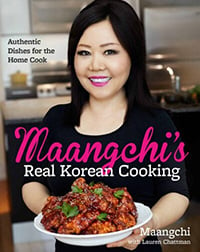
Which to get? Both are best sellers and either one is a good choice if you want to learn Korean home cooking. Maangchi's Real Korean Cooking has all the recipes for all the essential Korean pastes and sauces, but my second book Maangchi's Big Book of Korean Cooking has more recipes, more photos, and more variety.
Crispy and crunchy fried chicken Dakgangjeong 닭강정
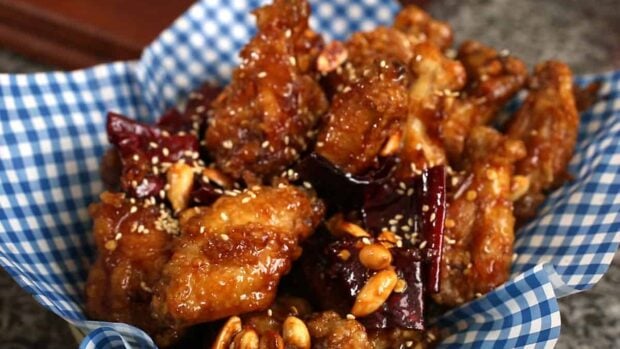
My fast and easy Korean fried chicken recipe is the crispiest and crunchiest fried chicken you will ever make. It’s still crunchy even days later!
New to Korean cooking?
Check out The Beginner's Guide to Korean Cooking & buy Korean ingredients
Let's go shopping in a Korean grocery store!
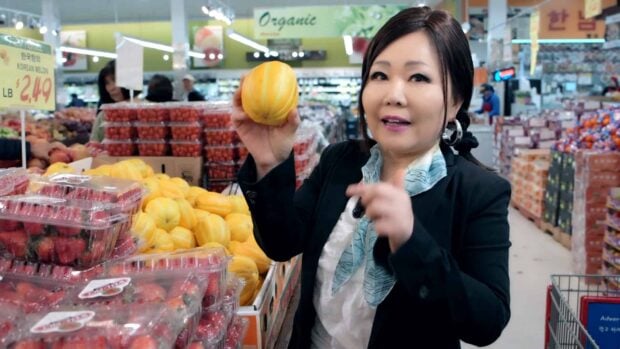
Napa cabbage kimchi Tongbaechu-kimchi 통배추김치
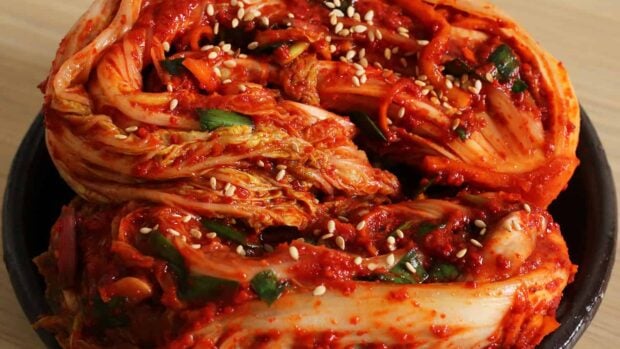
My classic, spicy, traditional whole leaf napa cabbage kimchi recipe that I’ve been using for years and years. Spicy, fermented, and delicious.
Latest Comments
Jjajangmyeon (noodles in blackbean sauce).
“This was my first time making jjajangmyeon for real instead of from instant. Your instructions and where to get ingredients was very helpful. It came out delicious and I love the texture of the noodles! Looking ...” by MochiMom
Pan-fried seasoned Spanish mackerel (Samchi-yangnyeom-gui: 삼치양념구이)
“It looks fantastic. My mouth is watering! I am adding this to my list to try making for my husband and kids. Thank you. ^,^” by Jshower1
Japchae (Sweet potato starch noodles stir fried with vegetables)
“I tried your cucumber salad last night and my daughters loved it! Thank you for sharing us your recipes.❤️” by Kring
Traditional Korean rice liquor (Makgeolli)
“❤️” by sanne
“Thanks, sanne!” by Maangchi
Doenjang-jjigae (Fermented soybean paste stew)
“Hi Kris, Making doenjang jjigae with fresh pumpkin harvested from your own garden sounds even more delicious! When I make soybean paste stew, I usually add shrimp from the beginning and let them simmer. This is because ...” by Maangchi
Hot pepper paste (Gochujang)
“No need to use a blender. There are two types of barley malt. One is in powder form, and the other is coarse. You can use coarse barley malt flakes in the same way. Mix it ...” by Maangchi
Spinach side dish (Sigeumchi-namul)
“Your sigeumchi namul looks so tasty! I'm so happy to hear that you tried out the spinach side dish from our newsletter. Happy cooking!” by Maangchi
“Thank you so much, Sanne! So it IS a type of bellflower. Well, darn. Could have used it. Just today I strained out my yakju made with the dried bellflower root, and also made some tasty ...” by speakfreely
“I saw this in the email newsletter on Monday, 4/1/24 and it looked delicious. Made it this evening, but I didn’t have any shredded red pepper to garnish with so I sprinkled some coarse ground red ...” by hodge.dunkin
Latest Korean grocery stores
Kingston asian super, s-mart in cardiff australia.
To make Korean grocery shopping easier for everyone, me and my readers have been making a list of local Korean grocery stores around the world. We started in 2010 and it's grown bigger and bigger every day. Want to find a store near you? Look here . Want to add your local Korean grocery store? Do it here ! I use my own website no matter where I go, to get my Korean ingredients. : )
Kimchi stew Kimchi-jjigae 김치찌개

Kimchi stew is one of Koreans’ most-loved stews. It’s warm, hearty, spicy, savory, delicious, and easy to make. As long as they can handle spicy food, I never met a person who didn’t like kimchi-jjigae!
Copyright © 2024 Maangchi LLC. All rights reserved. About your privacy .

Your Guide to the Best Korean Food: 66 Dishes & Drinks!

So much of Korean food was about patience as the volcanic soups settled down, building the diners’ anticipation with the bright colors of the red pepper and green onion, the smells. Nancy Jooyoun Kim, The Last Story of Mina Lee
Guys, FINALLY! Wondering what to eat in Korea? Whelp I’m finally writing my personal guide to the BEST Korean food you’ve got to try.
I know, I know the fact that this wasn’t written like two years ago at least is quite the oversight. For a while it was because I wanted to make sure I collected enough photos of the Korean food I wanted to talk about but I kept forgetting to take pictures… Then, I dunno, I just kept forgetting about the post! It’s hard to think “Ah yes, notes on this dish” when you’re ready to just start shoving food into your mouth.
Anyway, I’ve finally, after who knows how many Korean restaurants, sat down to write my personal list of the best Korean food you’ve GOT to try. Whether you’re actually in Mother Korea or dragging your friends to K-town and making them try soju, let this be your guide!
Food Tours & Cooking Classes in Korea
If you’re new to the food scene and don’t know what to eat in Korea, then these tours and cooking classes will help you get started!
Tours in Seoul
- Korean Food Walking Tour with BBQ Lunch
- Cooking Class with Traditional Market Tour
- Traditional Tea Ceremony Experience
- Korean Night Dining Tour
- Private Cooking Class & Dongdaemun Tour
- Master’s Traditional Cooking Class
- Hongdae Korean Cooking Class
- Bukchon Hanok Cooking Class
- Korean Cooking Class near Gyeongbokgung
Tours in Busan
- Nampo & Bupyeong Market Night Tour
- Jalgachi Market & Cooking Class
- Korean Cooking Class & Market Tour
- Busan at Night: Local Gourmet Walking Tour
Ultimate Guide to the Best Korean Food
I’ve always said Korean food is one of the styles of eating I never get sick of and I always crave at the most inconvenient times. There’s just such a variety, and they even put their own spin on other cuisines. I’ve cumulatively spent 3 1/2 years in Korea and have definitely eaten my fair share of unique dishes (though, no, nothing related to dogs or live octopus in this list), so here’s my ultimate list! The crazy thing is, I’m sure I’m forgetting a lot.
Now, this is not necessarily in order of my favorite to least favorite — just alphabetical! I did separate it a bit to make it easier to find things. Feel free to click on the links to jump down to each section!
Korean Dishes
Korean chinese, street food.
- Side Dishes

1. Bbyeodagwitang (뼈다귀탕)
This is also served as 뼈다귀 해장국, which is like saying “Bbyeodagwi Hangover Soup.” I don’t think there are too many differences if you see it in a restaurant. Anyway, this is actually the absolute top of my list of Korean dishes not just because it comes first alphabetically.
I still remember when Maggie told me about this restaurant in town called 25시 and how they served something similar to gamjatang but you get a lot more meat in your soup. We went on what I believe was a cold day, and it was love at first bite. There’s just something so freaking good about the spices mixed in with the pork bone and veggies. Like it’s got a bit more of a kick than gamjatang but it’s not just “Let’s throw a bunch of spices into this soup hide the fact that it doesn’t have a lot of flavor otherwise.”

2. Bibimbap (비빔밥)
The national dish of Korea! I feel like every time I’ve flown to Korea, I’ve been offered bibimbap as one of the dinner option. You get some rice and on top it’s a mix of cut up vegetables, gochujang, and either a raw or fried egg onktop.
Sometimes there’s meat or kimchi as well. The most famous place to eat it is in Jeonju , but personally I always preferred the ones I got in Namwon . Also I recommend getting dolsot bibimbap (돌솥비빔밥), which is when it comes in a nice hot stone bowl.

3. Boribap (보리밥)
Here’s one of the best Korean food dishes for you vegetarians! It’s basically rice, barley, and a bunch of veggies with some sort of sauce. I’ve only had it once on my Jogyesan hike .

4. Bulgogi (불고기)
Yum! I love bulgogi. At my old local grocery store, I used to buy a huge thing of it prepackaged to dump in a pan to make. Bulgogi is thin, marinated slices of meat (beef is the best). You want to sort of stir fry it or grill it with a mix of other vegetables. The best way to eat it is just straight or with some some ssamjang sauce and rice wrapped in a piece of lettuce. Ooh or as a sort of hot pot is pretty delicious! It’s called ddeokbaegi-bulgogi (떡배기 불고기) on the menu.

5. Dakdoritang (닭도리탕)
Dakdoritang! This was actually featured in my Facebook profile for ages. It’s similar to dakgalbi, but it’s more of a stew. You basically boil chicken with vegetables and spices, and it’s very spicy. I liked it more when I was younger and my stomach could handle it haha.
6. Dakgalbi (닭갈비)
You know, writing this has made me realize it’s been a hot second since I’ve had dakgalbi. It’s stir-fried chicken with veggies and gochujang sauce. I’m quite certain it’s another one of the first dishes I had in Korea. I remember wearing a little red apron to cover any splashing.

7. Ddeokgalbi (떡갈비)
Mmm I do love a good ddeokgalbi. It’s basically like short rib patty and the name kind of translates like “rib cake.” I’ve had it in Boseong and Damyang and probably a ton of times with school lunches, and I’ve always been a fan. The Boseong version was made with green tea!
8. Ddeokguk (떡국)
Talk about a comforting dish! I remember eating this really for the first time around Seollnal, Korean New Year, which is when it’s popular to eat. It’s made of thinly sliced ddeok or rice cake with broth and thinly sliced eggs, meat, and seaweed. So good! I used to also order ddeokmanduguk (떡만두국) which adds in some mandu as well.
9. Doenjangjjigae (된장찌개)
This is actually a dish I can make myself! Though I doubt I make it properly, I prefer my version, especially in the Korean winter . My last year, I made big batches of it and just poured into a glass jar to bring into work. Doenjang is a type of soybean paste that’s very salty. It’s kind of like miso but stronger (more on it below). Here’s how I make mine:
- Cut up the tofu. I make mine thinner and pan fry them so they stay stiffer in the soup but that’s not normal. Usually people will cube them and leave them like that.
- I get out my pot and put a little oil at the bottom. It depends on the vegetables I have on hand, but I’ll usually added in carrots, onions, and enoki mushrooms. I’ll usually try to add something green too — either bok choy or spinach. I then add water, bring it to a boil, and then add in the tofu.
- I’ll then mix in a spoonful of doenjang until it dissolves into the soup. You’re supposed to this first but obviously I don’t. Doenjang is strong , so it depends on how much of it you want. I don’t like adding it too early or too much of it because then the soup becomes too much.
There are so many things I don’t add into mine because I like it a lot simpler. In traditional recipes, there’s scallions, radishes, potatoes, peppers, and more.
10. Gamjatang (감자탕)
Gamjatang! It’s very similar to bbyeodagwitang and much more easily found around Korea. I feel like I’ve had different variations on it but the main similarity is that it includes pork bones and potatoes and some spices.

11. Gejang (게장)
Okay, this isn’t going to be for everyone. It’s raw crab marinated in soy sauce with some other flavors. I’ve eaten it in Yeosu and it was part of a fancy dinner the education office treated us to in Namwon once. I kind of love it, but I get that most people may not be a fan of eating raw crab!
12. Japchae (잡채)
Another dish I’d often get pre-packaged from my nearby grocery store! I love, love japchae. It’s made of glass noodles stir-fried with vegetables. The noodles are called dangmyeon (당면), and they’re so good and slippery! Apparently it used to be considered a royal dish, but it’s pretty common now. Most of the time it’ll be served as one of the many side dishes at restaurants.

13. Jeon (전)
Ohhh, jeon. Jeon is a sort of savory fried pancake here you mix the filling — veggies, meat, kimchi — in with flour and egg wash and then fry it flat in a pan. So simple and so, so delicious. It’s best eaten either before or after you’ve gone hiking. If you like alcohol, pair with a nice bowl of makgeolli. Or, if you’re like me, get a nice cold Chilsung cider to go with yours.
There’s a variety of jeon. You’ll hear pajeon (파전) used the most, and it just means spring onion jeon. By the sea, you’ll see haemul jeon (해물전), and kimchi jeon (김치전) is a particular favorite. There are a ton of varieties, but those are the three main ones you’ll see listed on menus. I personally have no favorites, I love them all, and I can eat a whole jeon by myself even though it definitely ought to be shared with at least one other person.
14. Jjimdak (찜닭)
I first heard of jjimdak when my friend, Lynsey, was leaving Korea! We were at church, and they asked her what she’d like her last meal to be. She said jjimdak, and wow does that dish need to be more popular. Basically, it’s a dish of chicken, glass noodles, and veggies. You simmer it in a syrupy type sauce and then eat. Apparently, it originally comes from Andong, so that’s even more reason I need to go! Try it here
15. Jokbal (족발)
Okay, now hear me out before you get grossed out. Jokbal is actually really delicious and chewy. Yes, it’s pig’s feet. However, unless you physically watch them chop the pig’s foot off, you wouldn’t be able to tell the difference! I had it for the first time when I went to a friend’s apartment for lunch. It’s usually served with some sort of gochujang or ssamjang sauce, lettuce, salt, and other veggies. Try it at this restaurant in Myeongdong

16. Kalbijjim (갈비찜)
Kalbijjim means braised short ribs in Korean. You can make it with pork or beef, and you boil or steam it and then add in other ingredients like veggies and sauces. It’s so, so tasty and tender!
17. Kalbitang (갈미탕)
Kalbitang is another favorite (can you tell I like stews and soups?). It translate to short rib soup. Basically you use the same thing as kalbijjim in terms of meat but you make a soup instead. There are different veggies an sauces you can use but there’s definitely always scallions in the kalbitang dishes I’ve eaten. It’s a super nice, comforting dish, especially in the winter, and it’s not spicy at all.
18. Kimbap (김밥)
Kimbap is like the ultimate cheap meal on the go! There are so many variations, and they’re all so delicious. I’ve probably made it a handful of times and eaten it more than I can count. Just go into any convenience store, and you’ll find little logs of kimbap in all types of flavors.
Regular kimbap kind of looks like sushi but bigger. You have a thing of kim, or seaweed, and then you spread out rice, veggies, and meat before rolling it tightly and sealing with some water. Another version you’ll find commonly is samgak kimbap (삼각기밥), which is just triangle kimbap. I don’t really like those as much, mostly because no matter how I try or follow directions, I always mess up taking mine out its wrapper.
As for which variations are my favorite — you can never go wrong with tuna or bulgogi kimbap!

19. Kimchi Jjigae (김치찌개)
Now, this isn’t always a dish I crave, but I do enjoy it when I eat it. Kimchi jiggae is kimchi stew so, yes, it’s decently spicy. At its most basic form, it’s made with kimchi, vegetables like scallions and onions, and tofu. Sometimes there’s also meat or seafood. It’s best to eat it with some rice. Take a small spoonful of rice and then dunk it into the soup.
If you go to a really good place, they’ll put a slice of cheese on top!
20. Korean Fried Chicken (치킨)
You have not LIVED until you’ve tried Korean fried chicken. One of the first things I do when I return to Korea is find the closest Kyochon and order a nice box of honey original.
The really popular thing to do is to have a nice chimaek (치맥), which is a combination of chicken and beer (maekju). However, I don’t like alcohol, so I eat mine with some Chilsung cider. Also, even if I did drink, Korean beer doesn’t exactly have the best reputation for taste… Try learning how to make it here!

21. Mandu (만두)
*Cue me playing the mandu handgame*
Can you get any more classic than mandu? It’s basically a dumpling but I feel like all Asian countries have slightly different dumpling variations. Like you just kind of know when you’ve got a Korean dumpling vs. a Chinese one?
Anyway, I cannot express how much I love mandu. Like in Namwon there was a tiny shop I used to get a bunch for 3,000 KRW from, and in Suncheon, I started buying a giant back of them to keep in my freezer! They’re the ultimate, “I don’t want to cook today, so I’m going to plop 4-5 mul-mandu into a pot and make a lil cup of soy sauce to eat them with.”
There are a ton of different mandu, but I like the classic mul mandu (물만두), which means they’re boiled. If you want them fried, they’re called gun mandu (군만두). I don’t dislike fried mandu, but I infinitely prefer boiled mandu, and it’s obviously healthier, so why not?

22. Miyeokguk (미역국)
By far one of my favorite soups all year round. I’ll never get sick of it! It’s seaweed soup, and I’ve had it for breakfast, lunch, and dinner more times than I can count. It’s such a simple dish made with a mussel-based broth, some seafoods like clams or oysters, some seasoning, and, of course seaweed. It’s supposed be high in calcium and iodine, so pregnant women are meant to eat it, and it’s served on birthdays.
If you’ve ever watched “Reply 1988,” this is the soup that Dong-ryong is always saying his mom makes the best but hasn’t had in years. Then you get this super cute scene where she finally makes it for him and sits, and he can sit and chat with her about what’s going on in his life.

23. Naengmyun ( 냉면 )
Best summer dish everrrrrr. I know a cold noodle soup isn’t exactly everyone’s cup of tea, but I love, love, love it. It originated in northern Korea, so a lot of times restaurants will call themselves after the cities it was most popular in, like “Pyongyang Naengmyeon” or “Hamhung Naengmyeon.”
The best naengmyeon is served in a stainless steal bowl with buckwheat noodles, a vinegar-y cold broth, thin slices of Korean pear and maybe cucumber, maybe some beef but definitely a boiled egg. While an icy broth, with literal chunks of ice, is nice, really, really good naengmyeon places serve theirs at almost a lukewarm temperature. In Namwon, Autumn took me to the best naengmyeon place that steeps its broth for like 24 hours!

24. Ramen (라면)
Can’t believe I wrote a post about the best Korean food to try and almost forgot to include ramen (or ramyun in Korean). The ultimate cheap eat, I don’t think I need to explain what is. Korean convenience stores stock a huge variety! I always go for the milder ones and add in an egg and some cheese on top.
One variety of ramen that I love is rabeokki (라볶이), which is a mix of ramen and ddeokbokki. Seriously so delicious even if it’s pretty spicy.
25. Samgyetang (삼계탕)
You know, I don’t eat samgyetang nearly enough, but it’s such a good soup for when you’re feeling sick. I think on my visit to Korea in April, I tried finding some when I got a horrible cold but I couldn’t find anywhere close enough.
It translates to ginseng chicken soup and is made with chicken, garlic, jujube, and ginseng. Don’t worry about it being remotely spicy — it’s all comfort. For some reason, it’s also a popular summer dish even though it’s warm.

26. Samgyupsal (삼겹살)
You didn’t think I’d make a whole list of what to eat in Korea and not include samgyupsal, did you? The name comes because of the 3 layers you see in the pork belly. Think of it like thicker bacon but better. Nothing beats a nice Korean BBQ with samgyupsal and kalbi! Grill, cut it up, and put in a little lettuce wrap with rice, ssamjang sauce, and maybe a piece of garlic and mushroom.
When Stacey and I were coming back from Gurye , the only restaurant open was a BBQ place near the train station, and the woman told us it was a minimum of 3 servings. Guess who had no problem polishing all that off?
27. Sundubu jjiggae (순두부찌개)
Sundubu jjiggae is more or less tofu stew. It’s usually a bit spicy as it’s made with gochujang or chili powder, and it’s a mix of soft tofu with vegetables and sometimes seafood. I personally prefer doenjang jjiggae, but I won’t say no if someone puts this in front of me!
I should note that Korean Chinese food is pretty similar to American Chinese food in that it’s not really Chinese. Like I don’t know any Chinese person who considers these dishes a staple in their cuisine!

28. Jajangmyun ( 자장면 )
Jajangmyun is another of my go-to comfort foods. Nothing beats just ordering a nice big dish of it and digging in. You make the dish with chunjang ( 춘장 ), a sort of sweet black bean sauce mixed with pork and veggies over a big bowl of noodles. If you order it, they’ll usually serve it plopped on top, allowing you to mix it into your noodles yourself. SO GOOD. It’s gets very messy, so if you got a restaurant see if they have an apron for you. Otherwise, wear an old T-shirt if you eat it at home. You don’t want to see what I look like eating jajangmyun by myself haha.
29. Jjambbong ( 짬뽕 )
I’m not the biggest jjambbong fan, but there’s a restaurant in Namwon that serves it, and it’s made perfectly. My co-teacher used to take me once in a while if we had to leave school early or sometimes the teachers as a whole just decided to go there. It’s pretty spicy and made with noodles, some sort of meat, and chili oil. It’s super easy to make the chili taste cheap and watery, so you have to be picky about where you go.
30. Tangsuyuk ( 탕수육 )
Whenever I got to a Chinese-Korean restaurant, we get an order of jajangmyun and tangsuyuk! It’s so freakin’ good. You fry some pork coated in flour and some vegetables. Then you pour over this sweet and sour sauce made with soy sauce, vinegar, sugar, some starch.
31. Yanggochi (양꼬치)
Or lamb skewers. These are actually a pretty recent phenomenon in Korea! They only start get popular around when I left Namwon, so by the time I came back to Korea a year later, I saw yanggochi restaurants all over! They’re so, so tender. You basically grill these thin lamb skewers and have different salts or spices you can dip them into. I sometimes will eat mine with rice.
I first tried them Mokpo when I stayed with my friend, Nicole, and her boyfriend and I even requested we go for my birthday haha. I was a little bummed thinking I wouldn’t be able to find a place when I moved to Suncheon. However, I discovered during our welcome dinner that there was a place less than 5 minutes from my apartment, and it also had the best eggplant dish ever. The only thing that kept me from going ever week was how expensive the dishes could be haha.
Do not miss out on the street food scene! Some of the best Korean food is found in little stalls scattered around the cities. If you’re not sure how to get started, try one of these tours:
- Dongdaemun Street Food Tour
- Seoul Street Food Tour
Otherwise, hopefully my picks for the best street food to try help you figure out what to try!

32. Bungeoppang (붕어빵)
Bungeoppang are those little fish-shaped breads you see in all the food stalls. Most of the time it’s red bean, and it comes from Japanese taiyaki. However, there’s a cream-filled version that is super addicting and tasty. I love those, but I hate the red bean ones. It’s because I once got a bungeoppang and thought it was chocolate or nutella. Let me tell you, nothing is quite as disappointing as biting into a pastry thinking you’re about to taste chocolate and instead tasting red bean. Blech.
Some places have bbungeobbang ice cream, it’s fish bread with its mouth open and then soft served ice cream coming out of it. Highly recommend that version as well if you spot it!
33. Steamed Corn (찐 옥수수)
I know this sounds pretty plain, but hear me out. Korean corn tastes a lot different from the corn you’re used to, especially in the US. It’s sweeter, so all a street food stand does is steam it!

34. Ddeokkbokki (떡볶이)
For the longest time whenever someone asked me what my favorite Korean food was, I’d say ddeokkbokki. I fell in love with it when I was a student, and I’m always eager to try some out!
The problem is that in recent years, a lot of food stands make ddeokbokki stupidly spicy, and it makes it really unpleasant to eat! I have to be careful where I get it, and usually it means just eating it when it’s homemade.
It’s a pretty simple dish — little tubular rice cakes with some fishcakes in a spicy sauce. When done well, it’s the most perfect dish. When done poorly, it just burns your mouth off.
35. Goguma (고구마)
Goguma is simply sweet potato in Korean. Oftentimes, more so in the cold months, you just see stands with goguma baked in foil. Trust me, it’s tasty. You don’t need to put anything on a roasted sweet potato, just wait for it to cool enough and start eating!
Special shout out to goguma lattes!

36. Hotteok (호떡)
Mmm hotteok. I actually tried making these at home I loved them so much. It was… a dry disaster.
Anyway, hotteok is also sometimes translated as pancake but it’s very different from jeon. Think of like a small, circular flat bread that has a sweet filling inside. A lot of times it’s made with brown sugar and cinnamon and nuts. I feel like the key to a good hotteok is to make sure the filling-bread ratio is fair. A lot of places have too much bread and not enough filling.
There’s a super good stand in Gamcheon that nails this!

37. Kyeran Bbang (계란빵)
Egg bread is more of a winter street food dish, and it’s not as commonly found as other dishes! They’re little oblong sweet breads with a fried egg inside or on top. It sounds oddly simply, but it’s really good, especially when you’re walking in the cold and spot one out of the blue!

38. Odeng (오뎅)
I know odeng is probably terrible for you, but it’s so good! It’s processed fishcake that’s served on a skewer and dipped in a sort of broth. It also sometimes pops up in banchan. I hate that I love it.
39. Soondae (순대)
Soondae, or blood sausage, is definitely not everyone’s cup of tea. Basically steam pig or cow intestine and then stuff them with things like glass noodles. I like mine with a bit of salt as well. A lot of people find it gross, but I say taste it for yourself to see!
Korean Fruits I Love

40. Hallabong (한라봉)
Hallabong is a signature fruit of Jeju . They’re in the citrus category, pretty similar to oranges. I’m really not sure of the difference, actually! But hallabong is delicious in every sort of shape and form — slushies, drinks, chocolates, soju… I like it best in some sort of smoothie or slushy.
41. Kyoho Grapes (거봉 포도)
Kyoho grapes are found in East Asia in general and actually originate from Japan. You’re supposed to eat them like this:
- Pop one in your mouth and break open the skin.
- Spit out the skin and seeds and eat the pulp.
42. Pears (배)
I love that the Asian pear’s Korean name romanized is literally “bae.” The same word is used for boats. So you could literally say “Eating baes with my bae on a bae,” and it technically makes sense in Konglish!
Puns aside, Korean pears are a really sweet. You don’t eat the skin, and instead peel and cut them to eat. I don’t really like regular pears, but I could eat Korean pears all the dang time.

43. Persimmons (감)
I don’t know about you, but I didn’t really grow up eating persimmons. However, it’s one of the foodie symbols for autumn in Korea . There are two kinds of persimmons — hachiya (딻은감) and fuyu (단감). I like them both, but they’re quite different. The hachiya is a darker orange, more like red-orange, and the fleshy part is very soft. It’s quite messy to eat, just a warning, and it goes bad a lot quicker. The fuyu is more common, and the flesh is harder (more like an apple). Just peel and eat!

44. Strawberries in the earliest seasons (딸기)
Nothing as is a delicious as strawberry when it’s early spring in Korea ! There’s so sweet, I could eat a whole box of them in one sitting. They gradually get a bit more sour as the season goes on, so the best time is early on.
There’s also a ton of variety of strawberry-flavored food like strawberry milk or strawberry lattes!
Side Dishes/Banchan
45. danmuji ( 단무지 ).
I always like have some danmuji, or yellow pickled radishes, as a side dish because it’s kind of refreshing if you’re eating a heavier meal! Plus I’ll always think of Siwon in “She Was Pretty” making funny faces with them!

46. Kimchi (김치)
Specifically Kimjang Kimchi. I feel like if I made list of the best Korean foods to try and I didn’t include kimchi, I might as revoke any claim of expertise I have. Kimchi is Korea and Korea is kimchi!
Anyhow, kimchi is fermented cabbage, and it’s served with every single meal you’ll ever get in Korea. It can be quite spicy and at the very least it’s pungent. It goes wayyyy back to the Three Kingdom period.
Personally, I’m not crazy about kimchi, though I’ll eat some when it’s place in front of me. The only kimchi I’ve actually gotten excited about is kimjang kimchi, which is a way of saying it’s freshly homemade. Since most families make kimchi to last all year in November/December, you’ll find kimjang kimchi more in the early winter days and pretty much only if you’ve got a Korean friend who’s mom sends them some. A long time ago, I actually wrote a whole post about kimchi !
Try making your own kimchi with this cooking class in Myeongdong .
47. Kyeranjjim (계라찜)
Kyeranjjim simply means steamed egg bowls. They usually come with BBQs and I’ve always been a fan! I mean if you like eggs, you’ll like kyeranjjim. If you don’t, you won’t.

48. Spinach Dishes (시금치)
Koreans do know how to treat spinach, mmmm. One of the side dishes I always reach for are the spinach based ones. They’re not usually spicy, and they’re made by blanching the spinach with some soy sauce, garlic, and sesame oil.
Gotta have a section for these three sauces! They obviously go with most of the dishes above, but really I could have a container of any of them in my fridge, pull out some carrots, and start snacking. Hummus, who?
49. Gochujang (고추장)
Gochujng is a red chili paste that’s a bit fermented. It’s both spicy and sweet, and you can often use it to marinate different meat or in stews.
50. Doenjang (된장)
Doenjang translates to soybean paste. It’s got a pretty pungent smell and is made from a fermented bean paste of soybean and brine. A lot of times it’s actually a byproduct of soy sauce. It’s quite similar to miso but stronger. I have a container at home to make some jjiggae with and to just snack on veggies with.
51. Ssamjang (쌈장)
What do you get when you mix doenjang, gochujang, sesame oil, and other ingredients together? Ssamjang! It’s usually ssamjang that’s served with BBQ. I always mix it up with gochujang, but I’d say its a bit sweeter and obviously has some more flavors mixed in.

52. Bingsu (빙수)
The ultimate dessert to survive summer in Korea . In its most basic form, bingsu is shaved ice with different toppings and some condensed milk. Traditionally, you eat it as patbingsu (팥빙수), which means it’s topped with red bean as well as some ddeok and nut powder. As you saw from my bbungeoppang section, I am not a fan of red bean.
Instead, I love the more modern takes on bingsu from melon bingsu to my favorite, from Sulbing, blueberry cheesecake bingsu!
53. Convenience Store Ice Cream
Don’t @ me. Instead, imagine this — you’re walking home from work on a hot summer day. You’re about to reach your apartment, and you walk by your closest convenience store. Right by the door is an array of delicious little ice cream bars all for 2-3,000 KRW or less.
You bet I’ve stopped by multiple times for an instant cool off! I go between craving the melon bars, this swirly chocolate ice cream that comes in a container reminiscent of poop, and a vanilla shake that comes in a sort of juice box.

54. Honey Bread (허니브레드/꿀빵)
Mmm honey bread. I love going to a cafe in the winter and getting a nice hot latte and honey bread. If left to my own devices, I probably can eat it all myself, but usually I split it with at least one other person. It’s really simple to make — just thickly cut some bread, cut squares in the bread, and then drizzle honey. Butter the top, bake for 10 minutes, and top with some whipped cream, almonds, and chocolate!
55. Songpyeon (송편)
I’m not the biggest fan of rice cakes, but songpyeon is the exception. I’ve really only ever seen it served around Chuseok, usually with my school lunch. They’re little half moon rice cakes with sweet fillings, and you usually see them in white, green, or pink coloring.
I should note, that while Americanos are a big part of Korean culture, I’m not including coffee and lattes because there’s not really a unique Korean twist on the recipes. However, the one thing that makes coffee culture special is that the abundance of cute cafes! You can check out my big post on the trendiest cafes in Seoul as well as some more specific places I’ve visited like the Dreamy Camera Cafe , Enrogel Tea Pot Cafe , or the Stylenanda Cafes.
56. Bori-cha (barely tea)
Barley tea is something I usually get when I want a drink while traveling. Instead of water or Vitamin C, I reach for boricha. It’s not the tastiest drink in the world and most people I know hate it, but it doesn’t bother me as long as I drink it cold. I read somewhere it’s good for your skin, but so is just staying hydrated in general!
57. Brown Rice Green Tea (현미녹차)
It sounds gross, but brown rice green tea is so nice and cozy! It’s found in almost every single teacher’s lounge right next to the little Maxim coffee sticks. You can actually buy a box of it on Amazon.
58. Chilsung Cider (칠성 사이다)
My sweet addiction! Chilsung cider is a soda in Korea, and it’s similar to Sprite but way, way better. I got pretty addicted to it my last summer in Namwon and would drink a bottle of it a day. Whenever I’m back, I limit it to once or a week or a special occasion so I don’t get out of control!

59. Green Tea (녹차)
Considering Korea has three prominent green tea fields in Hadong, Boseong, and Jeju, it should be no surprise that green tea drinks and products are quite popular. I had a nice big bag of Boseong leaves I’d make in my French Press and then stick in the fridge so I always had some iced green tea!
And, of course, indulge in all the green tea frappes, lattes, and ice cream!
60. Maesil Tea (매실차)
Mmm maesil. I highly recommend that when you go to the sauna for your girls’ sesh, order some maesil to drink while you’re soaking in tubs or in the steam rooms. Maesil is a sort of plum in Korea — it’s what the maehwa trees produce. People will take the plums and dilute them into a sort of syrup, so the sweetness offsets the tartness. Then the syrup is mixed with water, and boom! I’m obsessed with it.
61. Misu (미수)
Ooh you know summer is here when the cafeteria serves you up a little cup of misu with ice for dessert. Misu is a sweet drink made with sort of powder made from different grains. Mix it with water or milk and even add in a bit of sweetener if you like.
62. Omijacha (오미자차)
Omijacha is another big favorite. It’s name translates to “five flavors tea” because in one sip you’re supposed to taste the tea’s sweetness, sourness, bitterness, saltiness, and pungency. It’s made with these kind of magnolia berries. I prefer it cold but I still wouldn’t turn down a hot cup.
63. Sikhye (식혜)
Sikhye is one of those drinks to get at the sauna. It’s going to sound gross but it’s actually delicious! Basically you want to pour a sort of malt water over cooked rice. A lot of times, restaurants do this with the leftover rice at the bottom of a bowl. It’s steeped and then boiled until sweet. If you’re not planning to go to the sauna or get it after your meal, you can always buy canned sikhye at the convenience store!
64. Yujacha (유자차)
Lemon tea! This is one of my favorite drinks, especially in the winter. I actually went to the store and got a big jar of it to make tea at home with a few times while I lived in Korea.
65. Soju (소주)
Someone I studied with once described soju as the following: “It tastes like it wants you to have a hangover tomorrow.” For some reason that has always made me laugh, so when I try to explain it to anyone unfamiliar, that’s what I say. Soju is made from rice, wheat, or barley and is a clear liquid. Cheaper soju is often made with other starches.
There are a lot of variety of soju, and while I don’t drink alcohol, I’ve tried yogurt and fruit varieties when I was student and recently a peach soju in the US. The original soju tastes absolutely terrible, but the fruit and yogurt ones are pretty good, especially if you like alcohol! I’ve heard the soju from Hallasan is the best.
Drink it in glasses slightly bigger than shot glasses with some BBQ. If you really want to, ahem, speed up the drunkenness, do a thing of soju in beer/maekju! It’s called somaek (소백).
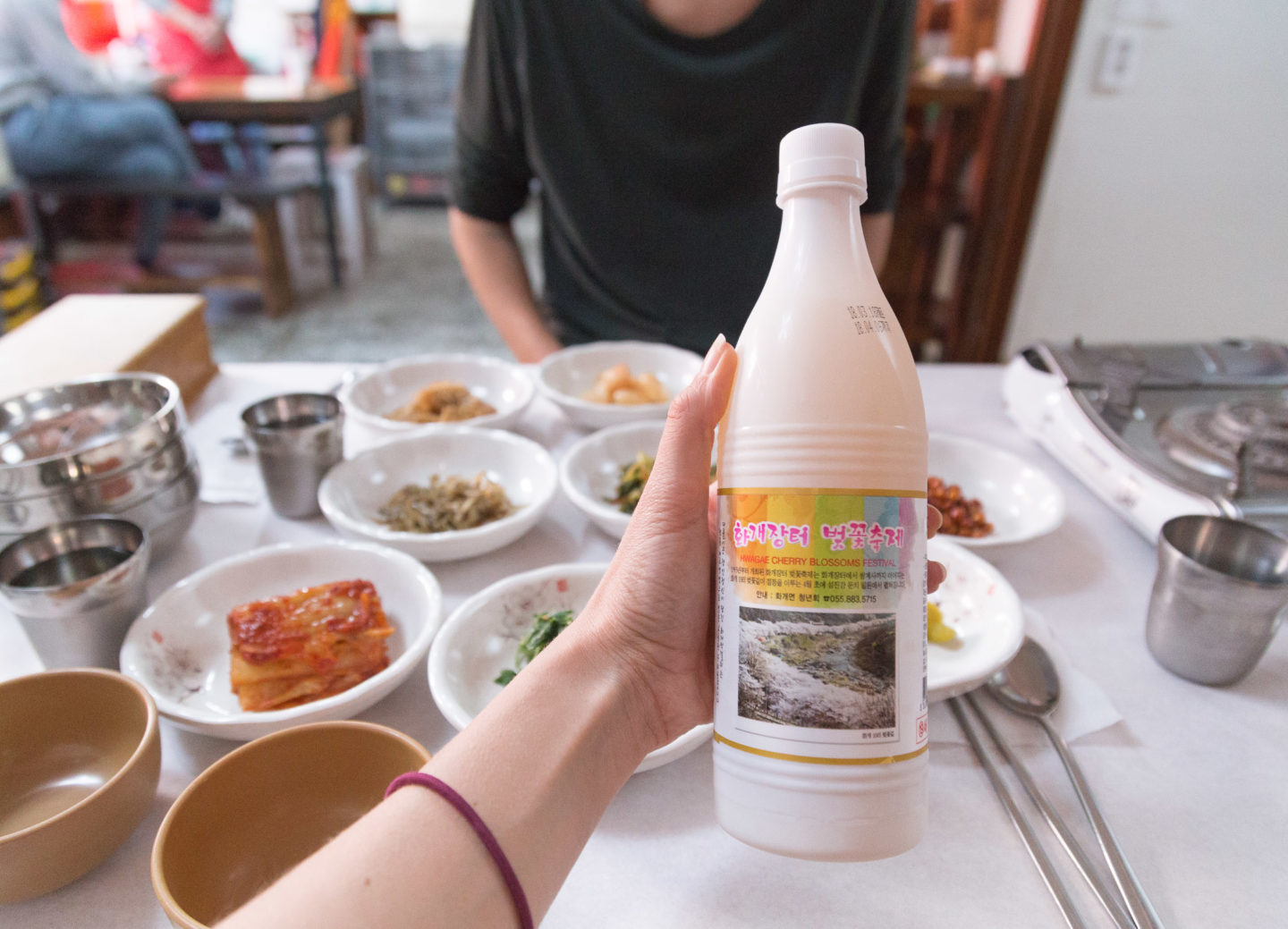
66. Makgeolli (막걸리)
Makgeolli a rice wine and it looks white and cloudy when drink it. Typically, you drink it from a small bowl, and it’s best after a hike with some jeon! I’ve only had a sip of it once or twice, it’s not really for me. Try making your own makgeolli with this class
Whoo-weee that was a long one! Well, 66 dishes and drinks later, that’s my guide to the best Korean food! Would you believe I start this post thinking I’d only write down 20 things?! Pfff
for more on korea
If this is your first time in Korea, check out my bucket list of beautiful places to visit in Korea. Then I recommend reading my giant list of Korea travel tips as well as this trip planner guide with all the logistics. One of my best pieces of advice is to learn some Korean including how to read Hangul and a few basic phrases. It’ll make your life much easier, especially away from the city.
I also have a post with all the apps I download when I go since normal apps like Uber and Google Maps don’t work as well. Speaking of, I also recommend arranging for a SIM card ahead of time if you have an unlocked phone. It’s cheaper than showing up in person.
You may also find my itinerary guides helpful! I’ve got 4 sample itineraries for 2 weeks , the ultimate 1 month itinerary , and a very efficient 7 day itinerary.
As for ways to be prepared, I recommend having some sort of insurance. I use either World Nomads of Safety Wings depending on what I’m doing. You can get a quote for World Nomads here and a quote for Safety Wing here .
If you’re a women traveling and still have questions, feel free to join my Facebook group ! It’s where it’s easiest to contact me.
What’s your favorite Korean food? Let me know if I’m missing it!
share this on pinterest

want to support?
I’m always grateful when friends and readereach out wanting to support There She Goes Again . Truthfully, I’m just happy my posts are helping people travel! If you’d like to support the blog, here are some companies and brands I’m affiliated with. Simply click the links, and I receive a small commission at no extra cost to you!
- Booking (Hotels)
- Sixt (Car Rental)
- Klook (Tours)
- Viator (Tours)
- Get Your Guide (Tours)
- Trazy (Korea Tours)
- Tiqets (Entrance Tickets)
BLOGGING / SOCIAL MEDIA
- WPX Hosting (Advanced)
- Bluehost (Beginners)
- Lezé the Label (Clothing)
- Printfresh (Pajamas, etc)
- Promptly Journals
- Encircled (Clothing)
- Girlfriend Collective (Athleisure)
- Birkenstock (Sandals)
- Bookshop (For Local)
- Amazon Books
Hi Samantha,
My family and I have been to Seoul many times, as it is one of our favorite travel destinations. Each time we visit, it feels like our first time—so many things to do, to see, and to eat. Each time we’re in Seoul we pick one Korean dish and try to find the best version of it. This trip it’s Ddeokkbokki! In one of your posts, you referred to yourself as a “ddeokkbokki snob.” I am curious to know if you have a favorite place in Seoul for ddeokkbokki and if you could share your recommendation(s). I’d love to add it to our list of places to try.
Your site is amazing. It has been so helpful as I am planning for our visit to Seoul in a couple of weeks. Thank you for all of the research, tips, and great ideas.
Happy Traveling, -Timothy
Hi Timothy! Thank you so much for your comment and I’m glad you love Seoul as much as I do. I’m not too sure as the only place I really ate it in Seoul was when I studied there over 10 years ago at a random place next to my university. I do think you can’t go wrong in any of the food markets – I was pleasantly surprised by Gwangjang Market on my last visit! It’s obviously a popular spot for tourists and locals but the food is still quite good. I’d also recommend commenting or shooting my friend Hallie over at @thesoulofseoulblog on IG as she lives there and she’d know better!
If you do happen to go to Busan, I still think the ddeokbbokki I got in Nampo-dong market is easily one of the best I’ve ever had.
Leave a Reply Cancel reply
Your email address will not be published. Required fields are marked *
This site uses Akismet to reduce spam. Learn how your comment data is processed .

A Culinary Guide to South Korea (+ Jeju Island)
By: Author Willow Heath
Posted on Last updated: 16th January 2024
If there’s one country’s food that has taken off on a global scale this past decade, it’s Korean food. Second only to kpop music, the cuisine of South Korea is one of the nation’s biggest draws, and rightly so. Korean food is varied, indulgent, experimental, and exciting. And when you visit South Korea, what to eat and where to find the best food are big questions to ask.
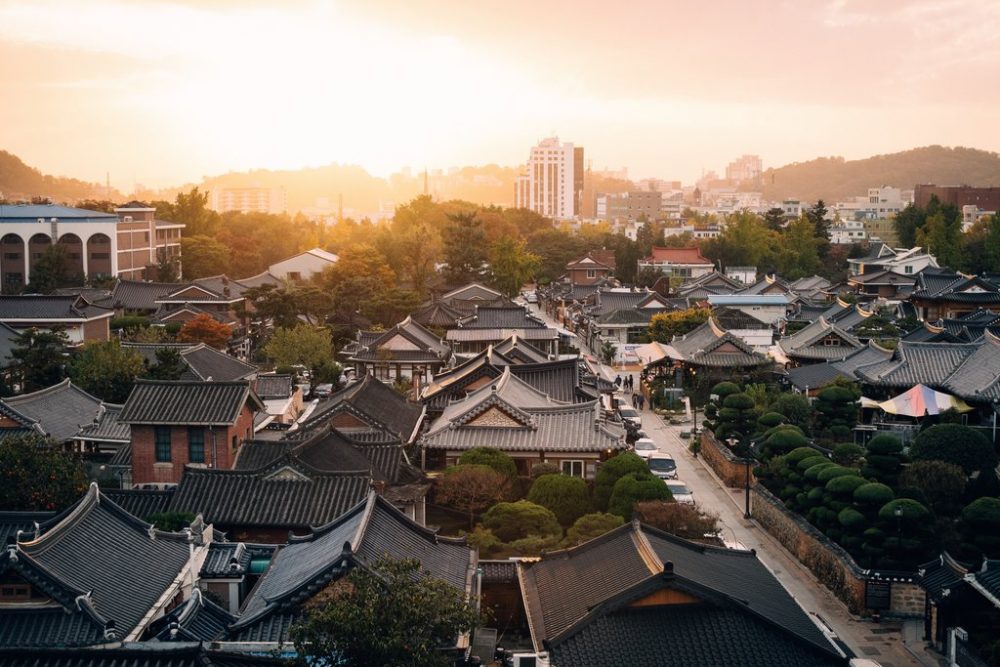
Most of Korea’s most famous foods come from all over the country, with most towns and cities having their own proudly local dish. Taking a culinary trip around South Korea to learn the origins of these dishes, and to sample the best local Korean foods , is one of the best ways to explore South Korea.
While travelling to South Korea isn’t possible for many of us at the moment, this culinary journey will give you some ideas for a food themed road or train trip once travel gets back to normal. South Korea is such a diverse and beautiful country that we had the pleasure to call home for a year and we can’t wait to show you why a visit to South Korea should be your next trip.
Read More: Best Korean Ramen (Ramyeon)
A Culinary Guide to South Korea: What to Eat and Where
Here is your full and complete culinary guide to South Korea: what to eat and where to find it. We’ll explore the country’s biggest and best culinary locations and what each place has to offer in terms of local cuisine.
Incheon: Jajangmyeon

We begin our culinary journey around South Korea in the town of Incheon. Perhaps most famously known as the Seoul satellite city where the nation’s international airport is found, Incheon has a long and fascinating history as a port town, and so the airport only continues that trade and travel tradition.
Because of its history as a port town, Incheon is home to a thriving Chinatown – the most famous and thriving Chinatown in South Korea. And it’s in this Chinatown that many Chinese-inspired Korean dishes first originated. The most popular and celebrated of these is, without a doubt, jajangmyeon .
Jajangmyeon is a filling and satisfying dish of Chinese style noodles, diced pork, and a thick black sauce known in Korea as chunjang and in China as tianmian . The sauce is made from sweet bean paste and has a very mild flavour. While the dish was first brought to Korea by a Chinese chef living and working in Incheon, it can now be ordered at any local restaurant in Seoul, but Incheon Chinatown is still the best place to try this fantastic dish.
Seoul: Bulgogi, Bbudae jjigae, & Dakgangjeong
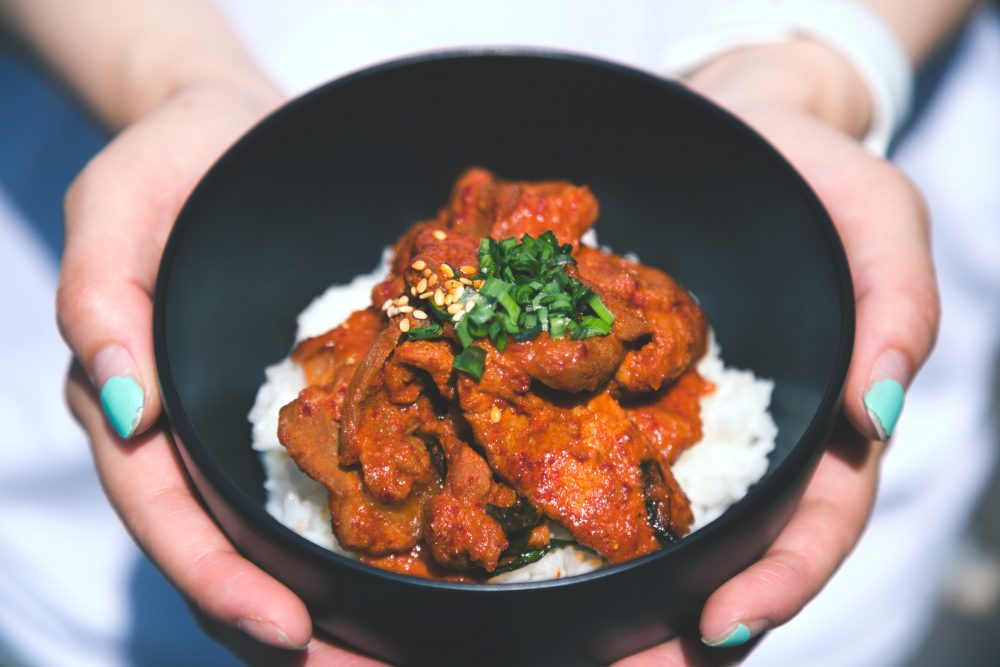
Seoul is a city that needs no introduction . The capital city of Korea is also the largest and most populous city in the Korean peninsula. Being the capital city , Seoul naturally has a wealth of its own local dishes. What’s surprising, however, is how many of these dishes are either fairly modern inventions, or have very unique origins.
A little history is needed to appreciate some of the dishes we’ll talk about here. After the Korean War ended in 1953, Seoul was heavily occupied by American military forces (it still is to this day, in fact), and those soldiers had a considerable impact on the local cuisine.
On top of this, Seoul’s proximity to the new and dramatic border between North and South Korea means that it is a refuge for many escapees from North Korea. What is considered by many to be Korea’s most famous dish – bulgogi – actually originated in North Korea (or, rather, the northern parts of Korea from back when it was still one complete nation).
Refugees from North Korea helped to popularise the dish and, today, it is a celebrated and dish in South Korea.
Bulgogi is a dish of barbecued strips of beef or pork (the name literally translates to “cooked meat”) similar to Japanese yakiniku . Various cuts of beef can be used, and it is often served with leafy vegetables that can be used to handle the meat. Rice can also be served as a side, and bulgogi is best enjoyed with a few cold beers.
As for how the American military, and western cuisine in general, has influenced Seoul’s local cuisine, look no further than dakgangjeong . This is a dish of sweet, crispy fried chicken . The young people of Seoul wholeheartedly adore fried chicken, and it’s in Seoul that you’ll find the biggest variety of fried chicken in the whole world.
It’s hard to overstate just how delicious, and how popular, dakgangjeong is in Seoul. There are countless dakgangjeong restaurants in Seoul alone , and all of them offer a huge variety of dakgangjeong dishes.
You have fried chicken on or off the bone, and the sauces/toppings range from cheese to sweet or spicy sauces, soy, garlic, and more. Seoul is the true home of fried chicken.
Finally, Seoul is also where you can find the origins of bbudae jigae (army stew). The stew perfectly combines Korea’s most popular food — kimchi — with American pork staples like spam and sausages. Bbudae jigae was created after the Korean War by mixing surplus army rations with locally sourced foods.
To this day, spam is considered a kind of strange delicacy in Korea and is given by bosses to workers as a thank-you gift.
Read More : Enjoy the street food of Myeongdong in Seoul
Sokcho: Fresh Seafood
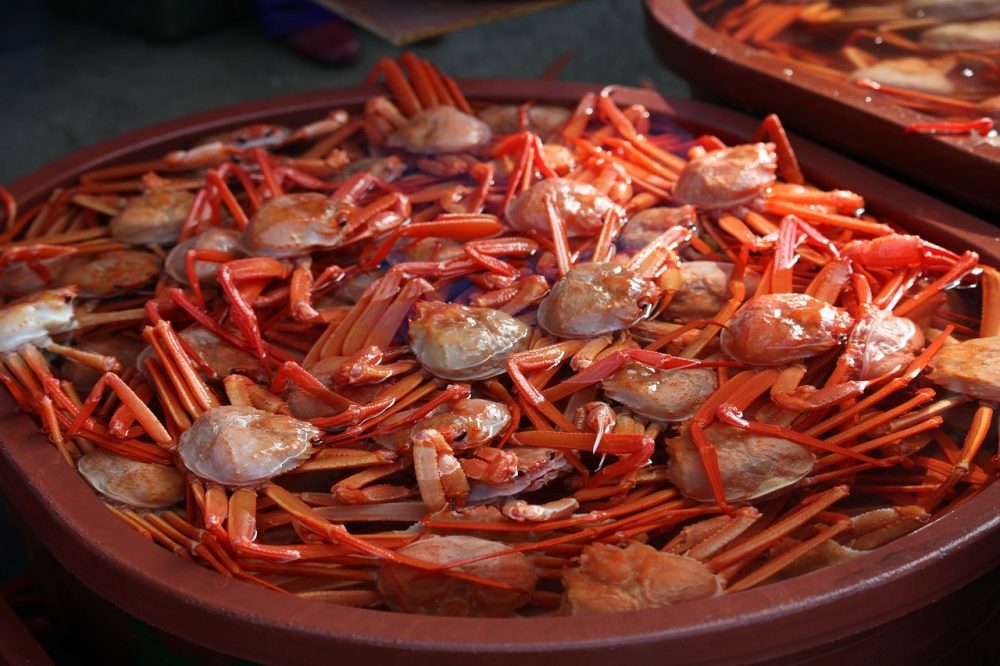
Sokcho is a port city that has its ancient roots in a fishing village. Today, it’s a natural tourist spot in South Korea thanks to its close proximity to Seoraksan National Park . Seoraksan is home to South Korea’s tallest peak, and is an endless, rugged wilderness of wild, craggy peaks and lush vegetation: a hiker’s paradise.
Sokcho itself is famous for its fresh seafood , caught by local fishermen just offshore. In fact, Sokcho offers visitors a colossal seafood market known as Sokcho Jungang Market. This heaving marketplace has more than four hundred seafood stalls , each serving up enormous, freshly-caught squid, crabs, shrimp, and so much more.
If you’re looking to get a vivid image of Sokcho before visiting, definitely read Winter in Sokcho by French author Elisa Shua Dusapin, one of the best books to read before visiting South Korea .
Andong: Soju & Jjimdak

Andong is a beautiful, peaceful town on the east side of central South Korea. If you’re looking for a place in Korea that really celebrates its folk traditions, Andong should be at the top of your list. Andong Folk Festival, for example, is a yearly tradition, held during October, that celebrates the local art history of the region. The local university even specialises in Korean folk history.
One of the coolest culinary aspects of Andong is its soju. While soju is the staple alcohol of South Korea (like sake in Japan and baijiu in China), the Andong brand of soju is considered the finest in all of South Korea. If you want to experience soju at its finest, you need to visit Andong.
As for the food, Andong has a culinary history to match its folk history. The town’s most famous and celebrated dish is easily jjimdak : a Korean stew made from steamed chicken and mixed vegetables marinated in a soy-based sauce (known in Korea as ganjang ). This local chicken stew is an absolute delight, full of subtle flavours and extremely nourishing.
Jeonju: Bibimbap & Kalguksu
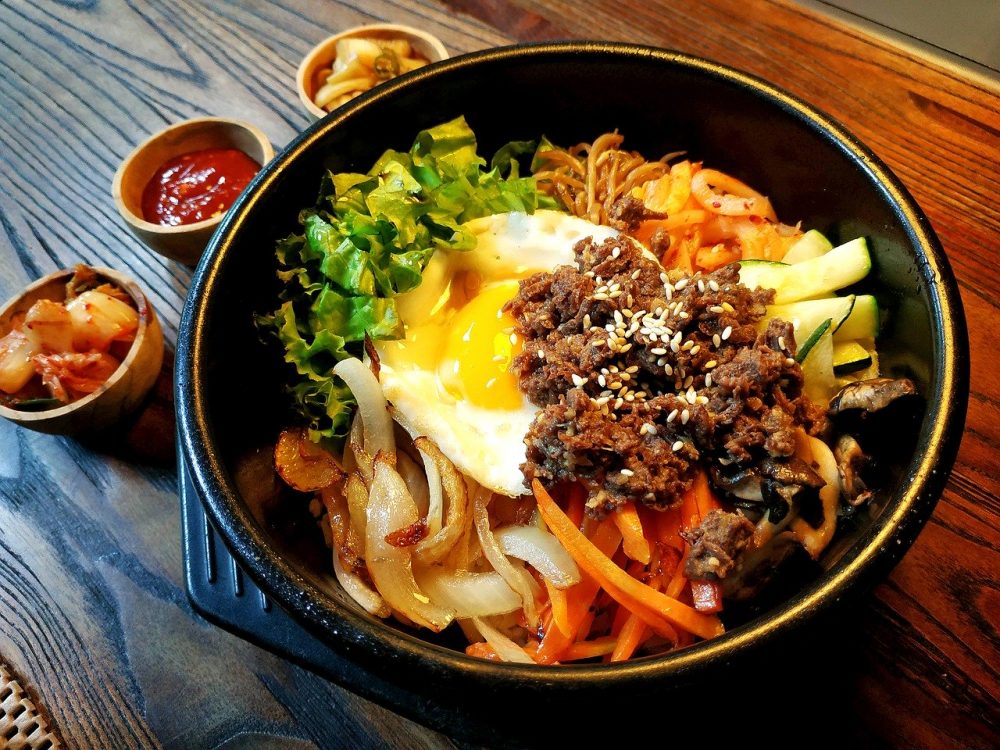
Jeonju is a small city near the West coast of Korea. The city is predominantly known to tourists for its Hanok village. These are vintage villages populated by traditional Korean-style houses , sort of like Japan’s Edo period buildings found in the Gion district of Kyoto.
Hanok villages are gorgeous, and they can be found in multiple cities around South Korea, including Seoul. But the most impressive Hanok village is to be found in Jeonju. Jeonju is also the h ome of Korea’s most famous dish: bibimbap . Bibimbap is to Korea what a roast dinner is to the UK: a rounded, wholesome meal of meats, vegetables, and sauces.
Bibimbap is a hefty rice bowl topped with mixed vegetables ( kimchi , radishes, carrots, etc), a generous helping of meat (traditionally beef), and a raw or fried egg.
Bibimbap is also flavoured with a chili pepper paste known as gochujang . Needless to say, there’s never a better place to try a dish than its own home, so trying bibimbap in Jeonju is a necessity and a privilege. Jeonju even hosts a yearly Bibimbap Festival to celebrate the national dish.
It’s fairly unclear where kalguksu originates from, but the most famous version of this dish comes from Jeonju. Kalguksu is one of the very best Korean noodle dishes .
For comparison, you can think of kalguksu as Korean ramen noodles, though they are still very much their own thing. Kalguksu is made from wheat flour noodles served with a seafood broth made from anchovies and kelp. The dish is often finished off with potatoes or scallions.
Daegu: Dongindong Jjim galbi
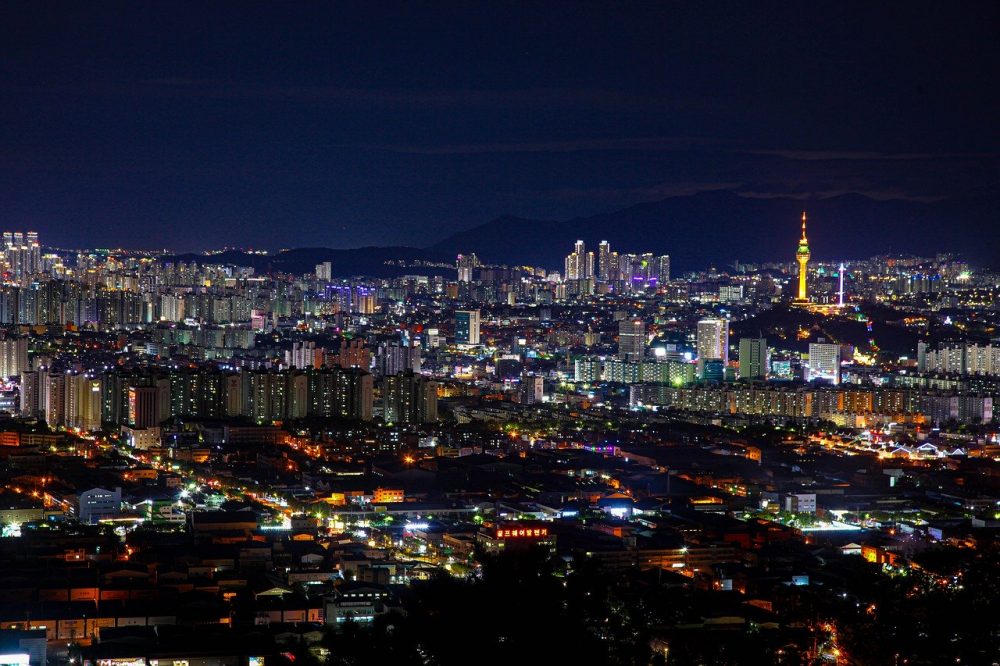
South Korea’s fourth-largest city, Daegu, is a thriving metropolis that combines traditional Korean culture with the most exciting aspects of modern Korean life. Since the Korean War, this city has been the hub of Korea’s electronics and textiles industries, making for a rich and thriving metropolis and one of the best cities to visit in South Korea .
Daegu also has a fairly secretive culinary history, with local dishes that many people have never heard of. One of these dishes is dongindong jjim galbi , a mouth-watering dish that will excite the taste buds of any ambitious carnivore. Dongindong jjim galbi is essentially a large metal dish filled with beef ribs. The ribs are seasoned with pepper and garlic, and the dish is traditionally enjoyed with a generous amount of Korean soju to really elevate the spices.
Gwangju: Ori-tang

Gwangju is a name that may be familiar to many people with a passion for Korean cinema or an interest in Korean history. The nation’s six-largest city was home to an enormous and transformative pro-democracy uprising in the 1980s.
This uprising was captured amazingly in the fantastic Korean film A Taxi Driver . Today, the legacy of that uprising, which changed the future of South Korea, can be seen in Gwangju’s 5.18 Memorial Park.
As for the city’s local cuisine, Gwangju is perhaps best known for its ori-tang , a kind of Korean duck stew . With duck being one of the softest and most flavourful meats, this is a true local delicacy in Gwangju. Ori-tang is often spiced with chili powder and the broth thickened with perilla seeds.
Boseong County: Green Tea Specialities

One of the natural wonders of South Korea is, without question, Boseong County. This area of South Korea on the nation’s south coast is home to a seemingly endless sea of tiered green tea fields. A mountainous region at the edge of the sea, populated by green tea fields: there may not be a more picturesque place in all of Korea.
Naturally, it should come as no surprise that Boseong County’s culinary speciality is green tea. Both Korea and Japan are famous for their green tea-flavoured products , and in Boseong County you can find everything from ice cream to noodles flavoured with green tea. If you’re a fan of green tea and its flavour, you’ll be in heaven when visiting Boseong County.
Busan: Dwaeji Gukbap & Ssiat Hotteok
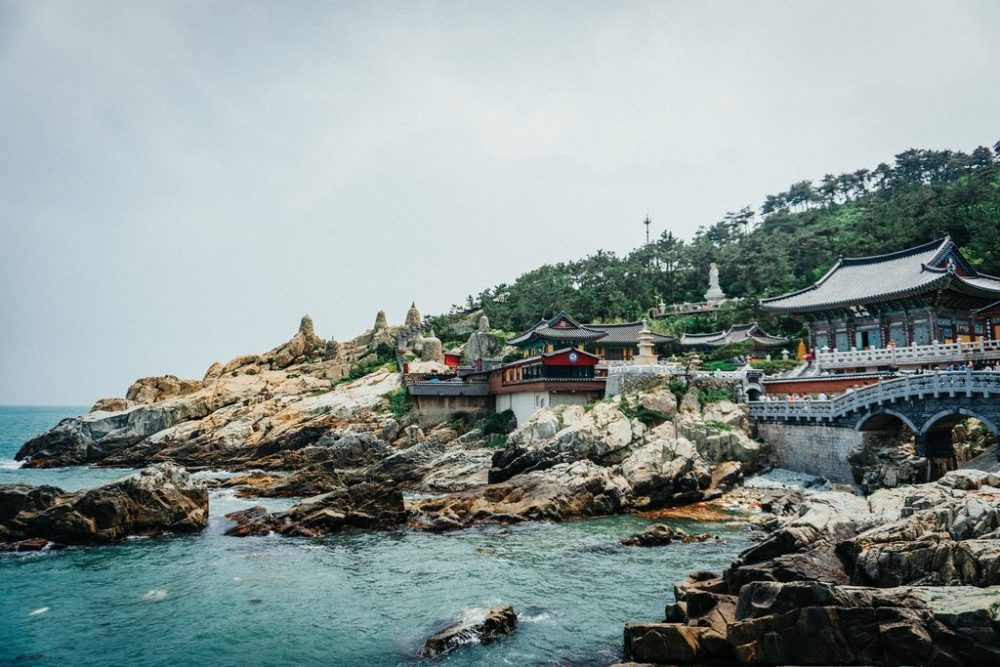
Busan is the southern capital of Korea: a thriving, bustling city on the southern edge of the country. A place of iconic beaches, fantastic bars and restaurants , and a temple that hangs over the rocks at the edge of the water (see photo). There is so much to love about Busan, and one of the many things to enjoy is the city’s cuisine.
Dwaeji gukbap is a soup local to Busan, with its primary ingredients being pork and miso, flavoured with soy and sesame oil. It’s a soothing, flavourful, and friendly dish that almost anyone can enjoy. It’s a favourite amongst locals and one of those dishes that isn’t overly popular across the country, so you really do need to visit Busan to get the true dwaeji gukbap experience (like you needed another reason to visit Busan).
Visit any street food market in Seoul, and you’ll have plenty of chances to try hotteok : sweet Korean pancakes. But the city of Busan has its own unique take on hotteok , known locally as ssiat hotteok . The only real difference is that ssiat hotteok are filled with local seeds that are extremely healthy and add a welcome texture to the hotteok .
Jeju Island: Black Pork

Jeju Island is a popular tourist destination for locals and foreigners alike. In many ways, this island off the south coast of Korea is a land and culture all its own. In fact, ask anyone native to Seoul and they’ll tell you that it’s far easier to understand the modern North Korean dialect than it is to work out what the islanders of Jeju are saying.
Jeju is a perfect island paradise, and home to an enormous wealth of unique local foods. The most well-known and beloved of these dishes is easily Jeju black pork.
This is a local kind of pork sourced from Jeju black pigs ( heuk dwaeji ). The meat is traditionally barbecued in the same way as beef is in a traditional Korean barbecue. Jeju islanders and mainlanders alike all attest that Jeju black pig pork is the finest pork in the entire Korean peninsula.

25 Traditional Korean Foods You Must Eat in Korea
For foodies like me, the best way to get immersed in a culture is to food-crawl our way through it. Food is a valuable cultural asset and this couldn’t be truer in South Korea, a country now known for its amazing food.
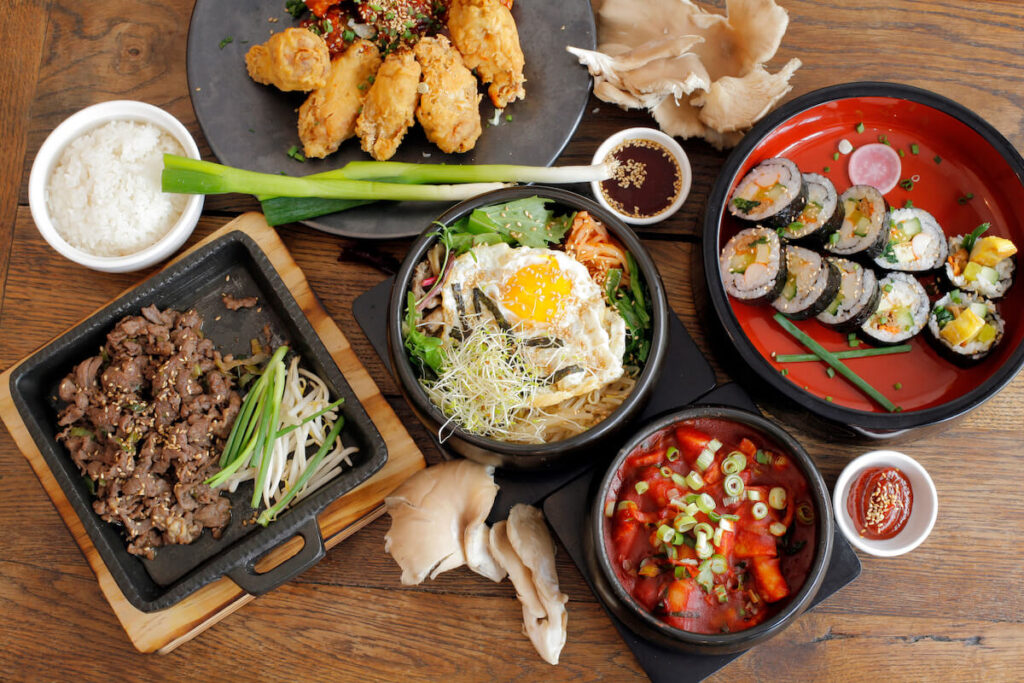
However, you would be sorely missing out if you just eat the popular dishes such as Korean bbq, chikin , kimchi , and ramyeon .
For a timeless food culture experience, eating traditional Korean foods is a must. These classic Korean dishes open a window into Korea’s culinary past and its customs. These are the foods that you’ll find in Korean homes and restaurants, traditional markets, and during Korean holidays.
Table of Contents
Classic Korean main dishes
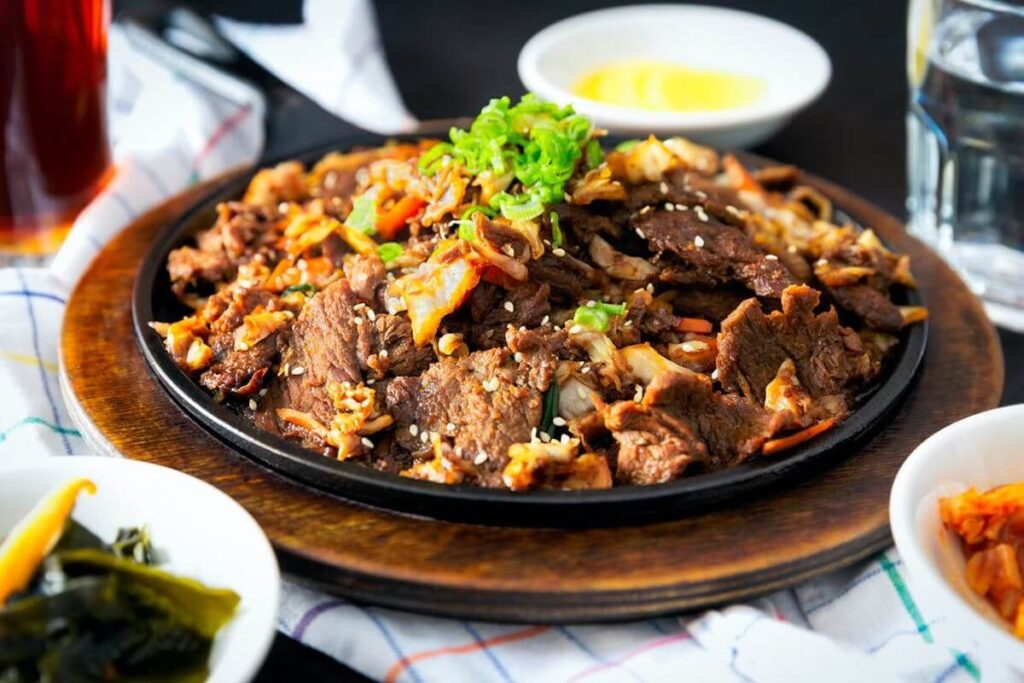
This dish of thinly sliced marinated beef is one of the known symbols of Korea. Bulgogi , which translates to “fire meat”), is so popular that it was among the 26 Korean words added to the Oxford English Dictionary’s (OED) September 2021 update .
Bulgogi has a centuries-old history in Korea. This sweet and spicy dish is one of the oldest traditional Korean foods with roots in the Goguryeo era (37 BC–668 AD).
Traditional bulgogi is grilled, barbecue-style, to give it a smoky, rich meaty taste. However, stir-fried bulgogi is also popular, especially for cooking at home.
You can enjoy this dish on its own or with rice and banchan (side dishes) but Koreans typically wrap the freshly cooked meat in lettuce leaves to make ssam . Add extras like garlic, kimchi, and gochujang (Korean pepper paste), then shove the whole thing into your mouth. Yum!
2. Bibimbap

No trip to the rice-loving nation of Korea is complete without a taste of bibimbap , one of the best-tasting and best-looking traditional Korean foods.
Bibimbap is a composite of the Korean words bibim (mix) and bap (rice). A bowl of white rice is topped (and later on, mixed) with seasoned vegetables, meat (typically beef), and gochujang. A raw or fried egg may be added to the mix.
This colorful and nutritious bowl is easy to do at home. But it’s also worth seeking out popular versions of the dish such as the dolsot bibimbap (served in a very hot stone pot) and Jeonju bibimbap (uses rice cooked in beef broth).
3. Dakgalbi

Dakgalbi combines gochujang-marinated chunks of chicken with vegetables such as cabbage, carrots, and sweet potatoes, as well as tteok (rice cake), and spices like gochujang.
In restaurants, it’s typically placed in a large pan and stir-fried at the customer’s table. Sometimes, cheese and noodles are added.
This spicy stir-fried chicken dish is available everywhere in Korea but as with many traditional Korean foods, it’s a local specialty best eaten in the city where it originated — Chuncheon. I had the chance to indulge in Chuncheon dakgalbi when I visited Korea and I have not forgotten it since.

Bossam is a dish of thinly sliced boiled pork (typically shoulder). If you think that’s boring, then think again.
The dish itself sounds simple but it is complemented by an assortment of side dishes: spicy radish salad, raw garlic, ssamjang , salted shrimp, and kimchi. It also comes with vegetables such as lettuce, kkaennip (perilla leaves), and napa cabbage, which can also be used to make a wrap or ssam.
In fact, the ssam in bossam stands for “wrapped” so it’s meant to be enjoyed this way. This is also why bossam is popular as an anju (drinking snack) and yasik (late-night snack).
5. Samgyeopsal

Koreans have always loved roasting meat… except when they turned vegetarian due to the rise of Buddhism. But once meat started making a comeback, there was no stopping it.
Today, Korean barbecue is almost synonymous with samgyeopsal or pork belly. One of the most popular traditional Korean foods, it is thick, juicy, smoky, savory, and generally affordable.
While there’s no denying that this Korean classic is tasty, a huge part of its popularity is because of the culture surrounding it. Eating samgyeopsal is more of a social event than a meal. Grilling and making ssam with friends, clinking your soju-filled glasses — this is the way to enjoy samgyeopsal.
Traditional Korean soups, stews, and porridge
6. samgyetang.
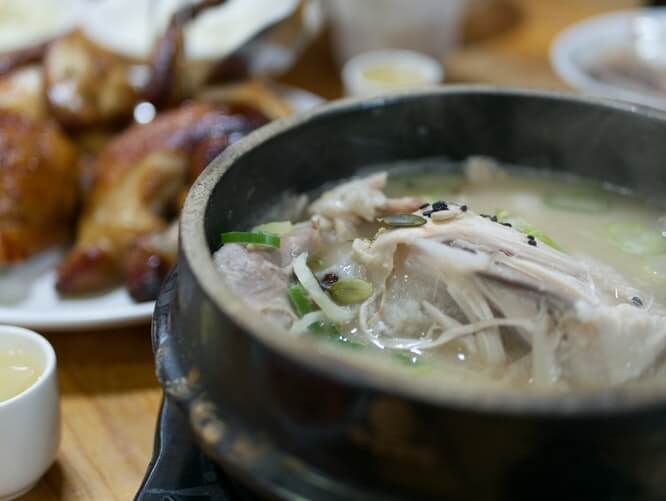
Chicken soup is universally known as soul food. However, traditional Korean foods like samgyetang provide a different kind of healing. This chicken and ginseng soup is used to fight heat with heat in summer.
That doesn’t mean Koreans exclusively eat samgyetang on hot days. This is a nutritious meal of whole chicken packed with rice, garlic, jujube, and ginseng, submerged in an aromatic, hearty broth. I don’t know about you but that sounds like a perfect winter meal to me.
7. Seolleongtang

Dating back to the Joseon dynasty, seolleongtang or ox bone soup is a local delicacy of Seoul. This wholesome soup is made by simmering ox leg bones, brisket, and other cuts and seasonings like pepper, garlic, and chopped spring onions over a low flame for several hours.
The result? A distinct milky white and cloudy soup that’s best enjoyed with rice (sometimes added directly to the soup) and banchan like napa kimchi and kkakdugi (diced radish kimchi).
8. Kimchi jjigae

Not only is the versatile kimchi always present as a banchan; it is also found in many traditional Korean dishes.
Kimchi jjigae or kimchi stew is a great use for leftover or ripe kimchi. Aside from baechu (napa) kimchi, it typically uses tofu, and meat, usually pork, canned tuna, or mackerel. I love cooking this at home because it’s simple yet comforting and filling.
As this one’s spicy and served hot, you’ll want to keep a bowl of plain rice handy.
9. Doenjang jjigae

Another popular jjigae, doenjang jjigae ’s main ingredient is well, doenjang or soybean paste. One of the most iconic traditional Korean foods, it is cooked with tofu. Often, various vegetables like zucchini and green peppers are used. Meat or mushrooms are optional.
Don’t confuse doenjang jjigae with doenjang-guk (soybean paste soup). Although both are classic Korean dishes, jjigae is thicker and has more ingredients than guk. It is also often served as a main dish, while guk is typically a companion to rice.
10. Tteokguk

If tteokguk sounds familiar, that’s probably because it uses the same main ingredient as tteokbokki, a popular Korean snack. Tteokguk or rice cake soup is one of the symbolic traditional Korean foods eaten on New Year’s Day.
The soup consists of rice cake slices, garnished with marinated ground beef, julienned eggs, crushed laver, and sesame oil. Eating this on New Year’s Day is believed to make you a year older and grant good luck.
When and where that tradition originated is unknown but this custom was mentioned in the 1849 book Dongguksesigi so we know it’s an age-old practice!
11. Hobakjuk

Juk or porridge is one of Korea’s oldest foods. It used to be consumed as a traditional Korean breakfast but now, it can be enjoyed any time of the day.
Hobakjuk or pumpkin porridge is one of the known varieties of juk. To prepare, the pumpkin is steamed or boiled and blended with glutinous rice flour. Red beans or kidney beans as well as glutinous rice cake balls may be added.
The result is a viscous, creamy golden porridge that’s sweeter than savory. While it’s often served to recovering patients or the elderly, it’s also a great winter treat.
Traditional Korean noodles
12. japchae.
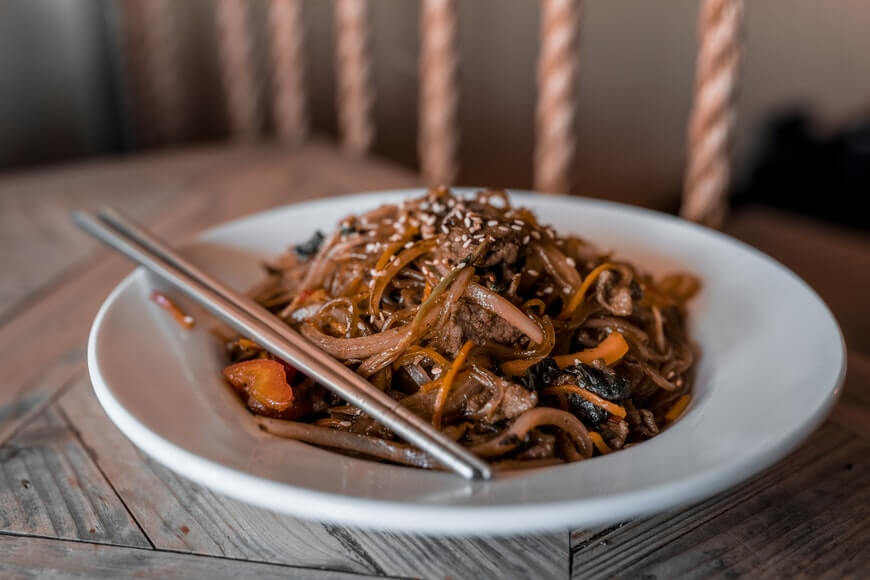
Japchae is a popular stir-fried noodle dish and is one of the most versatile traditional Korean foods.
Also called glass noodles, japchae is eaten on its own, served as banchan, and is a mainstay in special events like birthdays, weddings, and holidays like Seollal (Lunar New Year). It can be enjoyed warm or cold.
Japchae is made by stir-frying glass noodles with various vegetables and meat. Interestingly, the original japchae was part of the Korean royal court cuisine but it had neither noodles nor meat! Joseon’s japchae simply had stir-fried vegetables and mushrooms. Can you imagine?!
13. Kalguksu
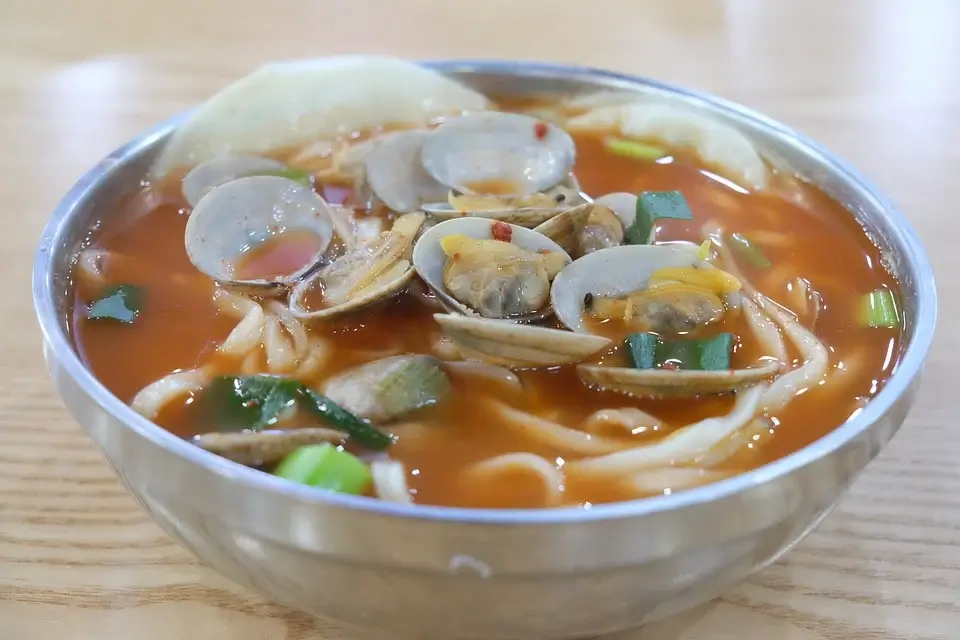
Kalguksu , which translates to ‘knife noodles’, is among the heartiest traditional Korean foods. Its name comes from the chunky wheat flour noodles cut by hand, not extruded or spun.
Kalguksu’s steaming broth is made with anchovy, chicken, or beef stock. Shellfish or meat may be added, along with vegetables like zucchini, potatoes, and scallions. The thick broth goes well with the thick noodles.
Traditional Korean side dishes

No list of traditional Korean foods would be complete without kimchi. Easily the most recognizable Korean icon, this thousand-year-old dish is a staple in Korean kitchens.
Traditional kimchi is called baechu kimchi, which is made by fermenting whole napa cabbage heads. However, there are about 200 types of kimchi and not all of them are red and spicy.
Kimchi not only pairs well with most Korean meals; it’s also a healthy dish, thanks to the healthy bacteria formed during the fermentation process. It’s packed with vitamins, too!
15. Dongchimi

Also called ‘winter kimchi’, dongchimi is one of the traditional Korean foods that are famous in both South and North Korea. Hamgyeong and Pyeongan in North Korea are particularly known for their dongchimi.
This type of kimchi consists of Korean radish, napa cabbage, scallions, pickled green chili, ginger, Korean pear, and water brine. It is traditionally consumed in the winter and makes for a great side dish. It can also be used for making cold noodle soups like dongchimi guksu and naengmyeon.
16. Dotorimuk

Acorns are a favorite dish of some woodland creatures. But did you know that they’re also used in traditional Korean foods?
In Korea, dotorimuk or acorn jelly is a beloved banchan or an ingredient in salads. Owing to the abundance of oak trees in mountainous regions of Korea, the product of tannin-free acorn flour or starch is possible.
The light brown jello is usually served cold and topped with chopped leeks and soy sauce.

A fixture in Korean meals, jeon is a savory (sometimes sweet) fritter made of sliced vegetables, seafood, or meat, coated with flour and egg wash before frying in oil.
The most popular types of jeon include pajeon (made with spring onions or scallions), haemul pajeon (seafood with spring onions), and gamjajeon (made of potatoes). Hwajeon is a dessert type of jeon as it contains honey and edible flowers.
Jeon is typically consumed as an appetizer or banchan. But it also makes for a good anju and pairs well with makgeolli (traditional rice wine).
Traditional Korean street foods, desserts, and snacks

Kimbap has to be one of the most all-rounded traditional Korean foods.
This simple rice roll filled with vegetables and meat is delicious and filling so you can have it as a snack or as a complete meal in itself. It’s common in picnics and hikes as well.
Fried egg, kimchi, luncheon meat, pork, tuna, and cheese are some of the more common fillings of kimbap. While fillings may vary, two ingredients remain constant: the rice and kim or dried sheets of seaweed.
19. Injeolmi

The idea of rice cake in itself is already stranger for Westerners. But add bean powder to the mix and it sounds even weirder.
And yet, injeolmi or rice cake rolled in bean powder is one of the popular traditional Korean foods. It is made by steaming glutinous rice flour and pounding it until it becomes very sticky.
It is then cut into small bite-size pieces and rolled in bean powder. Soft and chewy, it makes for a snack. It is also often used in desserts like injeolmi patbingsu , injeolmi croffle , and injeolmi cream buns .

Korea’s sundae is nowhere close to looking like sweet ice cream. In fact, it makes many people queasy at first.
A type of blood sausage, sundae is made by steaming cow or pig’s intestines stuffed with rice, vegetables, glass noodles, and other ingredients. It may not sound particularly appetizing but it’s a popular and cheap street food that has been around since the Goryeo period (918–1392).
Sundae is typically dipped into salt and pairs well with a cold beer.
21. Bindaetteok

One look at bindaetteok or mung bean pancake might fool you into thinking that it’s a jeon. However, traditional bindaetteok doesn’t include eggs and flour, two of the most common ingredients in jeon.
This golden savory traditional Korean street food is made by grinding soaked mung beans and adding vegetables, meat, and kimchi into the batter. It is pan-fried into a round, flat shape.
It is said that richer households in Joseon used to distribute bindaetteok to poorer citizens during times of hardship. Today, the best bindaetteok can be found in traditional markets.

Mandu or filled dumplings that may be steamed ( jjin mandu) , grilled or fried ( gun-mandu) , or boiled ( mul mandu ). Ground pork or beef are the most common fillings but vegetarian and vegan options are also available.
Traditionally, mandu was part of the Korean royal court cuisine. Now, it’s served as an appetizer, side dish, or as the main meal by itself. It is most popular as a snack, however, and can be bought in supermarkets, convenience stores, restaurants, or in street stalls.
23. Hotteok

Koreans sure love their pancakes. Besides traditional Korean foods like jeon and bindaetteok, hotteok or sugar-filled pancakes are also popular.
Hotteok is closer to the pancakes we’re familiar with. A flour batter is rolled into a ball and filled with crushed peanuts, brown sugar, and cinnamon. Then, it’s pan-fried and gradually flattened with a round metal utensil.
Tasty, filling, and cheap, hotteok is a favorite street food of many. It’s especially popular during the cold winter months.

Another favorite of mine, yakgwa or fried honey cookies is a traditional Korean cookie.
Flour, honey, sesame oil, and wine are used to create the magic that is this sweet and soft cookie. These ingredients are kneaded into a dough, pressed into a cookie mold, or cut into squares, before being fried then dipped in honey.
Traditional, this Korean confection was offered in a jesa or ancestral rites. Like many traditional Korean foods, yakgwa is also consumed on festive holidays such as Chuseok (Korean Thanksgiving Day) .
On regular days, however, you can simply enjoy it as a dessert or snack. It makes for a great food souvenir, too!
25. Songpyeon

Songpyeon, half-moon-shaped rice cakes, are also Chuseok favorites. Chuseok is a major harvest festival in Korea and as a way to celebrate the bountiful harvest, traditional Korean foods such as songpyeon are eaten.
Korean families use to make songpyeon with freshly harvested rice which is powdered and made into a batter by adding saltwater. The batter is shaped into small half-moons and filled with various sweet or semi-sweet fillings such as sesame, chestnuts, dates, honey, or red beans.
Songpyeon, which translates to ‘pine cakes’, is steamed over a layer of pine noodles. This is where it gets its distinct taste and smell.

There you have it! This list of traditional Korean foods should be enough reason to visit South Korea. And when you do, you can try more traditional Korean dishes that didn’t make this list.
Before making the trip, I suggest preparing by checking out these facts about Korean food and basic Korean dining etiquette . Reading up on Korea’s unique culture and lifestyle would be helpful, too!
Leave a Comment Cancel reply
Save my name, email, and website in this browser for the next time I comment.

© 2024 Hey Explorer
Stock images by Depositphotos
Russia-Ukraine war latest: Putin 'may launch all-out bid to seize second city' - as Western officials fear major Russian advance
Russia has launched fresh strikes on critical infrastructure - with Kyiv residents told to cut energy consumption every night for the rest of 2024. Meanwhile, Western officials reportedly fear a major Russian advance - amid concerns Vladimir Putin could launch an attempt to seize Kharkiv.
Saturday 13 April 2024 00:54, UK
- Ukrainian defences 'at risk of collapse' as officials fear major Russian advance - and all-out assault to seize second city
- Russia hits critical infrastructure in overnight missile strikes
- Putin mocks peace conference
- The big picture : Everything you need to know about the war this week
- Your questions answered: Is it too late to save Ukraine?
We'll be back tomorrow morning with more updates on the war in Ukraine.
Two Biden administration officials have revealed the extent of China's involvement in Russia's war on Ukraine.
The officials spoke to Reuters news agency and said China has massively increased its sales to Russia of machine tools, microelectronics and other technology to Moscow.
These items are important because Russia is using them to make tanks, aircraft, missiles and other weapons for the war.
They also said:
- About 90% of Russia's microelectronics came from China
- Nearly 70% of Russia's approximately $900m in machine tool imports in the last quarter of last year came from China
- Chinese and Russian entities have been working together to make drones in Russia
- China is helping Russia improve its satellite and other space-based capabilities for use in the war. This could increase the threat Russia poses across Europe
US President Joe Biden has previously raised concerns with Chinese President Xi Jinping about Beijing's indirect involvement in the war.
US Treasury Secretary Janet Yellen returned this week from a visit to Beijing and said she had warned China that the Biden administration was prepared to sanction Chinese banks, companies and Beijing's leadership if they helped Russia's military in the war.
She has already been given the go-ahead from Mr Biden to sanction financial institutions that help Russia's military-industrial complex.
US Secretary of State Antony Blinken is due to travel to China for talks next month.
Russia, increasingly isolated economically and diplomatically, has become more reliant on China in recent months.
One official said Chinese materials are helping Moscow undertake its "most ambitious defence expansion since the Soviet era and on a faster timeline than we believed possible early on in this conflict".
"Our view is that one of the most game-changing moves available to us at this time to support Ukraine is to persuade the PRC (China) to stop helping Russia reconstitute its military industrial base. Russia would struggle to sustain its war effort without PRC input," the official said.
Chinese Embassy spokesperson Liu Pengyu told Reuters that Beijing has not provided weapons to any party and that it is "not a producer of or party involved in the Ukraine crisis".
"We urge the US side to refrain from disparaging and scapegoating the normal relationship between China and Russia."
If Russia defeats Ukraine it will be a "turning point in history", former UK prime minister Boris Johnson says.
Writing in the Daily Mail, he criticised Western countries for not providing Ukraine with the weapons it needs to defeat Russia.
"Every week in which we fail to do the obvious — and give the Ukrainians the weapons they need — is a week in which Putin gets closer to his disgusting ambition, to torture a European country to death.
"Every day the pressure on the Ukrainians is growing — and yet the solution is within our grasp."
Mr Johnson, who visited Ukraine a number of times during his premiership, said: "A defeat for Ukraine would usher in a new era of fear in the whole Euro-Atlantic area, as Putin continues his drive to rebuild the Soviet empire: from the Baltics to Georgia to Moldova to Central Asia to the Arctic.
"It will be a terrifying moment for the people of Taiwan and the clearest possible signal to China that the West has lost the willpower to protect democracy.
"It will be a turning point in history, the moment when the West finally loses its post-war hegemony, the moment when borders everywhere are suddenly up for grabs and aggression is seen to pay — and all because of a failure to stand up for Ukraine."
Mr Johnson warned the world is "on a knife-edge, with a real risk that Western democracies are about to be humiliated, and autocracies emboldened around the world — because of our lassitude, our pathetic refusal to do what is necessary".
He said Ukraine is so short of shells that its troops sometimes have to wait under Russian bombardment because they can't fire back.
The shortage of air defences means Kharkiv, the second-largest city, is "in danger of being turned into another Mariupol", he added.
Ukrainians were able to intercept 90% of incoming strikes, he said, but now "we are starving them, for reasons I do not understand, of the protective shields they need".
Mr Johnson called on the US Congress to approve a $60bn military aid package earmarked for Ukraine and on the Germans to supply Taurus missiles.
The West - including Britain - needs to "snap out of our sleep-walk", he said, adding: "The simplest and most cost-effective way to defend freedom is to invest now in the defence of Ukraine."
Rescue workers in Ukraine have saved five puppies from under the debris of a destroyed building.
The non-residential building was on fire in the north-eastern city of Sumy, close to the border with Russia.
A video from the State Emergency Service of Ukraine showed the firefighters cuddling the squealing puppies and rinsing them off with water.
In a post of the emergency service's Telegram channel, officials said the "little ones" were not injured.
"This rescue story reminds us of the importance of human compassion and the willingness to help everyone, regardless of the circumstances," they added.
Ex-armed forces minister James Heappey has told Sky's defence and security editor Deborah Haynes the UK should consider sending its forces to Ukraine to train troops.
On the Sky News Daily, host Tom Cheshire talks to her and Sky's military analyst Professor Michael Clarke about the interview with Mr Heappey, who stepped down from his role last month.
They assess the bleak situation in Ukraine and why the conflict is at a critical stage. They also discuss how prepared the UK would be if it faced a war in the near future.
A former Ukrainian secret service employee has been injured in Moscow after a device under his car exploded.
Vasily Prozorov suffered leg injuries that are not considered life threatening after the device detonated as he tried to start his car, Radio Free Europe cited Russian media as saying.
According to RFE, Mr Prozorov worked for Ukraine's SBU until 2018.
The following year, he told media in Moscow that he had collaborated with Russia "for ideological reasons" from April 2014 until he left the SBU.
These photos show the damage to a thermal power plant in Kharkiv, eastern Ukraine.
A massive missile and drone attack destroyed and damaged a number of power plants across Ukraine overnight, part of a renewed Russian campaign targeting energy infrastructure.
The Trypilska plant, which was the biggest energy supplier for the Kyiv, Cherkasy and Zhytomyr regions, was struck numerous times, destroying the transformer, turbines and generators.
Vladimir Putin said the attacks were a response to Ukrainian strikes that targeted Russian oil refineries.
In Kharkiv, there were at least 10 other strikes on energy infrastructure, resulting in damage like that seen in these photos.
Ukraine's foreign minister Dmytro Kuleba said more than 200,000 people in the region were without power.
Herman Halushchenko, its energy minister, said it was a "large scale, enormous, missile attack that affected our energy sector very badly".
More details have emerged about American Russell Bentley, who is missing in the Russian-controlled Donetsk region in eastern Ukraine.
Online news outlet Mash said he disappeared on 8 April after a district in the city of Donetsk was shelled by Ukrainian forces.
Mash cited his wife as saying he had gone to see if anyone needed help but had not returned.
Mr Bentley joined pro-Russian fighters in eastern Ukraine in 2014.
According to Russian news outlet RIA, he later swapped his gun for journalism and worked with state-run news outlet Sputnik.
In a 2022 Rolling Stone interview, he came across as a conspiracy theorist (he said the collapse of the World Trade Towers was a "pre-planned controlled demolition") and a fan of dictators (he described war crimes-accused former Libyan leader Muammar Gadhafi as "one of the greatest").
He became a citizen of the Donetsk People's Republic in 2017 and a citizen of Russia in 2020, said the interview, which was headlined The Bizarre Story Of How A Hardcore Texas Leftist Became A Frontline Putin Propagandist.
In words similar to those of Russia's president Vladimir Putin, Mr Bentley described the Ukrainian military as "genuine mass-murdering Nazis", also claiming their ranks were swelled by "thousands of ISIS cannibals" - claims that have been widely dismissed by commentators.
The Netherlands will provide Ukraine with an additional €1bn (£850m) in military support this year, and has earmarked three-times that amount for next year.
Dutch Prime Minister Mark Rutte delivered the news in a social media post.
The extra support in 2024 takes the total sum for this year to €3bn (£2.56bn), along with €400m (£340m) to support Ukraine's economy, Mr Rutte said.
"Ukraine must win this battle - for their and our safety," he said.
Dozens of Russian military instructors have arrived in the African country of Niger.
The move is part of a new agreement with Niger's leaders, who recently cut ties with the West.
The Tele Sahel broadcaster showed footage of a Russian transport plane arriving at Niamey airport on Wednesday night.
It said Russia would help to "install an air defence system... to ensure complete control of our airspace", according to comments reported by news agency AFP.
The Russian military instructors are from African Corps, the Russian defence ministry's paramilitary group. They are also seen as the successor to the Wagner mercenary group in the continent.
Niger's elected president Mohamed Bazoum was overthrown last year by the junta and they cut military and diplomatic ties with former colonial power France, as well as ending an agreement with the US.
Niger has been struggling with increased violence from Islamic State and it is also concerned about Boko Haram militants along its border with Nigeria.
According to the Council of Foreign Relations, Russia's growing influence in Africa has come as some African countries are frustrated with the failures of Western intervention and resentful over their own lack of representation in international institutions.
The CFR says Russia is trying to "gain more support for its vision of a multi-polar world order based on weakened Western influence". We have seen Moscow lobby African countries for support in the United Nations on votes regarding the Ukraine conflict, for example.
Russia is also interested in Africa's vast natural resources (including gold, diamonds, uranium and oil), but it is far from an economic powerhouse in the continent - less than 1% of its foreign direct investment goes there.
Be the first to get Breaking News
Install the Sky News app for free

- Vacation Rentals
- Restaurants
- Things to do
- Moscow Tourism
- Moscow Hotels
- Moscow Bed and Breakfast
- Moscow Vacation Rentals
- Flights to Moscow
- Moscow Restaurants
- Things to Do in Moscow
- Moscow Travel Forum
- Moscow Photos
- All Moscow Hotels
- Moscow Hotel Deals
- Moscow Motels
- Moscow Hostels
- Moscow Campgrounds
- Moscow Business Hotels
- Moscow Spa Resorts
- Moscow Family Hotels
- Moscow Luxury Hotels
- Romantic Hotels in Moscow
- Moscow Green Hotels
- Moscow Ski-In / Ski-Out Hotels
- Moscow Resorts
- 5-stars Hotels in Moscow
- 4-stars Hotels in Moscow
- 3-stars Hotels in Moscow
- Novotel Hotels in Moscow
- Crowne Plaza Hotels in Moscow
- Rotana Hotels in Moscow
- Accor Hotels in Moscow
- InterContinental (IHG) Hotels in Moscow
- Radisson Hotels in Moscow
- Hilton Hotels in Moscow
- Holiday Inns in Moscow
- ibis Hotels in Moscow
- Radisson Blu Hotels in Moscow
- Hampton by Hilton Hotels in Moscow
- AZIMUT Hotels in Moscow
- Moscow Hotels with Pools
- Pet Friendly Hotels in Moscow
- Moscow Hotels with Free Parking
- 3rd Transport Ring (TTK) Hotels
- District Central (TsAO) Hotels
- Garden Ring Hotels
- Boulevard Ring Hotels
- Tverskoy Hotels
- Red Square & Kitay-gorod Hotels
- Zamoskvorechye Hotels
- Meshchanskiy Hotels
- Presnensky Hotels
- District Eastern (VAO) Hotels
- Cheap Accommodations in Moscow
- Boutique Hotels in Moscow
- Heritage Hotels in Moscow
- Hotels with Nightclubs in Moscow
- Moscow Downtown Hotels
- Moscow Modern Hotels
- Moscow Hotels with Kitchenette
- Moscow Clean Hotels
- Moscow Hotels with Hot Tubs
- Quiet Hotels in Moscow
- Hotels near Red Square
- Hotels near Moscow Metro
- Hotels near Saint Basil's Cathedral
- Hotels near Moscow Kremlin
- Hotels near High-Speed Train Sapsan
- Hotels near GUM
- Hotels near State Tretyakov Gallery
- Hotels near Tsaritsyno Museum-Reserve
- Hotels near Armoury Chamber
- Hotels near Bolshoi Theatre
- Hotels near Kremlin Walls and Towers
- Hotels near Gorky Central Park of Culture and Leisure
- Hotels near Kolomenskoye Historical and Architectural Museum and Reserve
- Hotels near PANORAMA360
- Hotels near (ZIA) Zhukovsky International Airport
- Hotels near (VKO) Vnukovo Airport
- Hotels near (DME) Domodedovo Airport
- Excellence Punta Cana
- Hotel Riu Palace Cabo San Lucas
- Ibludan Hotel
- Dreams Jade Resort & Spa
- Luxor Hotel & Casino
- Disney's Caribbean Beach Resort
- Wyndham Alltra Cancun
- Renaissance Wind Creek Aruba Resort
- The Westin Reserva Conchal, an All-Inclusive Golf Resort & Spa
- Beaches Turks & Caicos
- Excellence Oyster Bay
- Dreams Flora Resort & Spa
- Royalton Splash Riviera Cancun, An Autograph Collection All-Inclusive Resort
- Royalton Riviera Cancun
- Aruba Ocean Villas
- Popular All-Inclusive Resorts
- Popular Beach Resorts
- Popular Family Resorts
- Popular All-Inclusive Hotels
- Popular Hotels With Waterparks
- Popular Honeymoon Resorts
- Popular Luxury Resorts
- Popular All-Inclusive Family Resorts
- Popular Golf Resorts
- Popular Spa Resorts
- Popular Cheap Resorts
- All Moscow Restaurants
- Restaurants near Hite
- Cafés in Moscow
- European Restaurants with Buffet in Moscow
- Fast Food Restaurants in Moscow
- Italian Restaurants in Moscow
- Japanese Restaurants in Moscow
- Late Night Eastern European Restaurants in Moscow
- Mediterranean Restaurants in Moscow
- Pizza in Moscow
- Romantic German Restaurants in Moscow
- Russian Restaurants in Moscow
- Seafood Restaurants in Moscow
- Vegan Restaurants in Moscow
- Vegetarian Restaurants in Moscow
- Best Burritos in Moscow
- Best Salad in Moscow
- Best Noodle in Moscow
- Best Pancakes in Moscow
- Best Salmon in Moscow
- Best Tortellini in Moscow
- Best Focaccia in Moscow
- Best Juice & Smoothies in Moscow
- Best Donuts in Moscow
- Best Gelato in Moscow
- Best Risotto in Moscow
- Best Catfish in Moscow
- Best Bibimbap in Moscow
- Best Chicken Kiev in Moscow
- Best Peking Duck in Moscow
- Breakfast Restaurants in Moscow
- Lunch Restaurants in Moscow
- Dinner Restaurants in Moscow
- Bakeries in Moscow
- Buffet Restaurants in Moscow
- Coffee & Tea in Moscow
- Desserts in Moscow
- Food Delivery Restaurants in Moscow
- Kid Friendly Restaurants in Moscow
- Late Night Restaurants in Moscow
- Restaurants for Special Occasions in Moscow
- Restaurants with Outdoor Seating in Moscow
- Romantic Restaurants in Moscow
- Arbat Restaurants
- Bars & Pubs in Tverskaya
- Basmanny Restaurants
- Brunch Restaurants in Red Square & Kitay-gorod
- Eastern European Restaurants with Delivery in Arbat
- Hamburgers in Tverskaya
- Khamovniki Restaurants
- Maryina Roshcha (Jewish Quarter) Restaurants
- Patriarch Ponds Restaurants
- Presnensky Restaurants
- Red Square & Kitay-gorod Restaurants
- Seafood Restaurants in Arbat
- Tverskaya Restaurants
- Yakimanka Restaurants
- Zamoskvorechye Restaurants
- GreenLeaders
- Things to Do
- Travel Stories
- Rental Cars
- Add a Place
- Travel Forum
- Travelers' Choice
- Help Center
- Europe
- Russia
- Central Russia
- Moscow
- Moscow Restaurants
Ratings and reviews
Location and contact.
Stayed at Wigan town centre premier Inn as a little getaway. Lovely clean hotel, staff friendly and helpful. Breakfast in the morning was good, really good value for money. The morning was made even better with Kath's charm . Would definitely recommend to anyone, and... will be staying again More
The place is not bad. No empty tables indicated its popularity and the quality of meat explains it completely. I am not a big fan of Korean food but i should say that the meat is definately worth trying. And the cooking process is fun... too. They bring you coals right to the middle of the table and then you grill your own meat. Despite the quality of meat and experience of cooking, I wouldn't give this place 5 stars - service is not very friedly, other dishes are nothing special. They say it is the #1 Korean place in Russia - maybe. But if you are not particularly a fan of this cuisine, try to stay with the most traditional food and meat is a great option. And no decent desserts too. See photos made with Relonch camera to get a better impression. More

Real Korean BBQ restaurant in Moscow. High quality meat and genuine dishes. Clean interior. Highly recommend if you have taste for high quality Asian food
Nice interior, Staff also nice. But the food we ordered disappointing. Bulgogi very very sweet and boiled not grilled. Dumplings falling apart because seriously overcooked. Maybe we just chose the wrong food. More
Good afternoon! Thank you for your feedback. We really appreciate that you have chosen our restaurant and sharing your experience. Your comments have already been forwarded to the restaurant manager and chef. We promise to strengthen control over the quality of food. We really hope... More
This is brand new in everything: newly opened and quite an experience for those, who are freshers in Korean eating tradition. What's good: 1) food taste and quality; 2) quickness and quality of service; 3) friendliness and efficiency of waiters; 4) the amount of spicies... in food is adjusted to every eater personally. What's to be made better: 1) wine list does not leave too much of the choice, though the wines are good; 2) almost no desserts, but for "imported" cheesecakes. More
Very nice place with great food. We visited this place twice in a week when we were in Moscow last year. Will visit it again this year. Quality food and value for money.
Hello, Vasilis! Thank you for your feedback and look forward to seeing you again!
To meet my Moscow friends. its nice nice place. Breakfast before an interesting day Not wow! but good to visit. Normally.. The food is original and tasty. It was decent
One of the best abroad Korean restaurants. The place was full packed with customers. The barberque was amazingly tasty, enjoyed every bit of it. The BBQ beef rib, pork and eel were absolutely fabulous. I tried the Korean red wine. It was very sweet, would... like it to be a bit more dry. Service was as quick as it could be. Totally satisfied. Recommend this place for all locals and tourists. More

went there for dinner. the place iwas o crowded which means business good. nice ambience and the foods yummy..
We had a table for seven in occasion of a birthday and reserved a private room. The atmosphere is really nice. At the beginning the private room looks isolated but soon after it becomes the perfect environment to simply enjoy your meal without the see... and be seen game in the usual restaurant room. Well i cannot hide, i did not even had to look at the menu that i ordered Chap Chai. The best i have eaten so far in Moscow. Wet enough, not overcooked, rich in ingredients and simply filled with umami! Simply go for it...simply recommended. We tried some spicy food after, some ribs and some shrimps and i have to say this disappointed me a little. They used a lot of pepper instead of chili and really not a lot it either. Very localized "spicy". And we ordered spicy, not medium or mild. The ladies who were not into spicy ordered a simple chicken teriyaki and yes nice but not as good as the chap chai. At the end not satisfied with all of the above, we had some grilled meat. The experience of the center BBQ, is always a great entertainment, for you and for your guests. Highly recommended! WE tried beef and pork! Really nice and juicy! I can highly recommend also the grilled meat on the BBQ. The bill was relatively high, but looking at the drinks we had and the number of people we were i think it was reasonable. The whole table stood up satisfied and filled with Korean flavory food. The ready dishes did not meet the expectations, as i said maybe too localized... but we will definitely go back for some more chap chai and grilled meet. More
This is really delicious oriental cuisine and the price is reasonable. Moreover, the staff members are really nice.
This restaurant provides very stable quality food. However, the place provides a very simple feeling of a canteen. Good for a lunch. Or for a Korean meal experience. However, some other Korean restaurants in Moscow carry more authentic spirit.
After spending a lot of time in Korea, one gets accustomed to their ways of the BBQ with all its delectable condiments and fatty portions of prime meat. A great find when we stumbled across Hite here our on trip to Moscow. A vast menu... of great Korean food is on offer. The bbq is for us the only option. Washed down with a couple bottles of Soju and Hite and the evening was great! Service quick & friendly.. The meat by the 200g portion, was probably the only downside as 4 hungry men we polished of 6 plates with ease. For a great taste of Korea in Moscow try one of the Hite restaurants.. They web deliver if your legs fail you to walk... More

Very big portions. Loved the soups and that it felt genuine spicy Korean kitchen. You even saw Koreans visiting. Great value. Recommended!

The food taste good! And you get a lot of it. They are also various choice of food to choose to. Definitely recommend to go and try :)

HITE, Moscow - 1905 Goda st. 2/1, Presnensky - Menu & Prices - Tripadvisor
- Service: 4.5

IMAGES
VIDEO
COMMENTS
8. Private Tongdosa Temple Tour including Gourmet Eonyang Style Bulgogi Lunch. 2. Food & Drink. 4-5 hours. Tongdosa temple is one of my favorite temple in Korea because it is 1,400 years old and you can feel the age of the temple…. Free cancellation. from. $299.
🇰🇷 5 Best Korean Foods: : https://youtu.be/wftv9ZjZk7g?si=0nUE7w8ussF2GPG7 👕 T-shirts: https://store.migrationology.com/ 🌶 Ghost Chili: https://amzn.to/...
23. Gimbap (김밥) Imagine sushi but in a bigger format and filled with more ingredients and different types of ingredients. Gimbap is a dried seaweed roll with white rice and various ingredients such as spinach, pickled radish, carrot, egg, burdock, etc., and cuts into bite-sized pieces. 24.
Feast on all the iconic foods of South Korea, including Korean fried chicken, bibimbap, japchae, kimbap, a seafood BBQ and of course, Korean BBQ. By travelling on this trip, you'll directly support our Intrepid Foundation partner, Eden Reforestation Projects. Donations help them provide local employment opportunities and tackle climate change ...
For your trip to South Korea, we've compiled a list of 19 delicious must-try foods to give your tastebuds a treat. This includes gimbap, bulgogi, tteokbokki, japchae and many more. In this article, we will guide you through the best of Korean cuisine that you can easily find on streets and in restaurants. Plus, we'll let you know exactly ...
Naengmyeon (cold buckwheat noodles) Naengmyeon is a common cold Korean noodle dish that consists of long, thin noodles, cucumbers, slices of Korean pear, slices of beef and a hard-boiled egg. The noodles are often made of buckwheat, potatoes, and sweet potatoes, but can also be made of arrowroot and kudzu, depending on the type of naengmyeon.
Chat with a local specialist who can help organize your trip. Get Started. Discover how to eat like a local in South Korea on this five-day food tour of Seoul and Busan. Touch down in the pulsing capital, Seoul, where you'll visit royal palaces and learn to make classic Korean dishes during a cooking class with a local chef.
The fish meat is boiled again with beef or chicken broth and seasoned with gochujang, doenjang, grated ginger, and ground black pepper before being served in a soup with vegetables, mushroom, fried tofu, rice, and noodles. 7. Ganjang Gejang. Many Koreans have described ganjang gejang as the ultimate South Korean food.
Korean seafood: fresh raw fish wraps, live octopus and bubbling stews. No, Korean raw fish is not sashimi or sushi; it's hwae (회). Koreans want food as fresh as possible. They want live fish killed immediately and then sliced before their very eyes. This fish has a very clean, chewy and fatty flavor that is best wrapped in a fresh leaf and ...
As we embark on this culinary journey, we'll uncover the ultimate foodie's guide to Korean cuisine and street food delights that are not to be missed in 2023. 1. Tteokbokki: The Spicy Staple. No foodie trips to South Korea 2023 would be complete without indulging in the spicy, chewy goodness of Tteokbokki. These rice cakes are simmered in a ...
8) Samgyetang 삼계탕 — Ginseng Chicken Soup. 9) Chicken and Beer (Chimaek 치맥) 10) Budae Jjigae 부대찌개 — Army Stew. 11) Bingsu 빙수 — Shaved Ice Dessert. 12) Bibimbap 비빔밥 — Korean Rice Bowl. 13) Pancakes (Jeon 전) 14) Traditional Korean Tea and Dessert. 15) Jeju Green Tea and Giant Pastries at Starbucks.
These tours are great for a traveler doing a city break in Seoul or just stopping through. If you have more time, and really want to learn more about Korean food, consider booking a South Korea food tour. Intrepid Travel offers an 8 Day South Korea Real Food Adventure. This tour is a Korean food trip that explores Seoul as well as Busan and Jeonju.
Easy-to-make kimchi Mak-kimchi 막김치. A traditional, simpler, & faster way to make classic kimchi, done by chopping the cabbage in the beginning. Spicy, fermented, and delicious, it's a great side dish for any meal! Delicious Korean home cooking recipes, videos, photos, cookbooks, and blog.
Also I recommend getting dolsot bibimbap (돌솥비빔밥), which is when it comes in a nice hot stone bowl. 3. Boribap (보리밥) Here's one of the best Korean food dishes for you vegetarians! It's basically rice, barley, and a bunch of veggies with some sort of sauce. I've only had it once on my Jogyesan hike.
1: Chuncheon Dakgalbi - Spicy Stir Fried Chicken. Chuncheon dakgalbi is another of those traditional Korean dishes for those people who love fried meat. This dish combines marinated chicken with vegetables, rice cake (tteok 떡 ), chilli paste sauce, and other spices. You can also add noodles and cheese.
The nation's six-largest city was home to an enormous and transformative pro-democracy uprising in the 1980s. This uprising was captured amazingly in the fantastic Korean film A Taxi Driver. Today, the legacy of that uprising, which changed the future of South Korea, can be seen in Gwangju's 5.18 Memorial Park.
12. Japchae. Japchae is a popular stir-fried noodle dish and is one of the most versatile traditional Korean foods. Also called glass noodles, japchae is eaten on its own, served as banchan, and is a mainstay in special events like birthdays, weddings, and holidays like Seollal (Lunar New Year).
Korean Street Food | Street Food in Seoul | Gwangjang MarketSo PUMPED to be in Seoul, South Korea for a MASSIVE Street Food tour! We spent 7 days feasting on...
3. Han Chu Korean Fried Chicken & Beer. We love chimaek restaurants and Han Chu is frequently listed as one of the best restaurants in Seoul for Korean fried chicken. Chimaek is a compound word for chi-cken and maek-ju, the Korean word for "beer", so it refers to the popular duo of Korean fried chicken and beer.
North Korean food is markedly less spicy than South Korean, but tasty enough. The best is... the propaganda video playing throughout. Definitely worth a visit. More. Date of visit: September 2016. Helpful? This review is the subjective opinion of a Tripadvisor member and not of Tripadvisor LLC. Tripadvisor performs checks on reviews as part of ...
Delicious korean food, secret tip! 6. [KU:] Ramen Izakaya Bar. 174 reviews Open ... We enjoyed all Uzbek food from salad to Plov and kebabs. Favourite was the veal... Very good place for Uzbek dishes. 27. MarketPlace. 267 reviews Closed Today. Italian, Seafood $$ - $$$ Menu.
4. Pho Fighters. 126 reviews Closed Now. Asian, Thai $$ - $$$. the place located in the heart of Moscow is amazing for big companies of... Hot Soup in Cold Day. 5. Kimchi. 308 reviews Open Now.
Russia has launched fresh strikes on critical infrastructure - with Kyiv residents told to cut energy consumption every night for the rest of 2024. Meanwhile, Western officials reportedly fear a ...
China's highest-level visit in nearly five years comes as North Korea aims to strengthen ties with Beijing and Moscow amid coordination between US and its neighbors.
Share. 217 reviews #445 of 10,704 Restaurants in Moscow $$ - $$$ Barbecue Asian Korean. 1905 Goda st., 2/1, Moscow 123022 Russia +7 495 150-06-55 Website. Closed now : See all hours. Improve this listing.